The Journey of the Ark of the Covenant
In 1–2 samuel.


Journey of the Ark
This map traces the journey of the Ark of the Covenant from the Tabernacle in Shiloh to the City of David in Jerusalem, as described in I Samuel 4:1-7:2 and II Samuel 6:2-17.
- Shiloh was the home of the Mishkan (Tabernacle) for 369 years. After losing a battle to the Philistines, the Children of Israel take the Ark of the Covenant from the Mishkan in Shiloh to the battlefield, hoping that the Ark’s presence would protect them (I Samuel 4:3-4) .
- Even Ha-Ezer is where the Israelites set up camp for their battle against the Philistines (I Samuel 4:1) . The Ark is brought from Shiloh to Even Ha-Ezer, where it is captured (I Samuel 4:11) .
- After defeating the Israelites and capturing the Ark, the Philistines bring the Ark from Even Ha-Ezer to the Philistine city of Ashdod, where they place it in the temple of their god, Dagon (I Samuel 5:1-2) . As a result, the statue of Dagon collapses and God sends a plague upon the people of Ashdod (I Samuel 5:3-7) .
- The Ark is moved from Ashdod to the Philistine city of Gat (I Samuel 5:8) , where the people of Gat also suffer from the godly plague (I Samuel 5:9) .
- From Gat, the Ark is brought to the Philistine city of Ekron . The people of Ekron also suffer and demand that the Ark be sent back to Israel (I Samuel 5:10-11) .
- Fearing death, the Philistines send the Ark back to Israelite city of Bet Shemesh (I Samuel 6:11-12) . The people of Bet Shemesh rejoice over the Ark but are punished for gazing at it (I Samuel 6:19-21) .
- The people of Bet Shemesh send for the inhabitants of Kiryat Ye’arim to take the Ark. It is brought to the house of Avinadav in Kiryat Ye’arim where it remains for 20 years (I Samuel 6:21-7:2) .
- After capturing the city of Jerusalem from the Jebusites, King David establishes it as the political and spiritual capital of his kingdom. He sends for the Ark at the house of Avinadav in Kiryat Ye’arim. Though it is placed in the home of Oved Edom the Gittite for three months, it eventually reaches its ultimate destination (II Samuel 6:2-17) .
Find out more about the Ark of the Covenant and Where is the Ark of the Covenant Today?
Sign up to receive daily inspiration to your email

Help Us Spread the Hebrew Bible's Teachings!
The Israel Bible is the world’s first Tanakh (Hebrew Bible) centered around the Land of Israel, the People of Israel, and the dynamic relationship between them.
- Bible Study
- Biblical Themes
- Bible Basics
- Weekly Portion
- Jewish Calendar
- My Hebrew Name
- My Hebrew Birthday
- Biblical Maps
- Ask the Rabbi
- Alphabet Chart

- Hebrew Roots
- Bible Portions
- hebrew Alphabet
- Roots of Modern Israel
- All Bible Maps
- Heart Messages
- Roman Roads
- Archaeology
The Ark of the Covenant
Ark of the Covenant Summary PDF (276 KB), Quick Summary Slideshow , Interesting Facts
Quick Overview of the Ark of the Covenant
The Ark of the Covenant was a physical sign that the God of all the earth was in Israel "and let them make me a sanctuary, that I may dwell in them" (Ex. 25:8). God made a covenant with Israel and with all mankind that only by the shedding of the blood of Christ would there be forgiveness of sins. Abraham, the first Hebrew knew this when God told him to bring his only son Isaac whom he loves to the altar, and rejoiced to see the day of Christ (John 8:56).
The Ark's Design was Revealed to Moses on Mount Sinai. The Ark of the Covenant (Heb. Ahrohn HaBreet) was a small wooden box or chest (approx. 3.9 feet by 2.3 feet) that contained the covenant made by the LORD to the people of Israel. God revealed to Moses on Mount Sinai the exact specifications for constructing the Ark. It was crafted in acacia wood and overlaid with gold, and inside was placed the unbroken stone tablets of the Law, a golden pot of manna, and Aaron's rod that miraculously budded or blossomed. The lid was called the Mercy Seat and it was made from one piece of solid gold, beaten into a shape that revealed two angelic creatures (Cherubim) on each side with wings outstretched. God appeared between the Cherubim where the blood was sprinkled by the high priest on the Day of Atonement. The LORD also appeared and spoke between the Cherubim. There were poles inserted in the rings in each of the 4 corners of the ARK for carrying. When the Israelites journeyed through the wilderness the Ark was carried first by the priests to lead the way. The mysterious Shekinah Glory "Cloud of the LORD" would lead them by day and it became a Pillar of Fire by night. When the people encamped in the wilderness the Tabernacle was set up and the Ark of the Covenant was placed in the Holy of Holies behind the Veil. When they departed the Tabernacle was packed up in an orderly manner.
Numbers 10:33-36 - And they departed from the mount of the LORD three days' journey: and the ark of the covenant of the LORD went before them in the three days' journey, to search out a resting place for them. And the cloud of the LORD [was] upon them by day, when they went out of the camp. And it came to pass, when the ark set forward, that Moses said, Rise up, LORD, and let thine enemies be scattered; and let them that hate thee flee before thee. And when it rested, he said, Return, O LORD, unto the many thousands of Israel.
Quick History of The Ark of the Covenant
The Ark of the Covenant led the way to the Promised Land
After Moses died the children of Israel were led by Joshua into the Land of Canaan. When they came to the Jordan River the waters parted before the Ark of the Covenant. The children of Israel crossed the Jordan and conquered the "Promised Land" with the Ark of the Covenant leading the way. Later the Tabernacle was erected at a city called Gilgal and the Ark of the Covenant was kept there for a season. Later the Ark was removed and taken to Shiloh where it remained for nearly 400 years. Israel had become so corrupt that they forsook the Lord and worshipped the queen of heaven. The Ark of the Covenant fell into the hands of the Philistines, who were forced to return it after many plagues broke out in their land. Later the Ark of the Covenant was kept at a place called Kiriath-jearim until David was anointed king of Israel and brought the Ark of the Covenant to Jerusalem until the Temple was erected. David's son Solomon completed the Temple in Jerusalem and placed the Ark of the Covenant in the Holy of Holies. Later there was a civil was and Israel was divided, 10 tribes went to the north and the remaining 2 stayed in the south. The Ark of the Covenant remained in the Temple in Jerusalem. The northern kingdom continually forsook the Lord until God gave them into the hands of the Assyrians and they were deported away in 722 BC. Later the remaining 2 tribes forsook the Lord also and Jerusalem and the Temple was destroyed by the Babylonians in 586 BC. The Bible does not mention what happened to the Ark of the Covenant.
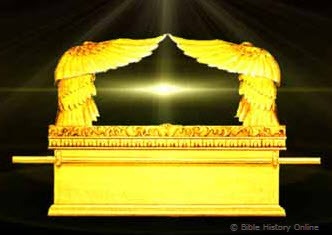
Painting of the Ark of the Covenant as Described in the Bible
Background of The Ark of the Covenant
The Ark of the Covenant was a picture of Jesus Christ
The Hebrew Name and Meaning of the Ark of the Covenant
The Hebrew noun " Ahrohn " (Ark) is used nearly 200 times in the Old Testament to depict the Ark of the Covenant. The word Ahrohn means chest or container and was used in various contexts. For example it was used for a money box (2 Ki 12:9), and also for a coffin (Gen. 50:26), both signifying its use as a container of something. The Bible goes further and calls it the Ark of God numerous times, and also the Ark of his might (Ps 132:8), signifying power and glory . Over 30 times the Ark is called The Ark of the Covenant of Yahweh (Num 10:33). The Covenant represented God's redemptive covenant with Israel and his promise to save his people if they would not forsake him. Yet ultimately the Bible seizes upon the ancient imagery of the blood covenant that was cut not only for the Jews but for all mankind, signifying the death of the One who makes the covenant.
Hebrews 9:16-18 - For where a covenant is, there must also of necessity be the death of the testator . For a testament is of force after men are dead: otherwise it is of no strength at all while the testator liveth. Whereupon neither the first testament was dedicated without blood.
The Biblical Description of the Ark of the Covenant
The description of the Ark of the Covenant was revealed to Moses while he was on Mount Sinai (Ex. 25:10-22). The Box was to be made of Acacia wood , it was to be 2.5 cubits (3.9 feet) long and 1.5 cubits (2.3 feet) wide and tall. It was overlaid completely with gold and it had a gold crown around the top of the box. The were gold rings with long poles of wood overlaid with gold for transporting the Ark.

An Artist's Depiction of the Ark of the Covenant
The Lid which was referred to as the Mercy Seat was crafted from one block of solid gold that was beaten into its shape. It was made of the same dimensions as the Ark 2.5 cubits by 1.5 cubits. On top were two angelic beings (Cherubim) which were standing on two feet and facing each other and looking down at the top of the lid where the blood was sprinkled. The Cherubim were also gold and were hammered from the same block of gold. They were 4-faced creatures as described in Ezekiel's vision (Ez. 1:5), the face of a lion, an eagle, an ox, and a man. The Cherubim were also the same fierce creatures who were chosen to guard the entrance to the Garden of Eden and the Tree of Life after Adam and Eve had sinned. They wielded a flaming sword that turned in four directions (Gen. 3:24).

Painting of the 4 Faces of the Cherubim
The Ark of the Covenant was Hand Crafted by two skilled and anointed craftsmen named Bezalel and Oholiab and other skilled workers. The Ark was placed within the Holy of Holies of the Tabernacle and later the Temple. There was a veil which separated God and man, and only the high priest could enter once per year on Yom Kippur (The Great Day of Atonement) to sprinkle the blood on the Mercy Seat.
The Purpose of the Ark of the Covenant
The primary purpose of the Ark of the Covenant was to contain God's covenant, the 2 unbroken stone tables of the law, the 10 commandments (Deut 10:3-5). Moses also had a golden jar of Manna placed in the Ark as a reminder of God's faithfulness (Ex. 16:33). God also commanded Moses to place Aaron's rod that budded into the Ark as a sign against rebellion (Num. 17:10).
The Ark of the Covenant was also a sign of God's continual Presence with his people. Just as God revealed himself at Mount Sinai, and in the Glory Cloud that led them through the wilderness, so God would appear between the wings of the Cherubim above the Mercy Seat:
Exodus 25:22 - And there I will meet with thee, and I will commune with thee from above the mercy seat, from between the two cherubims which [are] upon the ark of the testimony, of all [things] which I will give thee in commandment unto the children of Israel.
The Day of Atonement
On the Day of Atonement (Yom Kippur) each year the high priest would enter the Holy of Holies and sprinkle blood on the Mercy Seat of the Ark of the Covenant between the Cherubim to make atonement for sin (Lev. 16). First he would take a golden censor of incense and the smoke would fill the room. Then he would sprinkle blood on the Mercy Seat 7 times, first with the blood of a bull for his own sins, and then with the blood of a goat for the sins of the people. The Mercy Seat on the Ark of the Covenant became a place where God's judgement upon sin was met with mercy through the shed blood of a substitute. God's Law (10 Commandments) inside the Ark demanded judgement against man's sins and utter failure to keep the law, yet God's holiness and wrath against sin would be satisfied because of the shed blood of a substitute. The Mercy Seat completely covered man's sin from being seen by a holy God. This ritual would happen every year until the final sacrifice would cover the sins of all mankind for all time.
Hebrews 9:11-12 - "But Christ having come as a high priest of the good things to come, through the greater and more perfect tabernacle, not made with hands, that is to say, not of this creation, nor yet through the blood of goats and bulls, but through his own blood, entered in once for all into the Holy Place, having obtained eternal redemption."

Painting of the Tabernacle of Moses
The History of the Ark of the Covenant
God revealed to Moses on Mount Sinai his plans to build the Ark of the Covenant. The Tent of Meeting (Tabernacle) was erected on "the first month in the second year, on the first day of the month" (Ex. 40:17). The Ark was placed in the Holy of Holies and Moses put certain Levites, the Kohathites, in charge of the Ark (Num. 3:31), but they were not allowed to touch it. They would move the Ark using the long poles after it was covered by Aaron and his sons with the veil , a badger skin , and a blue cloth . The Ark led the people of Israel through the Wilderness and was ahead by a 3 days journey until they came to a place where they would set up camp. The Ark was with them through all their wilderness journeys.
Numbers 4:5-6 - When the camp moves forward, Aaron shall go in, and his sons, and they shall take down the veil of the screen, and cover the ark of the Testimony with it, and shall put a covering of badger skin on it, and shall spread over it a cloth all of blue, and shall put in its poles.
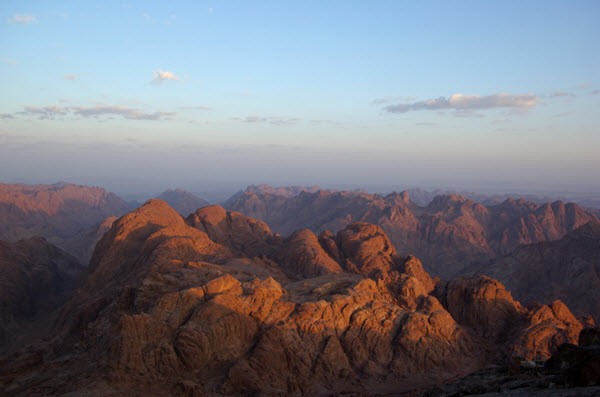
The Mountains of the Sinai Wilderness
The Ark of the Covenant and the Early History of Israel
Once the Children of Israel entered the Land of Canaan the Jordan River parted before the Ark of the Covenant. They set up memorial stones at Gilgal near where Abraham had erected his first altar. The Tabernacle was set up at Gilgal and Joshua set up his headquarters there. The Conquest of Canaan lasted seven years and the Ark was with the Israelites. In the conquering of Jericho the Israelites marched around the city wall with the Ark leading them and after 7 times the wall fell. While they were conquering the land the Tabernacle was moved to a more central location at Shiloh . Joshua and the Israelites Divided the Land of Canaan among the tribes and settled in the land. The Tabernacle and the Ark of the Covenant remained at Shiloh for over 300 years. It was while the Ark was at Shiloh that Samuel was dedicated to the LORD by his mother Hannah and he was raised by a priest named Eli, a descendant of Aaron. Throughout the Period of the Judges the Ark was at Shiloh, the Tabernacle was referred to as the "House of God" (Judg. 18:31) and even the "Temple of God where the Ark was" (1 Sam. 3:3). The Ark was mentioned at Bethel during the war against Gibeah (Judg. 20:26-27).
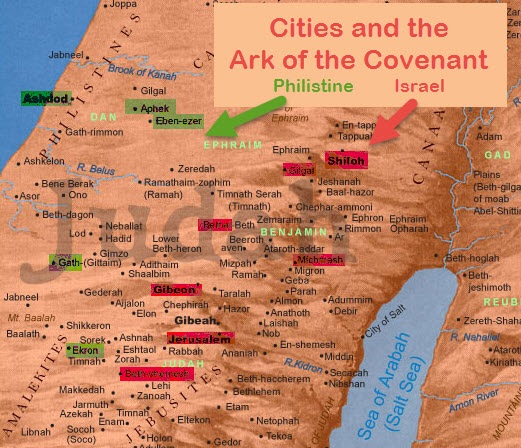
Map Showing the Key Places Where the Ark of the Covenant was Mentioned
The Ark of the Covenant and the Kingdom of Israel
Later in the 11th century BC the Philistines defeated Israel between Aphek and Eben-ezer and captured the Ark of the Covenant and brought the Ark from Eben-ezer to Ashdod, the chief city of the Land of the Philistines . Many plagues broke out in their land and when they placed the Ark in the temple of Dagon their god the idol fell down prostrate before the Ark and broke in pieces (1 Sam. 5:1-5). They placed the Ark on a milk cart and thought if the cow heads in the direction of Israel instead of her nursing calves it must be the LORD. The Ark returned to the Land of Israel to Beth-shemesh on the NW border of Judah, and the people from Beth-shemesh looked into the Ark and 50,070 of them were smitten by the LORD (1 Sam. 6:19). Later the Ark was moved to Kiriath-jearim , to the house of a Levite name Abinadab who lived on a hill. He consecrated his son Eliezer to keep watch of the Ark and it remained there for about 20 years. Kiriath-jearim was one of the four Gibeonite cities that made peace with Israel by deceit (Joshua 9:6). After this Israel cried out for a king and the prophet Samuel anointed the young good looking Saul, yet this was not God's chosen king. Saul became king but he neglected the Ark of the Covenant except for the time that he called for the Ark during the battle at Michmash (1 Sam. 14:18). Later after David conquered Jerusalem he intended to bring the Ark to his new capital on Mount Zion. A Levite named Uzzah was smitten by God for touching the Ark to keep it from falling off the cart on the road for the oxen had stumbled. David became concerned and delayed in bringing the Ark to Mount Zion. The Ark remained at the house of a Levite named Obed-edom for 3 months. Once David saw Obed-edom being blessed by the LORD he brought the Ark to Jerusalem with great singing and rejoicing. He placed the Ark of the Covenant in a tent near the Well of Gihon.

Illuminated Manuscript of David Bring the Ark to Jerusalem with Great Celebration
The Tabernacle and brazen altar of sacrifice were still functioning at Gibeon while the Ark was at a tent in Jerusalem. The Ark remained there except when the Levites brought the Ark to accompany David's armies in battle. When Solomon had been anointed king of Israel the Ark was still in the tent in Jerusalem. After Solomon built the First Temple on Mount Moriah and the Ark was placed in the Holy of Holies . The Ark of the Covenant remained in Solomon's Temple throughout the history of the Kings of Israel and Judah for the next 300 years. There was one incident where the evil King Manasseh removed the Ark which testified against him and placed an idol there instead (2 Chronicles 33:7). Later Josiah restored the Ark of the Covenant to the Holy of Holies. The Bible records that Jerusalem and the Temple of Solomon was destroyed in 586 BC. There is no record in the Bible of what happened to the Ark of the Covenant.
The Ark of the Covenant and the Destruction of Jerusalem by the Babylonians
When Nebuchadnezzar of Babylon destroyed Jerusalem and the Temple there is no mention of the Ark of the Covenant. It was not mentioned among the spoils of Nebuzaradan (2 Kings 25:13-17).
2 Chronicles 36:18-19 - All the vessels of God's house, great and small, and the treasures of The LORD's house, and the treasures of the king, and of his princes, all these he brought to Babylon. They burned God's house, and broke down the wall of Jerusalem, and burned all its palaces with fire, and destroyed all of its valuable vessels.
There was also no mention of the Ark of the Covenant with the objects returned by king Cyrus of Persia (Ezra 1:7-9, Ezra 5:14, Ezra 6:5). There is also no mention in the prophetic writings of Jeremiah and Ezekiel of the Ark's whereabouts. There is no mention of the Ark of the Covenant when Alexander the Great made a sacrifice when he came to Jerusalem. There is also no reference to the Ark of the Covenant among the spoils of Antiochus Epiphanes when he plundered the Second Temple in 167 BC. The second book of Esdras states: "the ark of our covenant is spoiled." 2 Esdras 10:22.
The Ark of the Covenant and the Second Temple
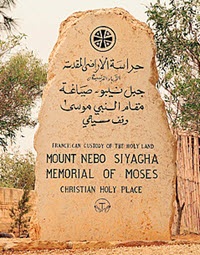
It is interesting that the Apocrypha indicates that the Ark of the Covenant could not be found when the Temple in Jerusalem was rebuilt, the Second Temple, the Temple of Zerubbabel which was built during the time of Ezra and Zechariah. The Apocrypha gives a reason for this stating that Jeremiah hid the Ark of the Covenant in a cave on Mt. Nebo before the Babylonians came and conquered Jerusalem. It also explains that the location of the Ark of the Covenant would not be revealed until God's determined time:
2 Maccabees 2:4-7 "It was also in the same document that the prophet, having received an oracle, ordered that the tent and the ark should follow with him, and that he went out to the mountain where Moses had gone up and had seen the inheritance of God. Jeremiah came and found a cave-dwelling, and he brought there the tent and the ark and the altar of incense; then he sealed up the entrance. Some of those who followed him came up intending to mark the way, but could not find it. When Jeremiah learned of it, he rebuked them and declared: ?The place shall remain unknown until God gathers his people together again and shows his mercy."
Many Jews in Israel today believe that the Ark of the Covenant will be found when the Messiah comes, some because of the above passage in the Apocrypha. Historical Christianity rejected the Apocrypha and the book of Maccabees as part of the Canon of Scripture, but only useful for religious and historical reference in some cases. Philo and Josephus also rejected the Apocrypha as Scripture. The writings of the Apocrypha were not admitted into the Bible by Jews or Christians until the 4th century AD. (For further reference see the book From God to Us by Norman Geisler and William Nix, 1974, Moody Press.
The Ark of the Covenant and the New Testament
When Pompey conquered Jerusalem in 63 BC he entered the Holy of Holies and referred to it as an "empty room."
During New Testament times the Ark of the Covenant was not in the Temple of Herod in Jerusalem. It is uncertain on what the blood was sprinkled on the Day of Atonement by the high priest. Jewish tradition mentions an altar stone raised up slightly above the floor.
It is amazing that something so powerful in ancient Old Testament times could just disappear from history. There is absolutely no mention of what happened to it until the New Testament revealed that it is in the heavenly Temple (Hebrews 9:4; Revelation 11:19).
Hebrews 9:11-12 - But Christ being come an high priest of good things to come, by a greater and more perfect tabernacle, not made with hands, that is to say, not of this building; Neither by the blood of goats and calves, but by his own blood he entered in once into the holy place, having obtained eternal redemption for us.
Revelation 11:19 - And the temple of God was opened in heaven, and there was seen in his temple the ark of his testament: and there were lightnings, and voices, and thunderings, and an earthquake, and great hail.
The Ark of the Covenant and Archaeology
Has the Ark of the Covenant been discovered or does anyone have an idea of where it is? Although there are very many claims that the Ark of the Covenant has been seen or discovered, there is no evidence of this. There is no archaeological Society or organization that has recognized the discovery of the Ark of the Covenant. In an exclusive interview with Bible History Online Dr. Dan Bahat, chief archaeologist of the Temple Mount was asked about the Ark of the Covenant and whether anything has been discovered and he said, "No, and there won't be because we know already from the book of Maccabees that it was hidden already outside of Jerusalem, according to tradition on Mount Nebo in TransJordan." We asked where the best possible choice of the location of the Ark of the Covenant could be based on Archaeology, his reply was, "I would start on Mount Nebo." Another interesting question we asked Dr. Bahat was if there has been any relevance to sightings anywhere in Jerusalem of the Ark of the Covenant, or things like Jeremiah's Grotto, his reply was: "Rubbish, all rubbish."
Does the Ark need to be discovered before the building of a Third Temple? The Ark of the Covenant would be a remarkable discovery and would certainly stimulate excitement and enthusiasm in Jews around the world but it does not necessarily need to be discovered for the building of the Third Temple in Jerusalem. Obviously the Jews built the Second Temple with no Ark of the Covenant and God blessed Zerubabbel's Temple, and even in the time of Herod's Temple there was no Ark, yet Jesus referred to it as "my father's house." It is clear from the Scriptures that there will be a Third Temple during the tribulation, and that the antichrist will take his seat there. In our interview with Dr. Bahat we asked him if there was any talk in Jerusalem about the building of a Third Temple and what about the Dome of the Rock, his reply was, "It cannot be, we must wait for the Messiah to come, and positionally it is not possible for the Dome of the Rock to stand where the Temple stands because they are the same place...it must be only by divine power."
Was the Ark of the Covenant Similar to Egyptian Arks?

Egyptian Cedar Chest from Tutankhamen's Tomb
"The Egyptian arks (on their monuments) were, like the Hebrew ark, carried by poles on men's shoulders. Some had on the cover two winged figures like cherubim; but between these was the material symbol of a deity, and the arks were carried about in procession to make a show before the people. The ark of the covenant on the contrary was marked by the absence of any symbol of God. It was never carried in procession. When moved it was carefully covered up from the eyes even of the Levites who bore it (Numbers 4:5-6; Numbers 4:19-20): "they shall not go in to see when the holy things are covered, lest they die." Compare 1 Samuel 6:19. In the tabernacle the ark was withdrawn from view in the mysterious holy of holies." - Fausset
The Ark of the Covenant and Traditions of its Location
Did archaeologists find a secret cave under the Dome of the Rock?
Is the Ark of the Covenant in Tanis as in the movie "Raiders of the Lost Ark?
Was the Ark of the Covenant Taken by the Egyptian king Shishak I?
Did the Babylonians Take the Ark to Babylon when they Conquered Jerusalem?
Did the prophet Jeremiah hide the Ark before the Babylonians arrived?
The Bible Mentions the Ark of the Covenant
Numbers 10:33 - And they departed from the mount of the LORD three days' journey: and the Ark of the Covenant of the LORD went before them in the three days' journey, to search out a resting place for them. Joshua 3:17 - And the priests that bare the Ark of the Covenant of the LORD stood firm on dry ground in the midst of Jordan, and all the Israelites passed over on dry ground, until all the people were passed clean over Jordan. Joshua 4:7 - Then ye shall answer them, That the waters of Jordan were cut off before the Ark of the Covenant of the LORD; when it passed over Jordan, the waters of Jordan were cut off: and these stones shall be for a memorial unto the children of Israel for ever. 1 Kings 8:1 - Then Solomon assembled the elders of Israel, and all the heads of the tribes, the chief of the fathers of the children of Israel, unto king Solomon in Jerusalem, that they might bring up the Ark of the Covenant of the LORD out of the city of David, which [is] Zion. Joshua 4:18 - And it came to pass, when the priests that bare the Ark of the Covenant of the LORD were come up out of the midst of Jordan, [and] the soles of the priests' feet were lifted up unto the dry land, that the waters of Jordan returned unto their place, and flowed over all his banks, as [they did] before. Joshua 3:14 - And it came to pass, when the people removed from their tents, to pass over Jordan, and the priests bearing the Ark of the Covenant before the people; 1 Kings 3:15 - And Solomon awoke; and, behold, [it was] a dream. And he came to Jerusalem, and stood before the Ark of the Covenant of the LORD, and offered up burnt offerings, and offered peace offerings, and made a feast to all his servants.
The Bible Mentions Ark Often
Exodus 25:16 And thou shalt put into the ark the testimony which I shall give thee. Exodus 25:21 And thou shalt put the mercy seat above upon the ark ; and in the ark thou shalt put the testimony that I shall give thee. Exodus 40:0 And he took and put the testimony into the ark , and set the staves on the ark, and put the mercy seat above upon the ark: Deuteronomy 10:5 And I turned myself and came down from the mount, and put the tables in the ark which I had made; and there they be, as the LORD commanded me. Deuteronomy 31:26 Take this book of the law, and put it in the side of the ark of the covenant of the LORD your God, that it may be there for a witness against thee. 1 Kings 8:9 [There was] nothing in the ark save the two tables of stone, which Moses put there at Horeb, when the LORD made [a covenant] with the children of Israel, when they came out of the land of Egypt. 2 Chronicles 5:10 [There was] nothing in the ark save the two tables which Moses put [therein] at Horeb, when the LORD made [a covenant] with the children of Israel, when they came out of Egypt. 2 Samuel 6:12 And it was told king David, saying, The LORD hath blessed the house of Obededom, and all that [pertaineth] unto him, because of the ark of God . So David went and brought up the ark of God from the house of Obededom into the city of David with gladness. 2 Samuel 6:13 And it was [so], that when they that bare the ark of the LORD had gone six paces, he sacrificed oxen and fatlings. 2 Samuel 6:14 And David danced before the LORD with all [his] might; and David [was] girded with a linen ephod. 2 Samuel 6:15 So David and all the house of Israel brought up the ark of the LORD with shouting, and with the sound of the trumpet. 2 Samuel 6:16 And as the ark of the LORD came into the city of David, Michal Saul's daughter looked through a window, and saw king David leaping and dancing before the LORD; and she despised him in her heart. 2 Samuel 6:17 And they brought in the ark of the LORD , and set it in his place, in the midst of the tabernacle that David had pitched for it: and David offered burnt offerings and peace offerings before the LORD. 1 Chronicles 6:31 And these [are they] whom David set over the service of song in the house of the LORD, after that the ark had rest. 1 Chronicles 16:1 So they brought the ark of God , and set it in the midst of the tent that David had pitched for it: and they offered burnt sacrifices and peace offerings before God.
Ark of the Covenant in Smith's Bible Dictionary Ark of the Covenant. The first piece of the tabernacle's furniture, for which precise directions were delivered. Exod 25. I. Description.-- It appears to have been an oblong chest of shittim (acacia) wood, 2 1/2 cubits long by 1 1/2 broad and deep. Within and without gold was overlaid on the wood, and on the upper side or lid, which was edged round about with gold, the mercy-seat was placed. The ark was fitted with rings, one at each of the four corners, and through these were passed staves of the same wood similarly overlaid, by which it was carried by the Kohathites. Nu 7:9; 10:21 The ends of the staves were visible without the veil in the holy place of the temple of Solomon. 1Ki 8:8 The ark, when transported, was enveloped in the "veil" of the dismantled tabernacle, in the curtain of badgers' skins and in a blue cloth over all, and was therefore not seen. Nu 4:5,20 II. Its purpose was to contain inviolate the divine autograph of the two tables, that "covenant" from which it derived its title. It was also probably a reliquary for the pot of manna and the rod of Aaron. III. Read Full Article
Ark of the Covenant in the ISBE Bible Encyclopedia The Form of the Ark of the Covenant. According to the statements in the Priestly Code (P), the ark of the covenant was a chest made out of acacia wood, 2 1/2 cubits (about equal to 4 ft.) long, 1 1/2 cubits wide and 1 1/2 high. That it was made out of acacia wood is also stated by the Deuteronomist in Dt 10:3. According to P it was covered with gold within and without, and was ornamented with a moulding of gold running all around it. At its four feet rings were added, through which the gold-covere d carrying-staves were put. These staves are also mentioned in 1 Ki 8:7,8; 2 Ch 5:8,9, and mention is often made of those who carried the ark (2 Sam 6:13; 15:24). The correctness of these statements cannot be proved, but yet there is no reason to doubt them. Rather we might have reason to hesitate in clinging to the view that on the old ark there was really a golden kapporeth, but only because in olden times the possession of such valuables and their use for such a purpose would be doubtful. But on the basis of such reasons we could at most doubt whether the lid with its cherubim consisted of solid gold. Read Full Article
Ark of the Covenant in Easton's Bible Dictionary Ark. The sacred ark is designated by a different Hebrew word, "'aron'", which is the common name for a chest or coffer used for any purpose (Gen. 50:26; 2 Kings 12:9, 10). It is distinguished from all others by such titles as the "ark of God" (1 Sam. 3:3), "ark of the covenant" (Josh. 3:6; Heb. 9:4), "ark of the testimony" (Ex. 25:22). It was made of acacia or shittim wood, a cubit and a half broad and high and two cubits long, and covered all over with the purest gold. Its upper surface or lid, the mercy-seat, was surrounded with a rim of gold; and on each of the two sides were two gold rings, in which were placed two gold-covered poles by which the ark could be carried (Num. 7:9; 10:21; 4:5,19, 20; 1 Kings 8:3, 6). Over the ark, at the two extremities, were two cherubim, with their faces turned toward each other (Lev. 16:2; Num. 7:89). Their outspread wings over the top of the ark formed the throne of God, while the ark itself was his footstool (Ex. 25:10-22; 37:1-9). The ark was deposited in the "holy of holies," and was so placed that one end of the poles by which it was carried touched the veil which separated the two apartments of the tabernacle (1 Kings 8:8). The two tables of stone which constituted the "testimony" or evidence of God's covenant with the people (Deut. 31:26), the "pot of manna" (Ex. 16:33), and "Aaron's rod that budded" (Num. 17:10), were laid up in the ark (Heb. 9:4). Read Full Article
Ark of the Covenant in Fausset's Bible Dictionary Ark of the covenant. (aron, not teebah). An oblong chester shittim wood (acacia), two and a half cubits long, one and a half broad and deep. F. W. Kolland measured acacias nine feet in girth, in the region of Israel's wandering; he attributes their being usually stunted there to the Arabs cutting off the young shoots for the she goats. Thus Colenso's cavil that "not a single acacia" is to be seen where the ark is said to have been constructed is answered. It is a propriety characteristic of the truth of the Scripture narrative that it represents the ark as not made of oak or cedar, the best woods of the Holy Land, but of acacia, the wood of the wilderness. Cedar actually was the wood used for the Jerusalem temple. In the thorn of man's curse appeared the angel of the covenant to Moses, to bless man; and out of its wood was formed the ark of the covenant, the typical source of his blessing. Overlaid with gold within and without. Read Full Article
Ark of the Covenant in Naves Topical Bible
IN THE TABERNACLE. Called THE ARK OF THE COVENANT Nu 10:33; De 31:26; Jos 4:7; 1Sa 4:3; 2Sa 15:24; 1Ch 15:25; 17:1; Jer 3:16; Heb 9:4 OF THE TESTIMONY Ex 30:6 OF THE LORD Jos 4:11; 1Sa 4:6; 6:1; 2Sa 6:9; 15:12; 16:4 OF GOD 1Sa 3:3; 4:11,17,22; 6:3; 14:18; 2Sa 6:7; 7:2; 15:25; 1Ch 13:12; 15:1,2,15,24; 16:1 OF GOD'S STRENGTH 2Ch 6:41 Sanctification of Ex 30:26 Ceremonies connected with, on the day of atonement Le 16:13-15 Holy 2Ch 8:11; 35:3 An oracle of God Nu 10:33; 14:44; Jos 7:6-15; Jud 20:27,28; 1Sa 4:3,4,7; 1Ch 13:3; 16:4,37; 2Ch 6:41; Ps 132:8 See MERCY SEAT Directions for making Ex 25:10-15; 35:12 Construction of Ex 37:1-5; De 10:3 Contents of The law Ex 25:16,21; 40:20; De 10:5; 31:26; 1Ki 8:9; 2Ch 5:10 Aaron's rod Nu 17:10; Heb 9:4 Pot of manna Ex 16:33,34; Heb 9:4 Read Full Article The Bible Mentions the Covenant Often
Leviticus 2:13 - And every oblation of thy meat offering shalt thou season with salt; neither shalt thou suffer the salt of the covenant of thy God to be lacking from thy meat offering: with all thine offerings thou shalt offer salt. Isaiah 59:21 - As for me, this [is] my covenant with them, saith the LORD; My spirit that [is] upon thee, and my words which I have put in thy mouth, shall not depart out of thy mouth, nor out of the mouth of thy seed, nor out of the mouth of thy seed's seed, saith the LORD, from henceforth and for ever. 2 Kings 11:17 - And Jehoiada made a covenant between the LORD and the king and the people, that they should be the LORD'S people; between the king also and the people. 1 Chronicles 11:3 - Therefore came all the elders of Israel to the king to Hebron; and David made a covenant with them in Hebron before the LORD; and they anointed David king over Israel, according to the word of the LORD by Samuel. Joshua 8:33 - And all Israel, and their elders, and officers, and their judges, stood on this side the ark and on that side before the priests the Levites, which bare the ark of the covenant of the LORD, as well the stranger, as he that was born among them; half of them over against mount Gerizim, and half of them over against mount Ebal; as Moses the servant of the LORD had commanded before, that they should bless the people of Israel. Isaiah 57:8 - Behind the doors also and the posts hast thou set up thy remembrance: for thou hast discovered [thyself to another] than me, and art gone up; thou hast enlarged thy bed, and made thee [a covenant ] with them; thou lovedst their bed where thou sawest [it]. Genesis 26:28 - And they said, We saw certainly that the LORD was with thee: and we said, Let there be now an oath betwixt us, [even] betwixt us and thee, and let us make a covenant with thee; Acts 7:8 - And he gave him the covenant of circumcision: and so [Abraham] begat Isaac, and circumcised him the eighth day; and Isaac [begat] Jacob; and Jacob [begat] the twelve patriarchs. Genesis 6:18 - But with thee will I establish my covenant ; and thou shalt come into the ark, thou, and thy sons, and thy wife, and thy sons' wives with thee. Ezekiel 16:8 - Now when I passed by thee, and looked upon thee, behold, thy time [was] the time of love; and I spread my skirt over thee, and covered thy nakedness: yea, I sware unto thee, and entered into a covenant with thee, saith the Lord GOD, and thou becamest mine. Numbers 10:33 - And they departed from the mount of the LORD three days' journey: and the ark of the covenant of the LORD went before them in the three days' journey, to search out a resting place for them. Exodus 34:15 - Lest thou make a covenant with the inhabitants of the land, and they go a whoring after their gods, and do sacrifice unto their gods, and [one] call thee, and thou eat of his sacrifice; Isaiah 54:10 - For the mountains shall depart, and the hills be removed; but my kindness shall not depart from thee, neither shall the covenant of my peace be removed, saith the LORD that hath mercy on thee. Malachi 3:1 - Behold, I will send my messenger, and he shall prepare the way before me: and the Lord, whom ye seek, shall suddenly come to his temple, even the messenger of the covenant , whom ye delight in: behold, he shall come, saith the LORD of hosts. Numbers 18:19 - All the heave offerings of the holy things, which the children of Israel offer unto the LORD, have I given thee, and thy sons and thy daughters with thee, by a statute for ever: it [is] a covenant of salt for ever before the LORD unto thee and to thy seed with thee. Deuteronomy 9:9 - When I was gone up into the mount to receive the tables of stone, [even] the tables of the covenant which the LORD made with you, then I abode in the mount forty days and forty nights, I neither did eat bread nor drink water: Joshua 3:17 - And the priests that bare the ark of the covenant of the LORD stood firm on dry ground in the midst of Jordan, and all the Israelites passed over on dry ground, until all the people were passed clean over Jordan. 1 Samuel 20:8 - Therefore thou shalt deal kindly with thy servant; for thou hast brought thy servant into a covenant of the LORD with thee: notwithstanding, if there be in me iniquity, slay me thyself; for why shouldest thou bring me to thy father? Joshua 4:7 - Then ye shall answer them, That the waters of Jordan were cut off before the ark of the covenant of the LORD; when it passed over Jordan, the waters of Jordan were cut off: and these stones shall be for a memorial unto the children of Israel for ever. 1 Kings 8:1 - Then Solomon assembled the elders of Israel, and all the heads of the tribes, the chief of the fathers of the children of Israel, unto king Solomon in Jerusalem, that they might bring up the ark of the covenant of the LORD out of the city of David, which [is] Zion. 2 Kings 23:2 - And the king went up into the house of the LORD, and all the men of Judah and all the inhabitants of Jerusalem with him, and the priests, and the prophets, and all the people, both small and great: and he read in their ears all the words of the book of the covenant which was found in the house of the LORD. 2 Chronicles 34:30 - And the king went up into the house of the LORD, and all the men of Judah, and the inhabitants of Jerusalem, and the priests, and the Levites, and all the people, great and small: and he read in their ears all the words of the book of the covenant that was found in the house of the LORD. Isaiah 49:8 - Thus saith the LORD, In an acceptable time have I heard thee, and in a day of salvation have I helped thee: and I will preserve thee, and give thee for a covenant of the people, to establish the earth, to cause to inherit the desolate heritages; Joshua 4:18 - And it came to pass, when the priests that bare the ark of the covenant of the LORD were come up out of the midst of Jordan, [and] the soles of the priests' feet were lifted up unto the dry land, that the waters of Jordan returned unto their place, and flowed over all his banks, as [they did] before. 2 Kings 11:4 - And the seventh year Jehoiada sent and fetched the rulers over hundreds, with the captains and the guard, and brought them to him into the house of the LORD, and made a covenant with them, and took an oath of them in the house of the LORD, and shewed them the king's son. Joshua 3:14 - And it came to pass, when the people removed from their tents, to pass over Jordan, and the priests bearing the ark of the covenant before the people; Daniel 11:28 - Then shall he return into his land with great riches; and his heart [shall be] against the holy covenant ; and he shall do [exploits], and return to his own land. 1 Kings 3:15 - And Solomon awoke; and, behold, [it was] a dream. And he came to Jerusalem, and stood before the ark of the covenant of the LORD, and offered up burnt offerings, and offered peace offerings, and made a feast to all his servants. Ezekiel 16:61 - Then thou shalt remember thy ways, and be ashamed, when thou shalt receive thy sisters, thine elder and thy younger: and I will give them unto thee for daughters, but not by thy covenant . Ezekiel 44:7 - In that ye have brought [into my sanctuary] strangers, uncircumcised in heart, and uncircumcised in flesh, to be in my sanctuary, to pollute it, [even] my house, when ye offer my bread, the fat and the blood, and they have broken my covenant because of all your abominations.
Directions for Making the Ark of the Covenant: Exodus 25:10-15 Exodus 25:10-15 - And they shall make an ark [of] shittim wood: two cubits and a half [shall be] the length thereof, and a cubit and a half the breadth thereof, and a cubit and a half the height thereof. And thou shalt overlay it with pure gold, within and without shalt thou overlay it, and shalt make upon it a crown of gold round about. And thou shalt cast four rings of gold for it, and put [them] in the four corners thereof; and two rings [shall be] in the one side of it, and two rings in the other side of it. And thou shalt make staves [of] shittim wood, and overlay them with gold. And thou shalt put the staves into the rings by the sides of the ark, that the ark may be borne with them. The staves shall be in the rings of the ark: they shall not be taken from it.
The Contents of the Ark of the Covenant: Hebrews 9:3-4 Hebrews 9:3-4 - And after the second veil, the tabernacle which is called the Holiest of all; Which had the golden censer, and the ark of the covenant overlaid round about with gold, wherein [was] the golden pot that had manna, and Aaron's rod that budded, and the tables of the covenant;
The Place of the Ark withing the Tabernacle: Exodus 40:21 Exodus 40:21 - And he brought the ark into the tabernacle, and set up the vail of the covering, and covered the ark of the testimony; as the LORD commanded Moses.
-------------------------------------------------------------------
More Ark of the Covenant Resources
The Ark of the Covenant (The Tabernacle) - Bible History Online - The Ark of the Covenant (Ex 25:10-22). The purpose of the Tabernacle was to house the Ark in which the tablets of the Ten Commandments were placed. https://bible-history.com/t... The Mercy Seat (The Tabernacle) - Bible History Online - Bible History Online - The Mercy Seat on The Ark of the Covenant , the Tabernacle of Moses in the Wilderness. https://bible-history.com/t... The Ark of the Covenant - Bible History Online - The Ark of the Covenant was a physical sign that the God of all the earth was in Israel "and let them make me a sanctuary, that I may dwell in them" (Ex. 25:8). https://bible-history.com/b... The Shekinah Glory (The Tabernacle) - Bible History Online - God's promise was that He would dwell within the Holy of Holies above the Mercy Seat of the Ark of the Covenant . Why Study the Tabernacle? A) 50 Chapters... https://bible-history.com/t... ARK OF THE COVENANT in the Bible Encyclopedia - ISBE (Bible ... - I. The Statements of the Old Testament Concerning the Ark of the Covenant . 1. Pentateuch: In Ex 25:10 ff, Moses receives the command to build an ark of acacia ... https://bible-history.com/i... The Golden Ark of the Covenant (Painting) - Glossary - Bible History ... - God's promise was that He would dwell within the Holy of Holies above the Mercy Seat of the Ark of the Covenant . Why Study the Tabernacle? A) 50 Chapters... https://bible-history.com/t... The Outer Court of the Tabernacle of Moses (Bible History Online) - The second chamber was called the Holy of Holies, it contained the Ark of the Covenant . The High Priest the Holy of Holies only once a year on the Day of... https://bible-history.com/t... Tabernacle Model (BiblePlaces.com) - Ark of the Covenant . The only object in the Holy of Holies, the sacred ark contained the two tablets with the Ten Commandments, the rod of Aaron that... https://bible-history.com/l... Bible Definition of Ark of the covenant in Fausset's Bible Dictionary - In the thorn of man's curse appeared the angel of the covenant to Moses, to bless man; and out of its wood was formed the ark of the covenant , the typical source... https://bible-history.com/f... Tabernacle Ark of the Covenant - Glossary - The Tabernacle of ... - God's promise was that He would dwell within the Holy of Holies above the Mercy Seat of the Ark of the Covenant . Why Study the Tabernacle? A) 50 Chapters... https://bible-history.com/t... -------------------------------------------------------------------------------- Bible Study and Faith
"The Bible is the most priceless possession of the human race." - Henry H. Halley
"This handbook is dedicated to the proposition that every Christian should be a constant and devoted reader of the Bible, and that the primary business of the church and ministry is to lead, foster, and encourage their people in the habit."
"The vigor of our spiritual life will be in exact proportion to the place held by the Bible in our life and thoughts."
"Great has been the blessing from consecutive, diligent, daily study. I look upon it as a lost day when I have not had a good time over the word of God." - George Muller
"I prayed for faith, and thought that some day faith would come down and strike me like lightning. But faith did not seem to come. One day I read in the 10th chapter of Romans, 'Now faith cometh by hearing, and hearing by the word of God.' I had closed my Bible, and prayed for faith. I now opened my Bible, and began to study, and faith has been growing ever since." - D. L. Moody
-H. H. Halley "Halley's Bible Handbook" (Grand Rapids: Zondervan, 1960) p. 4, 6 -------------------------------------------------------------------------------- Archaeological Study of the Bible
"A substantial proof for the accuracy of the Old Testament text has come from archaeology. Numerous discoveries have confirmed the historical accuracy of the biblical documents, even down to the obsolete names of foreign kings... Rather than a manifestation of complete ignorance of the facts of its day, the biblical record thus reflects a great knowledge by the writer of his day, as well as precision in textual transmission." -Norman L. Geisler, William Nix "A General Introduction to the Bible" 5th Edition (Chicago: Moody Press 1983) p. 253

Explore the Bible Like Never Before!
Unearth the rich tapestry of biblical history with our extensive collection of over 1000 meticulously curated Bible Maps and Images . Enhance your understanding of scripture and embark on a journey through the lands and events of the Bible.
- Ancient city layouts
- Historic routes of biblical figures
- Architectural wonders of the Holy Land
- Key moments in biblical history
Start Your Journey Today!
Click here to access our Bible Maps and Images
Table of Contents
Ancient altars, ancient bull worship, ancient caesarea philippi, ancient cisterns, ancient crucifixion, ancient marriage, ancient nineveh, ancient sodom and gomorrah, ancient ziggurats, biblical description, brief summary, herod's temple, king solomon, old testament books (hebrew meanings), old testament books (in english order), old testament books (in hebrew order), old testament books (with authors, dates, and subjects), the ancient moabites, the blood of jesus, the history of israel, the kingdoms of israel and judah, the mercy seat, the passover, the presence of god, the rejection of israel, the second temple, the tabernacle, the transfiguration, the true meaning and significance, what happened to the ark.
Search a pre-defined list
The Whole Bible The Old Testament The New Testament ────────────── Pentateuch Historical Books Poetical Books Wisdom Literature Prophets Major Prophets Minor Prophets ────────────── The Gospels Luke-Acts Pauline Epistles General Epistles Johannine Writings ────────────── Genesis Exodus Leviticus Numbers Deuteronomy Joshua Judges Ruth 1 Samuel 2 Samuel 1 Kings 2 Kings 1 Chronicles 2 Chronicles Ezra Nehemiah Esther Job Psalms Proverbs Ecclesiastes Song of Songs Isaiah Jeremiah Lamentations Ezekiel Daniel Hosea Joel Amos Obadiah Jonah Micah Nahum Habakkuk Zephaniah Haggai Zechariah Malachi Matthew Mark Luke John Acts Romans 1 Corinthians 2 Corinthians Galatians Ephesians Philippians Colossians 1 Thessalonians 2 Thessalonians 1 Timothy 2 Timothy Titus Philemon Hebrews James 1 Peter 2 Peter 1 John 2 John 3 John Jude Revelation
OR Select a range of biblical books
Select a Beginning Point Genesis Exodus Leviticus Numbers Deuteronomy Joshua Judges Ruth 1 Samuel 2 Samuel 1 Kings 2 Kings 1 Chronicles 2 Chronicles Ezra Nehemiah Esther Job Psalms Proverbs Ecclesiastes Song of Songs Isaiah Jeremiah Lamentations Ezekiel Daniel Hosea Joel Amos Obadiah Jonah Micah Nahum Habakkuk Zephaniah Haggai Zechariah Malachi Matthew Mark Luke John Acts Romans 1 Corinthians 2 Corinthians Galatians Ephesians Philippians Colossians 1 Thessalonians 2 Thessalonians 1 Timothy 2 Timothy Titus Philemon Hebrews James 1 Peter 2 Peter 1 John 2 John 3 John Jude Revelation
Select an Ending Point Genesis Exodus Leviticus Numbers Deuteronomy Joshua Judges Ruth 1 Samuel 2 Samuel 1 Kings 2 Kings 1 Chronicles 2 Chronicles Ezra Nehemiah Esther Job Psalms Proverbs Ecclesiastes Song of Songs Isaiah Jeremiah Lamentations Ezekiel Daniel Hosea Joel Amos Obadiah Jonah Micah Nahum Habakkuk Zephaniah Haggai Zechariah Malachi Matthew Mark Luke John Acts Romans 1 Corinthians 2 Corinthians Galatians Ephesians Philippians Colossians 1 Thessalonians 2 Thessalonians 1 Timothy 2 Timothy Titus Philemon Hebrews James 1 Peter 2 Peter 1 John 2 John 3 John Jude Revelation
OR Custom Selection:
Use semicolons to separate groups: 'Gen;Jdg;Psa-Mal' or 'Rom 3-12;Mat 1:15;Mat 5:12-22'

Click to Change
Return to Top

ESV Global Study Bible :: The Journey of the Ark of the Covenant

The Journey of the Ark of the Covenant in 1-2 Samuel
The ESV Global Study Bible Copyright © 2012 by Crossway . All rights reserved. Used by permission.
Search Results in Other Versions
Search results by book, blb searches, search the bible.
Advanced Options
There are options set in 'Advanced Options'
Theological FAQs
Other Searches
Multi-Verse Retrieval
* 'Number Delimiters' only apply to 'Paragraph Order'
Let's Connect
Daily devotionals.
Blue Letter Bible offers several daily devotional readings in order to help you refocus on Christ and the Gospel of His peace and righteousness.
- BLB Daily Promises
- Day by Day by Grace
- Morning and Evening
- Faith's Checkbook
- Daily Bible Reading
Daily Bible Reading Plans
Recognizing the value of consistent reflection upon the Word of God in order to refocus one's mind and heart upon Christ and His Gospel of peace, we provide several reading plans designed to cover the entire Bible in a year.
One-Year Plans
- Chronological
- Old Testament and New Testament Together
Two-Year Plan
- Canonical Five Day Plan
Recently Popular Pages
- H3068 - Yᵊhōvâ - Strong's Hebrew Lexicon (kjv)
- Hoekstra's Day by Day by Grace
- O.T. Names of God - Study Resources
- Holy Foresight by C. H. Spurgeon
- David Guzik :: Hechos 9 – La Conversión de Saulo de Tarso
- David Guzik :: Salmo 119
- Harmony of the Gospels - Study Resources - Study Resources
- Therein, Thereinto, Thereof, Thereon, Thereout, Thereto, Thereunto, Thereupon, Therewith - Vine's Expository Dictionary of New Testament Words
- David Guzik :: 1 Corintios 7 – Principios Sobre el Matrimonio y la Soltería
Recently Popular Media
- Jehovah's Witnesses, Jesus and the Holy Trinity (Walter Martin)
- The Baptism of the Holy Spirit, Pt. 1 (Chuck Smith)
- Ephesians 2 (1979-82 Audio) (Chuck Smith)
- Romans 9-10 (1982-85 Audio) (Chuck Smith)
- David on the Run (Chuck Missler)
- Sign Eight (Don Stewart)
- The True Light (Tony Clark)
- Titus 1-3 (1982-85 Audio) (Chuck Smith)
- A Right Relationship (Kay Smith)
- Ephesians 4 (1979-82 Audio) (Chuck Smith)
CONTENT DISCLAIMER:
The Blue Letter Bible ministry and the BLB Institute hold to the historical, conservative Christian faith, which includes a firm belief in the inerrancy of Scripture. Since the text and audio content provided by BLB represent a range of evangelical traditions, all of the ideas and principles conveyed in the resource materials are not necessarily affirmed, in total, by this ministry.

Blue Letter Bible
Login to your account.
Email / username or password was incorrect!
Check your email for password retrieval
Keep me logged in!
Did you forget your password?
Register a new BLB account
Complete the form below to register [?]
Error: That Email is already registered
Error: Please provide a valid Email
Error: Passwords should have at least 6 characters
Error: Passwords do not match
Error: Please provide a valid first name
Error: That username is already taken
Error: Usernames should only contain letters, numbers, dots, dashes, or underscores
← Login to Your Account
Passwords should have at least 6 characters. Usernames should only contain letters, numbers, dots, dashes, or underscores.
Thank you for registering. A verification email has been sent to the address you provided.
Did You Know BLB Is User Supported?
Your partnership makes all we do possible. Would you prayerfully consider a gift of support today?
Cookie Notice: Our website uses cookies to store user preferences. By proceeding, you consent to our cookie usage. Please see Blue Letter Bible's Privacy Policy for cookie usage details.
Old Testament
New testament.
BibleWalks 500+ sites
Ark of Covenant
This page describes the Ark of Covenant, and maps the stations of its journey to the actual sites.
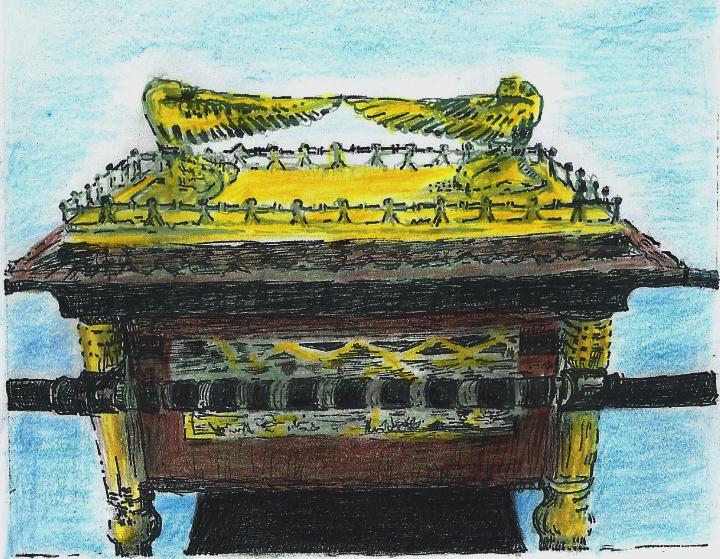
Home > Info > Ark of Covenant
Overview Sinai to Shiloh Shiloh to Jerusalem After Jerusalem
The Ark of the Covenant is a sacred object described in the Old Testament of the Bible as being a wooden chest covered with gold that contained the stone tablets inscribed with the Ten Commandments. According to the biblical account, the Ark was built at the command of God by the Israelites during their wanderings in the desert and was later placed in the Holy of Holies in the Temple of Jerusalem.
The Ark was seen as the symbol of God’s presence among the Israelites and was carried with them during their journeys. It was also associated with many miraculous events, such as the parting of the Red Sea and the collapse of the walls of Jericho.
Ark of Covenant in a tent in the desert– computer AI generated by DallE2
The exact fate of the Ark is not known for certain, as it disappeared from history around the time of the Babylonian conquest of Jerusalem in 587 BC. Some theories suggest that it may have been hidden or destroyed, while others speculate that it was taken away to Ethiopia or another location.
The Ark continues to be an object of fascination and speculation, and its significance in the history and theology of Judaism and Christianity remains a subject of scholarly and religious study.
The stations of the ark:
(a) from sinai to shiloh.
The Ark of Covenant is a gold-covered wooden chest with lid cover. It housed the two stone tablets of the Ten Commandments that Moses received from God on Mount Sinai ( Exodus 24:1 8):
“And Moses went into the midst of the cloud, and gat him up into the mount: and Moses was in the mount forty days and forty nights”.
The ten commandments were inscribed on two stone tablets.
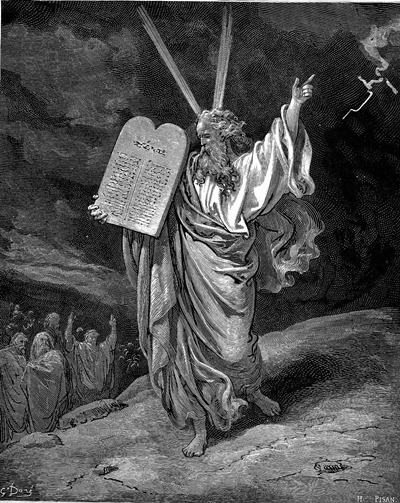
Moses comes down from Mt Sinai, holding tablets – drawing by Gustav Dore (French artist, 1832-1883)
Moses was instructed how to store the tablets in a hand carried ark. Its dimensions were approximately 131 cm ×79 cm × 79 cm (52×31×31 inches). The instructions were detailed ( Exodus 25:10-16 ):
“And they shall make an ark of shittim wood: two cubits and a half shall be the length thereof, and a cubit and a half the breadth thereof, and a cubit and a half the height thereof. And thou shalt overlay it with pure gold, within and without shalt thou overlay it, and shalt make upon it a crown of gold round about. And thou shalt cast four rings of gold for it, and put them in the four corners thereof; and two rings shall be in the one side of it, and two rings in the other side of it. And thou shalt make staves of shittim wood, and overlay them with gold. And thou shalt put the staves into the rings by the sides of the ark, that the ark may be borne with them. The staves shall be in the rings of the ark: they shall not be taken from it. And thou shalt put into the ark the testimony which I shall give thee.”.
Ark of Covenant Drawing by grandma Rina
The ark is referred to in the Bible more than 200 times, and is considered an important ritual instrument.
The Israelites traveled for 40 years with the ark, which was carried by the Levites ( Numbers 10:33 ):
“ And they departed from the mount of the LORD three days’ journey: and the ark of the covenant of the LORD went before them in the three days’ journey, to search out a resting place for them”.
At every stop the ark was placed in a sacred tent – the Tabernacle ( Exodus 41:21 ):
“And he brought the ark into the tabernacle , and set up the vail of the covering, and covered the ark of the testimony; as the LORD commanded Moses”.
After the death of Moses, Joshua led the Israelites to the Land of Israel ( Joshua 3:17, 4:7 ):
“And the priests that bare the ark of the covenant of the LORD stood firm on dry ground in the midst of Jordan, and all the Israelites passed over on dry ground, until all the people were passed clean over Jordan… when it passed over Jordan, the waters of Jordan were cut off”.
The ark helped Joshua and the Israelites to capture the heavily fortified Jericho ( Joshua 6:6 ):
“Take up the ark of the covenant, and let seven priests bear seven trumpets of rams’ horns before the ark of the LORD”.
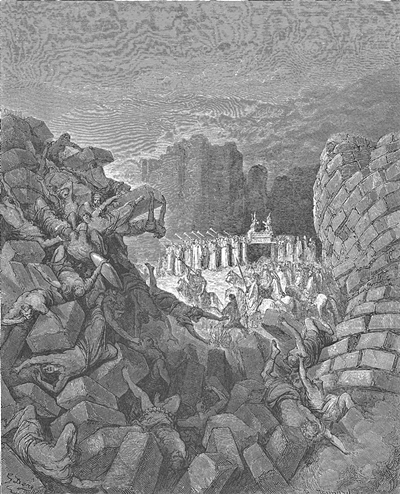
Ark of Covenant and the fall of Jericho – – drawing by Gustav Dore (French artist, 1832-1883)
(b) from shiloh to jerusalem.
The Ark of Covenant traveled with the Israelites from Mount Sinai into the Land of Israel. It was then brought to a temple in Shiloh. The following are 8 stations of the ark since it came to its home in Shiloh and the events that followed after it was lost to the Philistines.
Shiloh was the religious capital of Israel during the times of the Judges, and spans 4,000 years of continuous settlement starting from the 18th century BC (Middle Bronze II). Shiloh was an assembly place for the people of Israel and a center of worship. Its sacred area (Tabernacle – Mishkan) in Shiloh housed the Ark of Covenant, Table of Showbread, Altar of Incense and Golden Lamp stand. ( Joshua 18:1) :
“And the whole congregation of the children of Israel assembled together at Shiloh, and set up the tabernacle of the congregation there”.
Shiloh was the home of the Tabernacle (Mishkan) for 369 years.
Where is Shiloh?
Tel Shiloh is located 17km south of Shechem, and is accessible from the city of Ariel. The ruins of Shiloh are part of the archaeological park of “Ancient Shiloh”, which is located in the entrance to the modern community of Shiloh.
Shiloh is sacred to three religions – Jewish, Christian and Muslim – and pilgrims come to visit the ruins for the past 3,060 years. On the south-east side of Tel Shiloh are ruins of Mosques and Churches and a modern Synagogue.
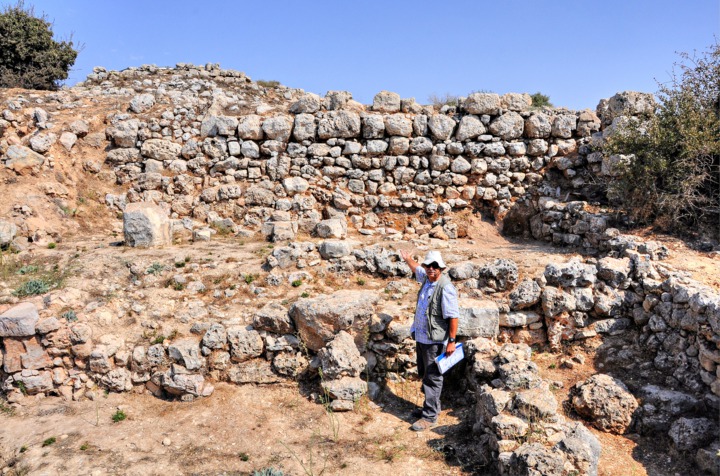
2: Eben Haezer
The ark was lost to the Philistines following the battle of Eben ezer.
Description of the battle at Ebenezer, and the loss of the Ark ( 1 Samuel 4: 1-11 ):
“And the word of Samuel came to all Israel. Now Israel went out against the Philistines to battle, and pitched beside Ebenezer : and the Philistines pitched in Aphek. And the Philistines put themselves in array against Israel: and when they joined battle, Israel was smitten before the Philistines: and they slew of the army in the field about four thousand men. And when the people were come into the camp, the elders of Israel said, Wherefore hath the LORD smitten us to day before the Philistines? Let us fetch the ark of the covenant of the LORD out of Shiloh unto us, that, when it cometh among us, it may save us out of the hand of our enemies. So the people sent to Shiloh, that they might bring from thence the ark of the covenant of the LORD of hosts, which dwelleth between the cherubim: and the two sons of Eli, Hophni and Phinehas, were there with the ark of the covenant of God”.
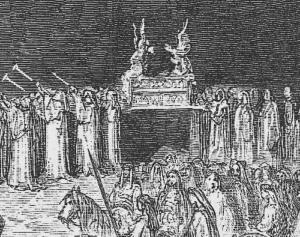
Ark of Covenant moved to the battlefield –
Part of a drawing by gustav dore (french artist, 1832-1883).
“And when the ark of the covenant of the LORD came into the camp, all Israel shouted with a great shout, so that the earth rang again. And when the Philistines heard the noise of the shout, they said, What meaneth the noise of this great shout in the camp of the Hebrews? And they understood that the ark of the LORD was come into the camp. And the Philistines were afraid, for they said, God is come into the camp. And they said, Woe unto us! for there hath not been such a thing heretofore. Woe unto us! who shall deliver us out of the hand of these mighty Gods? these are the Gods that smote the Egyptians with all the plagues in the wilderness. Be strong and quit yourselves like men, O ye Philistines, that ye be not servants unto the Hebrews, as they have been to you: quit yourselves like men, and fight. And the Philistines fought, and Israel was smitten, and they fled every man into his tent: and there was a very great slaughter; for there fell of Israel thirty thousand footmen. And the ark of God was taken; and the two sons of Eli, Hophni and Phinehas, were slain”.
The Philistines purged all the way to the heart of Samaria and destroyed Shiloh at some time after the defeat ( Jeremiah 7 12 ):
“But go ye now unto my place which was in Shiloh, where I set my name at the first, and see what I did to it for the wickedness of my people Israel”
…and ( Psalms 78 60 ):
“So that he forsook the tabernacle of Shiloh, the tent which he placed among men”.
- Where was Eben Ezer?
An Iron age agriculture settlement was excavated in Izbet Zartta, a small hill on the western hills of Samaria close to the ancient city of Aphek ( Antipatris ). It is identified as Ebenezer (“Stone of Help”), the place where the Israelites camped during their fatal battle with the Philistines.
The Bible describes the course of the battle, and its tragic results: 34,000 Israelite soldiers dead, the two spiritual leaders (sons of Eli) were killed, and worse: the Ark of Covenant, which was brought from Shiloh to encourage the army, was taken by the Philistines ( 1 Samuel 5:1,2 ):
“And the Philistines took the ark of God, and brought it from Ebenezer unto Ashdod. When the Philistines took the ark of God, they brought it into the house of Dagon, and set it by Dagon”.
Dagon was one of the Philistine Gods, and worshiped in the city.
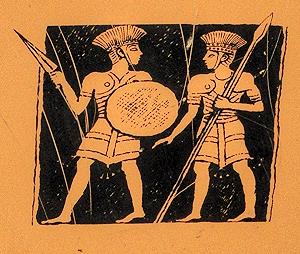
Philistine warriors – on sign of the Tel Zafit national park
The stolen ark did not stay too long in Ashdod, and was moved to Gath ( 1 Samuel 5:2-8 ):
“And when they of Ashdod arose early on the morrow, behold, Dagon was fallen upon his face to the earth before the ark of the LORD. And they took Dagon, and set him in his place again. And when they arose early on the morrow morning, behold, Dagon was fallen upon his face to the ground before the ark of the LORD; and the head of Dagon and both the palms of his hands were cut off upon the threshold; only the stump of Dagon was left to him. Therefore neither the priests of Dagon, nor any that come into Dagon’s house, tread on the threshold of Dagon in Ashdod unto this day. But the hand of the LORD was heavy upon them of Ashdod, and he destroyed them, and smote them with emerods, even Ashdod and the coasts thereof. And when the men of Ashdod saw that it was so, they said, The ark of the God of Israel shall not abide with us: for his hand is sore upon us, and upon Dagon our god. They sent therefore and gathered all the lords of the Philistines unto them, and said, What shall we do with the ark of the God of Israel? And they answered, Let the ark of the God of Israel be carried about unto Gath”.
Where was Biblical Ashdod?
The site of the Bronze and Iron Age periods is located on a the multi-period mound of Tel Ashdod , south and east of the modern city. It was first fortified in the 17th Century BC, and was one of the five large Philistine cities from the 12th Century to the 6th Century BC.
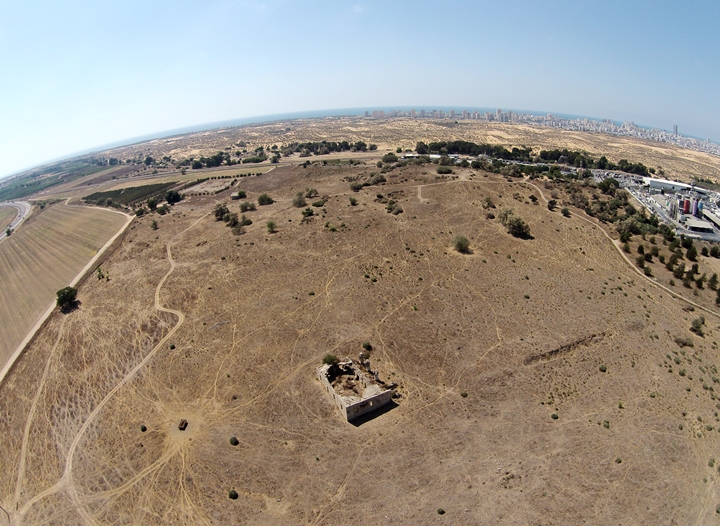
After the Ark of Covenant was in Ashdod and caused damages to their temple, the Philistines moved it to Gath ( 1 Samuel 5:8 ):
“They sent therefore and gathered all the lords of the Philistines unto them, and said, What shall we do with the ark of the God of Israel? And they answered, Let the ark of the God of Israel be carried about unto Gath . And they carried the ark of the God of Israel about thither”.
Where is Gath?
Tel Zafit (Tell es-Safi) is one of the largest Biblical sites in Israel, located halfway between Ashkelon and Jerusalem. The Tel is in the western edge of the Judean foothills (Shephelah) area, bordering the southern coast plains. It is located on the south banks of the Elah stream.
The settlement on the tell started in the 5th millennium BC, reached its peak in the Late Bronze and Iron Age II periods, and was settled until modern times. It is widely accepted by scholars as the Philistine city of Gath – the hometown of Goliath.
While it was stationed in Gath, the Ark continued to bring destruction, so it was moved once again to Ekron (1 Samuel 5:9-10):
“And it was so, that, after they had carried it about, the hand of the LORD was against the city with a very great destruction: and he smote the men of the city, both small and great, and they had emerods in their secret parts. Therefore they sent the ark of God to Ekron…”.
Where is Ekron?
The city was positively identified with the large mound of Tel Miqne (Khirbet al Muqanna) as the Philistine Ekron. It is 18 kilometres north of Gath, east of Kibbutz Revadim. The site was occupied from the Middle Bronze period, when it was heavily fortified by large ramparts, through the Iron Age I when it was occupied by Philistines, until the Iron Age II when it was destroyed by the Babylonians (604 BC).
6: Beth Shemesh
Eventually the Philistines understood that the ark of the Covenant is dangerous to them, so they returned it back to the Israelites.
Its first station in the Israeli territory was in Beth Shemesh. They returned it by a cart. ( 1 Samuel 6 10,12 ):
“And see, if it goeth up by the way of his own coast to Bethshemesh, then he hath done us this great evil: but if not, then we shall know that it is not his hand that smote us: it was a chance that happened to us. And the men did so; and took two milch kine, and tied them to the cart, and shut up their calves at home: And they laid the ark of the LORD upon the cart, and the coffer with the mice of gold and the images of their emerods. And the kine took the straight way to the way of Bethshemesh, and went along the highway, lowing as they went, and turned not aside to the right hand or to the left; and the lords of the Philistines went after them unto the border of Bethshemesh. And they of Bethshemesh were reaping their wheat harvest in the valley: and they lifted up their eyes, and saw the ark, and rejoiced to see it. And the cart came into the field of Joshua, a Bethshemite, and stood there, where there was a great stone: and they clave the wood of the cart, and offered the kine a burnt offering unto the LORD. And the Levites took down the ark of the LORD, and the coffer that was with it, wherein the jewels of gold were, and put them on the great stone: and the men of Bethshemesh offered burnt offerings and sacrificed sacrifices the same day unto the LORD. And when the five lords of the Philistines had seen it, they returned to Ekron the same day.
Return of the Ark – at Beth Shemesh; drawing by Gustav Dore (French artist, 1832-1883)
The residents of Beth Shemesh peeked into the Ark, God killed them, and the Ark was sent to the nearby city of Kiryat Ye’arim:
“And he smote the men of Bethshemesh, because they had looked into the ark of the LORD, even he smote of the people fifty thousand and threescore and ten men: and the people lamented, because the LORD had smitten many of the people with a great slaughter. And the men of Bethshemesh said, Who is able to stand before this holy LORD God? and to whom shall he go up from us? And they sent messengers to the inhabitants of Kirjathjearim, saying, The Philistines have brought again the ark of the LORD; come ye down, and fetch it up to you”.
Where is Beth Shemesh?
Beth Shemesh (“House of the Sun”) was an important Biblical city during the Canaanite and Israelite periods. It is located above the south bank of Nahal Sorek, in the north-east low lands of Judea. It was a border city, located at the meeting point of three civilizations – Canaanites, Israelites and Philistines.
7: Kiriath Jearim
The ark was then brought to Kiriath Jearmin, to the house of Abinadab ( 1 Samuel 7: 1-2 ):
“And the men of Kirjathjearim came, and fetched up the ark of the LORD, and brought it into the house of Abinadab in the hill, and sanctified Eleazar his son to keep the ark of the LORD. And it came to pass, while the ark abode in Kirjathjearim, that the time was long; for it was twenty years: and all the house of Israel lamented after the LORD”.
Where is Kiriath Jearim?
Ruins of the Israelite city of Kiriath Jearim are located on a hill on the north western side of Abu Ghosh. Kiriath Jearim (Hebrew: Kir’yat Ye’arim – Town of Forests”) is the place where the ark of Covenant was stationed after the Philistines returned it to the Israelites. Later, King David moved it to the city of David.
On top of the mound of Tel Kir’yat Ye’arim is the Abbey of the ark of Covenant, built on the foundations of a Byzantine church.
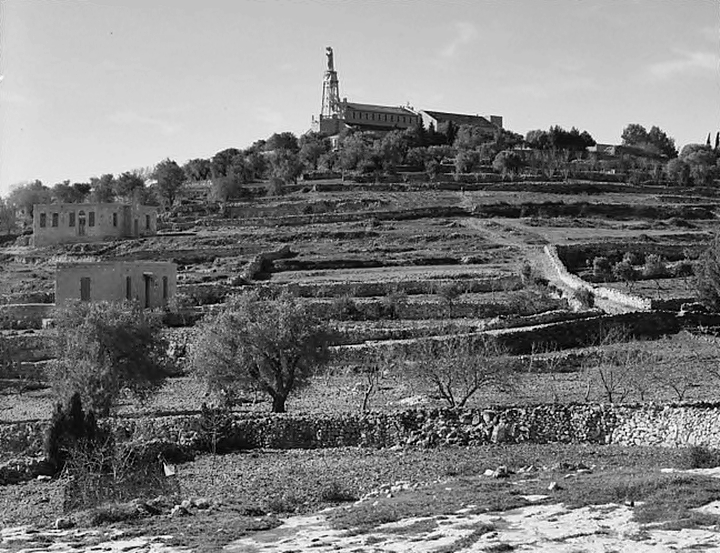
8: Jerusalem
After about 60 years, when David became king, he brought the ark to Jerusalem ( 2 Samuel 6 ):
“Again, David gathered together all the chosen men of Israel, thirty thousand. And David arose, and went with all the people that were with him from Baale of Judah, to bring up from thence the ark of God, whose name is called by the name of the LORD of hosts that dwelleth between the cherubims. And they set the ark of God upon a new cart, and brought it out of the house of Abinadab that was in Gibeah: and Uzzah and Ahio, the sons of Abinadab, drave the new cart. And they brought it out of the house of Abinadab which was at Gibeah, accompanying the ark of God: and Ahio went before the ark. And David and all the house of Israel played before the LORD on all manner of instruments made of fir wood, even on harps, and on psalteries, and on timbrels, and on cornets, and on cymbals”.
King David parades the ark to Jerusalem– AI generated by Stable Diffusion
The ark was temporarily stationed at the house of Obededom the Gittite for 3 months, then brought into the City of David in Jerusalem with a parade led by David ( 2 Samuel 6: 14-16 ):
“And David danced before the LORD with all his might; and David was girded with a linen ephod. So David and all the house of Israel brought up the ark of the LORD with shouting, and with the sound of the trumpet.And as the ark of the LORD came into the city of David…”.
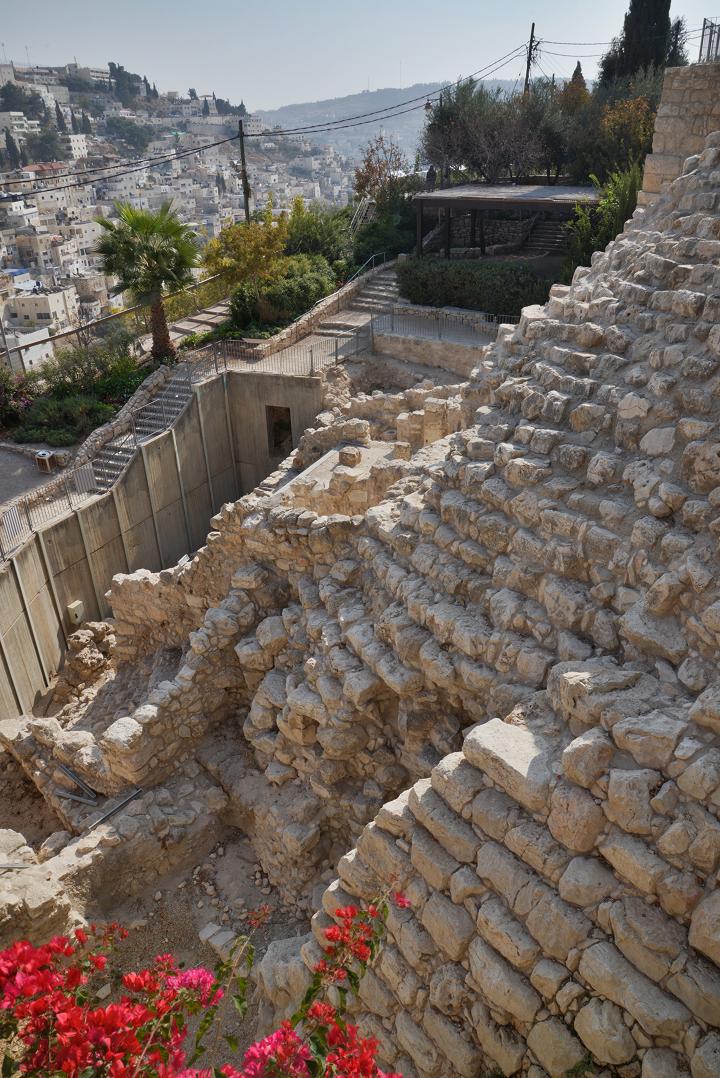
(c) After Jerusalem
The Babylonians captured the city of Jerusalem in 587 BC. The Ark vanished after this conquest.
The ark of covenant – from the synagogue at Capernaum .
The fate of the Ark of the Covenant after the Babylonian conquest of Jerusalem is not definitively known. According to the Bible, the Ark was housed in the First Temple in Jerusalem, which was destroyed by the Babylonians. The Book of 2 Kings describes the Babylonians plundering the Temple and carrying away its treasures, but it does not mention the Ark specifically.
Various theories exist about what may have happened to the Ark after the destruction of the Temple. Some scholars believe that the Ark was captured and taken to Babylon as part of the spoils of war, while others speculate that it may have been hidden or moved elsewhere before the Babylonians arrived. There are also legends and stories that suggest that the Ark was smuggled out of Jerusalem and taken to Ethiopia or even to a secret location in the desert.
However, there is no concrete evidence to support any of these theories, and the true fate of the Ark of the Covenant remains a mystery.
BibleWalks.com – walk with us through the sites of the Holy Land
Biblical articles <<<— Previous Info —<<< All Info >>>— Next Info —>>> Timeline
This page was last updated on Apr 4, 2023 (add text, illustration)
Sponsored links:
ARK OF THE COVENANT ( אֲרֹ֣ון הַבְּרִ֔ית , ἡ κιβωτὸ̀ς τῆς διαθήκης ; the chest of the testament ). A wooden container, the central object in Israel’s preexilic sanctuary.
The Heb. noun אֲרﯴן , H778 , is used 195 times in the OT for the Ark of the covenant.
A. Chest . In itself, אֲרﯴן , H778 , means box or chest; e.g., a money chest ( 2 Kings 12:9 , 10 ; 2 Chron 24:8-11 ) or even a coffin ( Gen 50:26 ), suggesting from the outset the Ark’s primary function as a container (see below, III-A).
B. Attributed qualities . The OT further identifies the Ark under two significant types of attributive phrases:
1. Of deity . Because of its close association with deity, the אֲרﯴן , H778 , is called “the ark of God” thirty-four times ( 1 Sam 3:3 , et al.). Psalm 132:8 speaks of it as “the ark of thy might,” Heb. עֹז , H6437 ; hence when Psalm 78:60 , 61 refers to God’s “power [ עֹז , H6437 ]” and His “glory” as “delivered to captivity” at Shiloh, such terminology would identify the Ark. Other attempts, however (e.g., IDB, I, 225, 226), to discover the Ark concealed within references to God’s might (cf. Pss. 96:6 ; 105:4 ) seem far-fetched, except as these latter vv. were later quoted by David when bringing the Ark to Jerusalem ( 1 Chron 16:27 and 11 ). Because it reveals the presence of deity, thirty-one times the Ark is called the ark of the covenant of Yahweh [the Lord ]” ( Deut 10:8 , etc.), the name which means “I am ” ( Exod 3:14 , cf. vv. 12 , 17 ), which in turn suggests the phrase.
2. Of redemption . Most significant is the title, “ark of the covenant” ( Josh 3:6 , etc., five times) or “ark of the covenant of Yahweh” ( Num 10:33 ; Josh 3:3 ; etc., twenty-seven times; cf. Josh 3:11 ; Judg 20:27 ). The Ark contained the two tables of The Decalogue, q.v., which constituted the documentary basis of God’s redemptive covenant with Israel ( Exod 34:28 , 29 ); cf. Moses’ stress upon the written form of God’s pledge to save His own people, and of their required response in belief and obedience ( 24:4 , 7 ). Moreover, since this redemption involved the life blood of the Redeemer ( 24:8 ), the NT speaks appropriately of the death of the One who makes the “will” ( διαθήκη , G1347 , “testament,” Heb 9:16-18 RSV) and hence of the “ark of his testament” ( Rev 11:19 KJV). Some modern critics have sought to eliminate as redactional interpolations all the earlier OT references to this covenant or testament (HDB, I, 149); but, though missing from certain LXX vv. in 1 Samuel (e.g., 3:3-5 ), the term appears in indisputably ancient passages, both MT and LXX (e.g., Num 10:33 ; 14:44 ; 2 Sam 15:24 ). A corresponding early title appears fourteen times in the phrase, “ark of the testimony” (Heb. עֵדוּת , H6343 , “sign,” “reminder,” Exod 25:22 etc.). עֵדוּת , H6343 , denotes the two stone tables ( 31:18 ; 32:15 ) placed within the Ark ( 25:16 , 21 ) as evidence of the redemptive testament (cf. the interchange of testimony and covenant [ Exod 31:18 ; Deut 9:11 ]). Attempts, therefore, to rule out covenant terminology in favor of some more general title, such as “ark of God,” as original violate the Biblical contexts and rest upon unprovable theories of the evolution of Heb. religion and of conflicting source-strata within the Pentateuch (cf. M. H. Woudstra, The Ark of the Covenant from Conquest to Kingship , 60-83).
Ancient analogies to the Ark have been sought in tent-shrines (Morgenstern), model temples (May), chariots for deities (Torczyner), squared thrones (Kristensen), or even conffins for the gods (Hartmann); but Scripture describes the ’ārōn ( Exod 25:10-16 ; Deut 10:1 , 2 ) as a vessel “unique in the ancient Near East...the repository of the covenant-tables” (K. A. Kitchen, NBD, p. 82).
A. Specifications . The Ark’s pattern, as revealed to Moses at Mt. Sinai, appears in Exodus 25:10-22 .
1. Body . Made of acacia (Heb. שִׁטִּֽים ) wood, the Ark was rectangular, two and one-half cubits long (3 3/4 ft.) and one and one-half cubits (2 1/4 ft.) wide and high ( v. 10 ). Gold plated inside and out, with a gold molding (KJV crown ; Heb. זֵר , H2425 , “border,” v. 11 ), it was supported by four ft., each with a golden ring ( v. 12 ), into which carrying poles of gold plated acacia wood were permanently inserted ( vv. 13-15 ).
2. Cover . The “mercy seat,” literally, כַּפֹּ֫רֶת , H4114 , ἱλαστήριον , G2663 , “place of propitiatory atonement,” was a covering plate of pure gold that corresponded to the dimentions of the Ark (3 3/4 x 2 1/4 ft., v. 17 ). At its two ends and facing each other were two hammered gold cherubim, q.v., with wings overshadowing the plate and with their faces toward it ( vv. 18-20 , Heb 9:5 ). The cherubim (angels) were presumably human in appearance (cf. Ezek 1:5 ), not pagan sphinxes forming a throne (as suggested in BA, 1:1 [1938], 10:3 [1947]); they conveyed the idea of heavenly majesty ( Ezek 1:10 ).
B. Construction . The Ark was built by Bezalel and Oholiab ( Exod 31:6 , 7 ; 37:1-9 ), assisted by other skilled Israelites ( 36:8 ), on Moses’ orders ( Deut 10:3 ). It was to be set within the veil in the most holy place of the Tabernacle ( Exod 26:33 ), the mercy seat placed upon it ( v. 34 ), and anointed with the rest of the Tabernacle ( 30:26 ). Facing both the Ark and the veil stood the altar of incense ( v. 27 ; 30:6 ), though this latter came, in time, to be more closely associated with the Ark’s own inner sanctum ( 1 Kings 8:22 ). Modern scholars increasingly grant that an ark of some sort may go back to the time of Moses (IDB, I, 225); but many would still insist on the Ark’s tradition as totally separated from that of the Tabernacle (cf. G. Von Rad, OT Theology , I, 235).
III. Function
Like the Tabernacle of which it was a part, the Ark’s form was derived from that meaningful pattern which was revealed to Moses upon the Mount ( Exod 25:9 , 40 ); it was an embodiment of covenantal redemption ordained in heaven ( Heb 8:5 ). Furthermore, while its dependence upon the concept of the covenant insured unity for the intended functions of the Ark, salvation’s richness belies Von Rad’s insistence that it is “inconceivable that the throne should also have at the same time served as a container” (ibid., I, 238). Like sacraments today, it could both contain memorials to past redemption and also mediate God’s grace to the present.
A. Container . The initially declared purpose of the עֵדוּת , H6343 , chest, was to hold the “testimony” to God’s salvation ( Exod 25:16 ). Specifically, this meant ( Deut 10:5 ):
1. The decalogue . The stone tables of “the covenant of the Lord ” ( 1 Kings 8:21 ) continued to stay in the Ark. Later Moses’ full “book of the law” was placed “by the side of the ark of the covenant” ( Deut 31:26 ); hence there is a possible connection between the recovery of the lost law book in the days of Josiah and the restoration at that time of the Ark to its proper place in the Temple ( 2 Chron 34:14 ; 35:3 ).
2. Manna and rod . Upon Moses’ orders, Aaron put an omer (c. two quarts) of manna in a jar and placed it “before the Lord ...before the testimony” ( Exod 16:33 , 34 ), though actually done later (KD, Pentateuch , II, 74), as a memorial to God’s provision. Hebrews 9:4 adds that, with the passage of time, the golden jar came to rest inside the Ark. After the revolts of Korah and his associates, when God vindicated the authority of Moses and Aaron by causing the latter’s rod to bud forth buds and almonds, God told Moses also to put this rod “before the testimony, to be kept as a sign...[against] murmurings” ( Num 17:10 ). Although it came to reside within the Ark ( Heb 9:4 ), only the two tables were to be found there by the time of Solomon ( 1 Kings 8:9 ).
B. Sacrament . Beyond containing memorials to what God had already done, the Ark served as well as a sacramental sign of His continuing covenantal activity.
1. Theophany . As God had appeared upon Mt. Sinai, so He promised that His visible presence would abide with His people when they resumed their migration. The glory cloud in which He had wrought deliverance at the Exodus ( Exod 13:21 ; 14:19 , 20 ) would regularly appear between the wings of the cherubim over the mercy seat of the Ark ( 25:22 ; cf. 40:34 ; 2 Sam 6:2 ; Ps 80:1 ). The Ark thus became more than a mere symbol or pledge of God’s presence; it became a “chariot” ( 1 Chron 28:18 ) for real theophanies, paralleling the function of the actual angelic cherubim ( Ps 18:10 ). To be “before the ark” was equivalent to being “before Yahweh” ( Num 10:35 ; Josh 6:8 ). On the other hand, one cannot identify Yahweh with the Ark (cf. W. Eichrodt, Theology of the OT , I, 105), which would be crass idolatry, or confine Him to it as His abode (R. H. Pfeiffer, JBL 45 [1926], 220) or throne (Eichrodt, op. cit., I, 108). Yahweh existed prior to the Ark, voluntarily initiated its construction, and graciously chose to appear over this “footstool” ( 1 Chron 28:2 ). He continued to exist apart from the Ark, despite the above mentioned recent interpretations (IDB, I, 225); for “before Yahweh” need not imply “before the ark” ( 1 Sam 7:2 , 6 ). Finally, He could exist in open opposition to the Ark and repudiate it ( 4:3-11 ): its sacramental value was temporary and ceased when Israel lapsed into the error of those who consider it “a vessel which guarantees the presence of God” (L. Köhler, OT Theology , 121, 122). Yet, when approached in the proper spirit, the institution of the Ark is found to correspond to that of the Lord’s Supper: as a seal of “participation,” communion, with His contemporary presence in the sanctuary ( 1 Cor 10:16 ), and as a type of His ultimate presence in heaven ( Heb 8:5 ; 9:24 ).
2. Revelation . The God who is present is also the God who speaks and acts. He had from the outset promised to communicate His specific laws to Moses “from between the two cherubim that are upon the ark” ( Exod 25:22 ). The first such revelation proved to be the Book of Leviticus ( 1:1 ), and God continued to address Moses in an audible voice from above the mercy seat ( Num 7:89 ). Answers to inquiries were granted to Aaron, as the one who wore the Urim and Thummim, q.v., the “lights and perfections” ( Num 27:21 ), presumably the high-priestly breastplate with its stones that sparkled in the presence of the Ark’s glory cloud ( Lev 16:2 ).
3. Providence . Even without such inquiry, however, God acted through the Ark, for the guidance and the protection of His people. His lifting up of the cloud became the signal for Israel’s wilderness advance ( Num 10:11 ; see below, IV-A), and it was the Ark that went before the tribes “to seek out a resting place for them” ( v. 33 ). God’s presence became also a means for scattering the nation’s enemies ( v. 35 ); cf. the Ark’s functioning as a palladium at Jericho (see below, IV-B) and being designated by the name of Yahweh of Hosts, q.v. (or armies, 2 Sam 6:2 , of Israel, 1 Sam 17:45 ). Yet Morgenstern’s attempt to identify the Ark with Arab tent-shrines (see below, Bibliography), regularly carried into battle and assigned certain oracular functions, appears ill-advised, for the Ark’s use in battle seems to have been exceptional.
4. Atonement . Once every year, however, the Ark achieved its ultimate sacramental significance in the Day of Atonement service, q.v. ( Lev 16:2 ). After insuring his personal safety through a protecting cloud of incense before it ( v. 13 ), Aaron would sprinkle the Ark’s cover, or mercy seat, seven times: first with the blood of a bull, slain as a sin offering for himself, and then with that of a goat for the people ( vv. 14 , 15 ), so as to cleanse Israel “from all [its] sins...before the Lord ” ( v. 30 ). In pictorial fashion, grace (the blood of the testament) thus became an intervening cover between the holiness of God (the glory cloud) and the verdict of divine justice upon the conduct of man (the Decalogue underneath); see Atonement .
IV. History
A. Wilderness . The components of the Ark were brought to Moses at Mt. Sinai at the beginning of the second year of the Exodus ( Exod 39:35 ; 40:17 ).
1. Inauguration . After he had erected the Tabernacle, Moses assembled the Ark and placed it within the sanctuary ( 40:21 , 22 ); the cloud of God’s glory then filled the Tabernacle ( v. 34 ). Moses appointed the Kohathite Levites, under Aaron’s son Eleazar, to be responsible for the Ark ( Num 3:31 , 32 ; cf. Deut 9:25 ). Before it should move, however, the priests were always to cover it with the inner veil, a skin covering, and a blue cloth ( Num 4:5 , 6 ); and the Kohathites could not touch the Ark itself, on pain of death ( v. 15 ).
2. Journeys . Seven weeks later God’s cloud arose ( 10:11 ) and Israel departed from Sinai. While the Tabernacle as a whole occupied a central spot in the column ( 2:17 ), the Ark preceded it by three days’ journey, serving as a guide for Israel’s camping sites ( 10:33 ). Jewish tradition has indeed assumed two arks, one for the broken stone tables, which then preceded the main body (Woudstra, op. cit., 91, 96-99); but Deuteronomy 10:1 appears to summarize the making of the one Ark and not to suggest a second, constructed after the golden calf incident. Formal prayers accompanied each journeying and resting of the Ark: “Arise, O Lord, and let thy enemies be scattered...Return, O Lord, to the ten thousand thousands of Israel” ( Num 10:35 , 36 ). Far from demonstrating an idolatrous identification of Yahweh with the Ark, these prayers actually underline the uncontrollableness, but also the pious hope, of God’s abiding presence. The Ark remained behind, in Israel’s camp at Kadesh, when the presumptuous were defeated at Hormah ( 14:44 , 45 ). Moses had warned them, “Do not go up...for the Lord is not among you” ( v. 42 ).
B. Conquest .
1. Entrance. On important occasions, such as the entrance into Canaan, the Ark might be carried by priests ( Josh 3:3 ; 4:10 ; cf. Deut 31:9 ; 1 Kings 8:3 ) or as a joint undertaking by priests and Levites ( 2 Sam 15:24 ; 1 Chron 15:11 , 12 ). At the very time, therefore, that these priests reached the banks of Jordan, God caused its waters to be stopped up at Adam, q.v. ( Josh 3:15 , 16 ). The Ark then led Israel into the stream bed and stood at midpoint until the nation had crossed over ( v. 17 ). It further participated in the fall of Jericho, when for seven days it was carried about this frontier city before Yahweh caused its walls to collapse ( 6:12-16 , 20 ). Joshua prayed before the Ark during the Ai campaign ( 7:7 ).
2. Settlement . The Ark first rested, apparently, within the Tabernacle at Israel’s camp at Gilgal ( 4:19 ; 9:6 ; 14:6 ); but God later ordained a more central location at Shiloh ( 18:1 ; cf. Jer 7:12 ). It had also been present at Joshua’s renewal of Israel’s covenantal obedience to Yahweh at Mt. Ebal and Mt. Gerizim ( Josh 8:33 ). Though Joshua subsequently summoned a national assembly at nearby Shechem, under an oak that was in “the holy place of Yahweh” (cf. Gen 12:6 , 7 ; 35:2-4 ), there is no indication that the Ark or Tabernacle was ever located there ( מִקְדָּשׁ , H5219 , Josh 24:26 , is not necessarily “sanctuary,” KD, 233).
C. Judges .
1. Shiloh. In time, a house ( Judg 18:31 ) or “temple” ( 1 Sam 1:9 ; 3:3 ) came to be constructed for the Ark at Shiloh, at which annual pilgrimage feasts centered ( Judg 21:19 ; 1 Sam 1:3 ). The boy Samuel slept in this temple ( 1 Sam 3:3 ), though presumably not in the inner sanctuary where the Ark rested, since he failed to associate the voice that he heard with that of God ( v. 7 ). At some earlier period, as an emergency measure, the Ark was moved S from Shiloh to Bethel on the Benjamite border during the war against Gibeah ( Judg 20:26 , 27 ), its theophanic character justifying the offering of sacrifice before it ( 21:4 ; cf. Exod 20:24 ). Evidence is lacking for other claimed transfers of the Ark to other locations, such as to Bochim ( Judg 2:1-5 , ISBE, I, 245). The commonly expressed critical theory of “lotterybox” arks to be found at numerous local sanctuaries is quite untenable; the unwarrantable assumption is made that later scribes wilfully corrupted the noun אֲרﯴן , H778 , into H680 , אֵפֹד֒ , H680 , Ephod, q.v., or אָ֫וֶנ֒ , H224 , “wickedness” (R. H. Pfeiffer, Religion in the OT, 74).
2. Philistia . The pagan theory of having God “in a box,” as if the presence of the Ark would automatically guarantee salvation ( 1 Sam 4:3 , 7 ), was dispelled once and for all when the Philistines captured the Ark at the first battle of Ebenezer, c. 1080 b.c. ( vv. 10 , 11 ). But while Israel’s loss was dramatically illustrated by the name Ichabod ( v. 21 )— אִֽי־כָבﯴד׃֙ , “no glory”—Philistia learned to its sorrow that God’s כָּבﯴד֒ , H3883 , literally “weight,” was still associated with the Ark, as He punished their treatment of it with heavy, כָּבְדָ֥ה ( 5:11 ), judgments on both their gods and their people.
Finally, after a seven months’ captivity in Ashdod and Ekron ( 6:1 ), the Ark was returned to Israel, accompanied by symbolic guilt offerings of gold ( v. 11 ). God’s effective presence was twice more demonstrated, first as He compelled the cows that were hitched to its new wagon to abandon their own calves in order to drag it to Beth-shemesh on the NW border of Judah ( v. 12 ), and then as He struck down seventy of the Beth-shemeshites for irreverently looking inside it ( v. 19 RSV). The Ark was thereafter moved ten m. farther inland, to Kiriath-jearim, where a certain Abinadab consecrated his son Eleazar to care for it ( 7:1 ). No attempt was made to restore it to the Tabernacle; during the twenty years of his judgeship ( v. 2 , HDB, I, 399), 1063-1043 b.c., Samuel stressed direct repentance toward God rather than the sacramental Ark, whose presence Israel had abused.
D. Kingdom . Saul generally neglected the Ark ( 1 Chron 13:3 ), though he did have it with him and called for it just prior to the battle of Michmash, 1041 b.c. ( 1 Sam 14:18 ; “ephod,” LXX).
1. On Zion . David, however, after his capture of Jerusalem in 1003 b.c., had the Ark brought to his new capital ( 2 Sam 6 ; 1 Chron 13 ; 15 ). Indeed, while the Philistines’ innovation of a cart might be excused through ignorance, the Israelites’ failure to observe the precise Pentateuchal instructions for carrying it could not; and Abinadab’s descendant Uzzah was struck down for his resulting sacrilege, even though well-intentioned ( 2 Sam 6:6 ). After a three months’ delay at the house of the Levite Obed-edom ( v. 11 ), the Ark was conducted with joy and sacrifices to a tent, אֹ֔הֶל ( v. 17 ), or booth, סֻכָּה , H6109 , ( 11:11 ); “lowly abode” (Woudstra, op. cit., 121), with curtains ( 7:2 ), that David had temporarily erected for it on Mt. Zion ( Pss 3:4 ; 9:11 ). The high priest Abiathar was made responsible for the Ark ( 1 Kings 2:26 ) and a sacrificial service ( 1 Chron 16:1 ), and an organization of Levitical singers and doorkeepers was instituted under Asaph and Obed-edom ( 6:31-48 ; 16:4-6 , 37 , 38 ). Certain great Psalms seem to have been composed for the occasion and for its subsequent celebration ( Pss 24:7-10 ; 132:8 ). No hint, however, exists of any annual Babylonian style “enthronement festival” for Yahweh: sentiments such as “God has gone up with a shout” ( Ps 47:5 ) express rather His reign over all the earth ( vv. 6 , 7 ; cf. Ps 11:4 ; Hab 2:20 ).
Subsequently, during Absalom’s revolt, Zadok and Abiathar sought to bring the Ark to David in his flight from Jerusalem ( 2 Sam 15:24 ); but the king refused to treat it as a talisman or palladium, placing instead his trust directly in God ( v. 25 ).
2. On Moriah . While Solomon, too, had sacrifices offered before the Ark in its temporary shelter ( 1 Kings 3:15 ), his greatest achievement was to carry out his father’s plans for erecting a permanent Temple ( 1 Chron 22:19 ; 28:2 , 11 , 19 ) on Mt. Moriah, to the N of Zion ( 2 Chron 3:1 ). The Ark with its cherubim cover was placed within the inner sanctuary, or “oracle” ( 1 Kings 6:19 KJV), overshadowed by two huge, gold-plated, olive wood cherubim, fifteen ft. in height and wingspread ( vv. 23-28 ). Upon its installation, the glory cloud filled the house, just as it had filled the Tabernacle ( 8:1-11 ); and Solomon repeated the old wilderness prayer, “Arise, O Lord God, into thy resting place” ( 2 Chron 6:41 ). Here the Ark remained, with only its poles visible ( 5:9 ). Despite a temporary removal under the apostate King Manasseh ( 35:3 ; cf. 33:7 ), it so remained until its presumed destruction when Nebuchadnezzar burned the Temple in 586 b.c.
E. Later references . The postexilic second Temple had no Ark (Jos. War. V. 5), though today’s Jewish synagogues are equipped with “arks,” located on the side toward Jerusalem and designed to hold the Torah. Even before the fall in 586 b.c., Jeremiah had predicted that in days to come the Ark would no longer be sought ( Jer 3:16 ), because all Jerusalem would eventually become the throne of Yahweh ( v. 17 ), the symbolism of the Ark being replaced by direct faith in God under the new covenant ( 31:31-34 ). As the climax to Biblical history, in a vision of the new heavens after God’s final judgment ( Rev 11:18 ), John saw “the ark of his covenant” ( v. 19 ), indicative of the ultimate accomplishment of that testamentary redemption for which it had consistently stood.
Bibliography W. R. Arnold, Ephod and Ark (1917); H. G. May, “The Ark—a Miniature Temple,” AJSL, LII (1936), 215-234; J. Morgenstern, The Ark, the Ephod, and the “Tent of Meeting” (1945); F. M. Cross, “The Tabernacle,” BA, X (1947), 45-68; A. Bentzen, “The Cultic Use of the Story of the Ark in Samuel,” JBL, LXVII (1948), 37-53; N. H. Tur Sinai, “The Ark of God at Beit Shemesh (I Sam. vi) and Perez ’Uzza (II Sam. vi, I Chron. xiii),” VT, I (1951), 275-286; T. Worden, “The Ark of the Covenant,” Scripture , V (1952), 82-90; J. R. Porter, “The Interpretation of 2 Samuel VI and Psalm CXXXII,” JTS, NS, V (1954), 161-173; R. E. Hough, The Ministry of the Glory Cloud (1955); W. Eichrodt, Theology of the OT (1961), I, 102-112; G. Von Rad, OT Theology (1962), I, 234-241; J. B. Payne, The Theology of the Older Testament (1962), 363-369; M. H. Woudstra, The Ark of the Covenant from Conquest to Kingship (1965).

What Is So Important about the Ark of the Covenant?

I don’t know if you are a fan of the Indiana Jones movies, but one of them was called “Raiders of the Lost Ark.” In the movie, Indiana goes on an expedition looking for the Ark of the Covenant. Obviously, their journey was fictional, even though it made for great theater, if you like those kinds of pictures.
However, the Ark of the Covenant itself was not fictional but very real and extremely important to the nation of Israel. If you are not sure what the Ark of the Covenant is, let me give you a quick answer which I will expound on. The Ark represented the presence of God going with the people of Israel and his covenant to them.
Now let’s see what else we can learn to help us understand – what is the Ark of the Covenant?
Photo credit: Wikimedia Commons
Where Does the Bible Discuss the Ark of the Covenant?

In describing the Ark and the process for building it, God gives his people some very meticulous details. You can read the full description of these in Exodus 25 . God made a request that the people of Israel bring an offering for the building of a sanctuary for him.
“The Lord said to Moses, ‘Tell the people of Israel to bring me their sacred offerings. Accept the contributions from all whose hearts are moved to offer them” ( Exodus 25:1-2 ).
“Have the people of Israel build me a holy sanctuary so I can live among them. You must build this Tabernacle and its furnishings exactly according to the pattern I will show you” ( Exodus 25:8-9 ).
In reading these verses we see that God’s desire was to live among his people. He required an offering, from those who were willing, to build a sanctuary for his presence to dwell among the people on earth.
On a side note, does that sound familiar to you? In today’s terms, God still requests an offering, which is your heart, from those who are willing. This means that you have to let him in of your own free will, so he can live in you and among you. Remember Jesus’ words in Revelation 3:20 :
“Behold, I’m standing at the door, knocking. If your heart is open to hear my voice and you open the door within , I will come in to you and feast with you, and you will feast with me.”
Photo credit: Unsplash/Aaron Burden
Why Is the Ark So Important in the Old Testament?

With God’s desire to be with his people, he had to build a place for his presence to dwell amongst them. Remember in the Old Testament God’s Spirit or presence dwelt among his people. In the New Testament God’s Spirit dwells within his people. What the Ark of the Covenant would become is the place where God’s presence dwelt. Here are some of the dimensions for building the ark. Again, you can read the full details in Exodus 25 .
“Have the people make an Ark of acacia wood — a sacred chest 45 inches long, 27 inches wide, and 27 inches high. Overlay it inside and outside with pure gold, and run a molding of gold all around it. Cast four gold rings and attach them to its four feet, two rings on each side. 13 Make poles from acacia wood, and overlay them with gold. Insert the poles into the rings at the sides of the Ark to carry it. These carrying poles must stay inside the rings; never remove them. When the Ark is finished, place inside it the stone tablets inscribed with the terms of the covenant, which I will give to you. ‘Then make the Ark’s cover — the place of atonement — from pure gold. It must be 45 inches long and 27 inches wide” ( Exodus 25:10-17 ).
As you can see, very precise details. What is also interesting is what is in the Ark of the Covenant . We see God’s commandments and the place for atonement. Keep in mind the building of the Ark of the Covenant was part of the larger building of the tabernacle. So as important as the Ark was, it was one piece of a larger framework.
Photo credit: ©Getty Images/megaflopp
What Was the Ark Used For?

When the tabernacle was completed, the Ark was eventually placed in the Most Holy Place or the Holy of Holies. Exodus 40:1-3 tells us “Then the Lord said to Moses, ‘Set up the Tabernacle on the first day of the new year. Place the Ark of the Covenant inside, and install the inner curtain to enclose the Ark within the Most Holy Place.’”
One of the things about the Ark of the Covenant and the presence of God is that it was serious business. You couldn’t just enter the Most Holy Place any way you wanted to. If you did, it meant certain death. Here is God’s warning to Aaron:
“The Lord spoke to Moses after the death of Aaron’s two sons, who died after they entered the Lord’s presence and burned the wrong kind of fire before him. The Lord said to Moses, ‘Warn your brother, Aaron, not to enter the Most Holy Place behind the inner curtain whenever he chooses; if he does, he will die. For the Ark’s cover — the place of atonement — is there, and I myself am present in the cloud above the atonement cover” ( Leviticus 16:1-2 ).
As I mentioned, only the high priest - in this case Aaron and his descendants - were allowed to even enter the Most Holy Place. The high priest, beginning with Aaron and his sons, eventually flowing down to the Levites, would enter once per year on Yom Kippur, the Day of Atonement, and offer the sacrifice for the sins of the people.
There was also a long list of requirements necessary before Aaron, and eventually the high priests after him, could enter the Most Holy Place. These are detailed in Leviticus 16 . So aside from it being the place where God’s presence dwelt, it was also the place of annual sacrifice for the atonement of the people.
Presence of God or Good Luck Charm?

The reason the Ark was so important to the Israelites was because it represented God’s presence being with them. They knew that as long as God was with them, then God’s provision and God’s protection would also be with them as well. Sadly, eventually the nation of Israel began to see the Ark not as representative of God’s presence but as a good luck charm.
In 1 Samuel 4 after being defeated by the Philistines they decided to bring out the Ark because that would ensure certain victory. It didn’t and they were soundly defeated losing 30,000 soldiers and facing the embarrassment of the Philistines capturing the Ark.
The Israelites completely missed what the Ark of the Covenant was supposed to be and sometimes we do the same to God. We treat God as the good luck charm to get us out of trouble regardless of how we have been living. The idea of living however you want, disregarding everything God asks you to do, living a life of total disobedience and then just saying a prayer when you are in trouble and everything will work out is not how it works. God is not obligated to help those who choose to live in willful disobedience. The person that God looks to help is the one who has completely put their trust in him.
“For the eyes of the Lord range throughout the earth to strengthen those whose hearts are fully committed to him” ( 2 Chronicles 16:9 ).
The Ark was not a good luck charm back then and God is not one now.
Photo credit: ©Getty Images/Hakase
Why Did People Die if They Touched the Ark?

There is the story of transporting the Ark in 1 Chronicles 13 . Long story short the Philistines had captured the Ark, as we mentioned earlier, but when they had it they experienced God’s judgment so they sent it back to the Israelites. In his zeal, David sought to move the Ark to Jerusalem, however he did not move it according to the instructions God had previously given.
Even though the nation of Israel had great celebration and rejoicing over moving the Ark, they neglected to follow God’s instructions. This is a reminder that zeal alone is not enough and to make sure you are following what God tells you to do.
They decided to transport the Ark on a cart pulled by oxen and when one of the oxen stumbled Uzzah reach out to steady the Ark and he died when touching it. The reason Uzzah died is because David did not follow the instructions God had given for the way to transport the Ark. Only the Levites were allowed to transport the Ark. Later however David learned his lesson.
“David now built several buildings for himself in the City of David. He also prepared a place for the Ark of God and set up a special tent for it. Then he commanded, ‘No one except the Levites may carry the Ark of God. The Lord has chosen them to carry the Ark of the Lord and to serve him forever’” ( 1 Chronicles 15:1-2 ).
This is a simple reminder of how important it is to do things God’s way. If you do then he will honor your obedience.
Photo credit: ©Getty Images/Aaron Amat
What Happened to the Ark of the Covenant?

I started this article talking about Indiana Jones. That is important not just in talking about what the Ark of the Covenant is, but where it is today.
The truth is no one really knows. There are lots of thoughts and ideas but nothing concrete. There is an interesting article about what happened to the Ark on Compelling Truth .
We know that after the Babylonians conquered Jerusalem they took over the temple, but we don’t know what became of the Ark. I guess that’s why the story of trying to find it makes for a good movie.
As you can see the Ark was vital to Israel in the Old Testament. It played an important role in their everyday lives. If you look at the history of the kings in Israel however, it’s safe to say that over time the importance and value of the Ark shifted depending on who was king. What the Ark of the Covenant meant to some kings it did not have the same level of sacredness to other kings.
When you fast forward to today there is good news. Regardless of what happened to the Ark, you have access to God’s presence. There is no longer a curtain between you and the Most Holy Place. Because of the atonement for our sins made by Jesus Christ, you now can come into the presence of God . This is a special privilege reserved not just for the Levites but for all who carry Christ in their hearts as Savior and Lord. This gives you access.
I encourage you today to take advantage of what Christ has done for you and spend time in that Most Holy Place. After all God wants you there because his desire has not changed. He wants to dwell among his people, and that my friend means you.
Photo credit: ©Getty Images/Christian Chan


A sketch showing what the Ark of the Covenant might have looked like.
- HISTORY & CULTURE
Why the Ark of the Covenant is one of history's enduring mysteries
Archaeologists are skeptical that this ancient artifact can be found.
For centuries, people have tried in vain to locate and recover the Bible's most sacred objects. Among the most sought-after of these religious antiquities is the famed Ark of the Covenant.
This legendary artifact is the ornate, gilded case said to have been built some 3,000 years ago by the Israelites to house the stone tablets on which the Ten Commandments were written. Biblical accounts describe the Ark as large, about the size of a 19th-century seaman's chest, made of gold-plated wood, and topped with two large, golden angels. It was carried using poles inserted through rings on its sides.
The Ark has been linked to several of the Old Testament's miracles. It is said to have cleared impediments and poisonous animals from the path of the Israelites during the Exodus. When the Israelites crossed the Jordan River into the Promised Land, the Bible says that the river stopped flowing the moment the Ark-bearers set foot in it.
And many believe that when the Israelites besieged Jericho, they carried the Ark around the city for a week, blowing trumpets until, on the seventh day, the walls fell down, allowing easy conquest. ( This is what archaeology is telling us about the real Jesus. )
But in 597 and 586 B.C., the Babylonian Empire conquered the Israelites, and the Ark, at the time supposedly stored in the Temple in Jerusalem, vanished from history. Whether it was destroyed, captured, or hidden–nobody knows.
One of the most famous claims about the Ark's whereabouts is that before the Babylonians sacked Jerusalem, it had found its way to Ethiopia, where it still resides in the town of Aksum, in the St. Mary of Zion cathedral . Church authorities, however, say only one man, the guardian of the Ark, is allowed to see it, and they have never permitted it to be studied for authenticity.
Another claim is that the Ark was hidden in a warren of passages beneath the First Temple in Jerusalem before the Babylonians destroyed it in 586 B.C. But that theory can't be tested either, because the site is home to the Dome of the Rock shrine, sacred in Islam. Digging beneath it simply isn't an option.
Other more dubious claims exist, too. But perhaps the most famous quest for the Ark was on the big screen. In the 1981 movie Raiders of the Lost Ark, adventure hero Indiana Jones must find the Ark before the Nazis, who intend to use its power for world domination.
Searches for such biblical relics are compelling, says archaeologist and National Geographic Society fellow Fred Hiebert, but ultimately doomed to failure. Even if there is an ancient, Ark-like object in Ethiopia, he asks, how do you determine it's the one from the Bible?
"We are talking about things [at] the crossroads between myth and reality," he said. "I think it's great to have stories like [that of] the Ark of the Covenant. But I do not believe, as a field archaeologist, that we can use the scientific method to prove or disprove [them]."
For Hungry Minds
Related topics.
- ARCHAEOLOGY
You May Also Like

These ancient texts were once unreadable. Now technology is decoding them
Who was Mary Magdalene? Historians are still trying to figure that out.

An archaeologist suspected something special was buried here. She was right.

Why this Bronze Age village became known as ‘Britain’s Pompeii’

U.K. treasure hunters are finding a record number of ancient artifacts—but who gets to keep them?
- Environment
- Paid Content
- Photography
- Perpetual Planet
History & Culture
- History & Culture
- History Magazine
- Mind, Body, Wonder
- Terms of Use
- Privacy Policy
- Your US State Privacy Rights
- Children's Online Privacy Policy
- Interest-Based Ads
- About Nielsen Measurement
- Do Not Sell or Share My Personal Information
- Nat Geo Home
- Attend a Live Event
- Book a Trip
- Inspire Your Kids
- Shop Nat Geo
- Visit the D.C. Museum
- Learn About Our Impact
- Support Our Mission
- Advertise With Us
- Customer Service
- Renew Subscription
- Manage Your Subscription
- Work at Nat Geo
- Sign Up for Our Newsletters
- Contribute to Protect the Planet
Copyright © 1996-2015 National Geographic Society Copyright © 2015-2024 National Geographic Partners, LLC. All rights reserved

JourneyOnline
The Ark of the Covenant
Exodus 25:10-16; Numbers 4:4-6
The ark was a container, or chest, that was made to the exact specifications given to Moses by the Lord, and was primarily a storage place for the testimony, or Ten Commandments.
It was 45 inches long, 27 inches wide, and 27 inches high. It was made of acacia wood, covered with gold inside and out, and had a gold molding around the top. The mercy seat, with the two golden cherubim, was the cover for the ark and, though they were separate items, together they made up the one article commonly known as “the ark of the covenant.” However, each item carries its own particular significance and will be considered in separate articles.
Exodus 25:22 says, “‘There I will meet with you,

Four gold rings were fastened to the corners, and two poles made of acacia wood covered with gold were placed in the rings so the Kohathites could carry the ark. The poles were to remain in place, never to be removed. The ark, along with its cover, the mercy seat, was the only item in the Holy of Holies and was seen only once a year, by the high priest, on the Day of Atonement.
Only the Kohathites were permitted to carry the ark (compare 1 Chronicles 13:7-10 with 1 Chronicles 15:1-2), which was covered by the veil that separated the Holy Place from the Holy of Holies. They were to cover the veil with the hides of sea cows, and finish by spreading a blue cloth over the top of the ark.
The ark was a symbol of protection, preservation, and deliverance
as can be seen in the two other arks mentioned in Scripture: Noah’s ark and the ark of Moses (Exodus 2:3)–and contained the Ten Commandments, the Law of God. Hebrews 9:4 says that Aaron’s rod and a golden pot of manna were later added, but upon entering Solomon’s Temple, only stone tablets remained (1 Kings 8:9).
These items–the Ten Commandments, Aaron’s rod, and the pot of manna–are three pictures of our Lord Jesus Christ. First, He was the fulfillment of the Law of God (Matthew 5:17), who said, “‘I have come to do your will, O God'” (Hebrews 10:7; see also Psalm 40:8). In Matthew 5:17, He said, “‘Do not think that I have come to abolish the Law or the Prophets; I have not come to abolish them but to fulfill them.'” Second, He is the Bread of Life (John 6:31-35, 48-58), whose body (manna) was given for the world, but whose nature is divine (golden pot). Third, Christ has been given power over death. Aaron’s rod–a symbol for the chosen priesthood of God (Numbers 16 and 17)–was a dead stick until God made it produce leaves and almonds, and it presents a picture of the risen Christ, who said, “‘I am the Living One; I was dead, and behold Iam alive for ever and ever!'” (Revelation 1:18, NIV). Like the rod, He was “a root out of dryground” (Isaiah 53:2, NIV). Furthermore, He was also “cut off out of the land of the living” (Isaiah 53:8, ESV). When God caused the rod to blossom and produce fruit, it pointed to Christ, who was once a dead body in the ground, but who was resurrected and blossomed, and who finally produced fruit, which is the Church.
The ark is given preeminence among all the tabernacle furnishings in two significant ways.
- First, when God gave directions regarding the construction of the tabernacle, the first item He described was the ark and the mercy seat.
God always starts with the heart of a matter, and then proceeds outward. In studying the tabernacle furniture, we started with the outer court and worked our way into the Holy of Holies, concluding our journey where God begins. God, however, begins His story where He desires us to finally end up. Perhaps that is why the story of man begins in a garden called Eden, a place created by God especially for man. At the end, man will live in heaven, a place created by God for man to live for eternity.

This can be seen in the way the high priest approached the ark on the Day of Atonement. The first item he brought before God was incense (Leviticus 16:12), only later to return with blood. In other words, the sweet fragrance of the person of Christ came before the presentation of His work. When John the Baptist (John 1:29, ESV) announced Christ’s presence, he said, “‘Behold, the Lamb of God [His person], who takes away the sin of the world[His work]!'” Paul reflects this same attitude in 1 Corinthians 2:2: “I decided to know nothing among you except Jesus Christ [His person] and him crucified[His work].” Once again, John says in Revelation 5:6 (NIV), “Then I saw a Lamb[His person],looking as if it had been slain[His work].” This truth is also reflected in the Lord’s description of the vessels: First, He speaks of the ark, the person of Christ, and then He describes the mercy seat and the other vessels, which describe His work.
Related Categories
Bible passages.
What to Do When Life Knocks You Down
journey devotionals
Sign up for daily lessons to feed your spirit, i have a question.
Questions are good! Let us know your thoughts or concerns and we’ll connect with you.
What's Next
We would love to answer any question you have or help suggest next steps on your journey.
I Made A Decision
Jesus offers you forgiveness and a new life. Let us know about your decision.
I Need Prayer
If you would like someone to pray for you, click the button and we’ll connect with you.
How to go to Heaven
How to get right with god.

What happened to the Ark of the Covenant?
For further study, related articles, subscribe to the, question of the week.
Get our Question of the Week delivered right to your inbox!

Header Text
Footer Text
- The Landscapes of Palestine
- The Rulers of Palestine
- The Climate of Palestine
- Major Jewish Religious Festivals
- What is the New Testament?
- Who wrote the Gospels?
- English Translations of the New Testament
- John's mission foretold
- The birth of John
- John's message
- John begins baptising
- John criticises Herod
- Was John the promised Elijah?
- Jesus's birth announced
- Mary & Joseph go to Bethlehem
- The birth of Jesus
- Shepherds visit the infant
- Jewish religious rituals
- Wise men visit Jerusalem
- The holy family flees to Egypt
- The holy family returns to Nazareth
- Jesus grows up
- Jesus starts his ministry
- Jesus is tempted
- Jesus returns to Galilee
- Jesus goes back to Nazareth
- Jesus travels to Jerusalem
- Jesus passes through Samaria
- Jesus performs healing miracles
- Jesus teaches in Capernaum
- Jesus's teachings on a hillside
- Jesus upsets the Pharisees
- Jesus crosses the Sea of Galilee
- Jesus heals & teaches in Jerusalem
- Jesus teaches how to receive the Holy Spirit
- Jesus journeys among the Gentiles
- Jesus walks on the Sea of Galilee
- Jesus in Tyre and Sidon
- Who is Jesus?
- Jesus is changed on the slopes of Mount Hermon
- Jesus pays the Temple Tax
- Jesus claims God's personal name
- The Parable of the Good Samaritan
- The Parable of the Prodigal Son
- Lazarus, Come out!
- Jesus's entry into Jerusalem
- Jesus curses a fig tree
- Jesus heralds the end of the sacrificial system
- Jesus in Jerusalem during Passover week
- The Parable of the Sheep & the Goats
- Paying taxes to Caesar
- Jesus is betrayed
- The Last Supper
- Jesus crosses the Kidron Valley
- Jesus is arrested
- Jesus is taken to the Praetorium
- Jesus is tried by Pilate
- The death of Judas
- Jesus is executed by crucifixion
- The Pharisees mount a guard on the tomb
- Jesus rises from the tomb
- Jesus appears to his followers
- Jesus is taken into God's presence
- Jesus appears to Peter, James & Paul
- Who were Jesus's followers?
- The believers are filled with the Holy Spirit
- Peter & John heal a crippled man
- The believers share their possessions
- Opposition in Jerusalem
- Stephen is killed & the believers are scattered
- Philip's Journeys
- Peter's Journeys
- Peter hands over the leadership to James
- The Gentile Church at Antioch
- Saul's Early Life
- Saul persecutes the believers
- The beginning of Saul's ministry
- Saul & Barnabas in Antioch & Jerusalem
- Paul starts his 1st Missionary Journey
- Paul, Barnabas & Mark in Cyprus
- Paul, Barnabas & Mark sail to Pamphylia
- Paul & Barnabas travel inland
- Paul & Barnabas in Iconium
- Paul & Barnabas in Lystra
- Paul & Barnabas return to Perga
- Paul & Barnabas return to Antioch in Syria
- Paul & Barnabas attend the Council of Jerusalem
- Paul & Barnabas take the decision to Antioch
- Paul starts his 2nd Missionary Journey
- Paul travels to Troas
- Paul sails across to Europe
- Paul arrives in Philippi
- Paul travels to Amphipolis & Apollonia
- Paul in Thessalonica
- Paul in Berea
- Paul in Athens
- Paul in Corinth
- Paul returns to Jerusalem
- Paul starts his 3rd Missionary Journey
- The Ephesians are filled with the Holy Spirit
- The silversmiths riot in Ephesus
- Paul travels to Corinth
- Paul returns to Macedonia
- Eutychus falls from a window in Troas
- Paul leaves for Assos
- Paul sails to Miletus
- Paul visits Cos and Rhodes
- Paul visits Philip in Caesarea
- Paul meets violent opposition in Jerusalem
- Paul addresses the crowds
- Paul in Caesarea
- Paul appeals to Emperor Nero
- Paul sets sail for Rome
- Paul is shipwrecked
- Paul in Malta
- Paul heads for Rome
- An Introduction to Paul's Letters
- Paul's Letter to Galatia
- Paul explains his personal background
- Alive in Christ
- Set free from Slavery
- The Fruit of the Spirit
- Paul's 1st Letter to Thessalonica
- Paul hopes to visit Thessalonica
- The Day of the Lord
- How Christians should behave
- Paul's 2nd Letter to Thessalonica
- The coming Day of the Lord
- Saved by the power of the Holy Spirit
- Paul's 1st Letter to Corinth
- The Holy Spirit helps us understand
- Temples of the Holy Spirit
- Advice on Marriage & Relationships
- Running the Race of Life
- The Lord's Supper
- Spiritual Gifts
- Worship in the early church
- The risen Lord Jesus appears to his followers
- Paul's 2nd Letter to Corinth
- Paul explains his revised plans
- Christ's Victory Parade & the New Covenant
- How God changes lives
- Paul's plans for the future
- Paul defends himself against criticism
- Paul's weaknesses
- Paul's Letter to Rome
- How to be put right with God
- God's covenant promise fulfilled
- New life in the power of the Holy Spirit
- Persecution by the Jews
- Paul's mission
- Paul's Letter to Ephesus
- God's secret plan
- The new life
- The armour of God
- Paul's Letter to Colossae
- Jesus is exactly like God
- Saved by Christ's death
- Practical advice for believers
- Paul's Letter to Philemon at Colossae
- Paul's Letter to Philippi
- To live is Christ
- Warnings about the Jewish Law
- Introduction to Paul's Pastoral Letters
- Paul's 4th Missionary Journey
- Paul's 1st Letter to Timothy in Ephesus
- Worship among the believers
- Holding onto the truth
- Paul's Letter to Titus in Crete
- Appointing Church Leaders
- Paul's 2nd Letter to Timothy at Ephesus
- The 'last days'
- Paul's Final Sacrifice
- The Letter to the Jewish believers
- God speaks through the prophets & Jesus
- Jesus is greater than Moses
- Jesus speaks to God for believers
- Jesus - a priest like Melchizedek
- The New Covenant agreement
- God does not want animal sacrifices
- Having faith
- Looking forwards, not backwards
- The General Letters: James, Jude, Peter & John
- The Letter of James to the Jewish believers
- Faith without actions is worthless
- The power of words
- The Letter of Jude to the Jewish believers
- Signs of 'the last days'
- The 1st Letter of Peter to the Jewish believers
- The living hope
- Living stones
- Baptism & the flood
- The 2nd Letter of Peter to the Jewish believers
- Peter speaks out against immorality
- The 'Last Days' & The 'Day of the Lord'
- Introduction to John & his 3 Letters
- The 1st Letter of John
- The 'logos' of God
- The 'new' commandment
- The last days
- Filled with the Holy Spirit
- Love one another
- God's love drives away fear
- The 2nd Letter of John
- The 3rd Letter of John
- Introduction to the Revelation of John
- John's Letter to the 7 Churches of Asia Minor
- The messages to the believers on the coastal plain
- The messages to the believers living inland
- John's vision of God's heavenly rule
- The satan's rebellion against God
- The downfall of Rome & it's empire
- The resurrection of the dead
- The final judgement
- The new heaven & the new earth
- Introduction to the Romano-Jewish world
- Roman Emperors in the New Testament
- Jewish Religious Leaders
- New Testament Languages
- Jewish & Greek Names
- Jewish & Roman Currency
- Jewish Nationalists
- The Romano-Jewish War
- Constantine & the Helena Churches
- Ecumenical Church Councils
- Palestine - A Land Bridge
- Routes across Palestine
- The River Jordan
- Ancient Israel
- The Message of the Old Testament
- Who wrote the Old Testament?
- Dating events in the Old Testament
- The Biblical account of Creation
- Adam's Journey from the Garden of Eden
- Cain is sent on a journey to the east of Eden
- Enoch founds a city in Mesopotamia
- Noah journeys to Aratta on the flood
- The Colonisation of the Ancient World
- The Tower of Babylonia
- Abram's Journey to Canaan
- Abram settles in Canaan
- Abram travels north to rescue Lot
- The birth of Ishmael
- Sodom and Gomorrah are destroyed
- Abraham journeys south and Isaac is born
- Abraham's sacrifice on Mount Moriah
- Abraham's wife dies at Hebron
- Abraham seeks a wife for Isaac
- Abraham dies at Hebron
- Isaac moves to Beersheba
- Jacob cheats Esau and flees to Mesopotamia
- Jacob returns to Canaan and meets Esau
- God blesses Jacob at Bethel
- Joseph is sold into slavery in Egypt
- Joseph becomes Vizier of Egypt
- Jacob's family joins Joseph in Egypt
- The Israelites in Egypt
- Prince Moses escapes to Midian
- Moses is called by God at Mt Sinai
- Egypt suffers ten plagues
- The Israelites flee from Egypt
- The Israelites cross the Sea of Reeds
- Moses receives the Ten Commandments
- Moses constructs the Ark of the Covenant
- The Israelites rebel against God
- The Israelites are counted
- Hardships encountered in the desert
- Moses sends spies into Canaan
- Korah leads a rebellion against Moses
- The Israelites remain at Kadesh Barnea
- The Israelites attempt to enter Canaan
- The Israelites journey north to Moab
- The Israelites defeat King Sihon and King Og
- Balaam blesses the Israelites
- The Israelites defeat the kings of Midian
- The boundaries of Canaan are agreed
- More laws and religious practices
- Moses dies at Mount Nebo
- The Israelites cross the River Jordan
- The Israelites conquer Jericho and Ai
- Joshua builds an altar at Mt Ebal
- Joshua is deceived by the Hivites
- Joshua conquers the Southern Cities
- Joshua embarks on the Northern Campaign
- Canaan is divided among the twelve tribes
- Six Cities of Refuge are set up
- Joshua says farewell
- The Israelites fight the remaining Canaanites
- God appoints inspirational leaders
- Israel under the 'judges': Othniel and Ehud
- Deborah and Barak defeat Sisera
- Gideon defeats the Midianites
- Abimelech becomes king
- Jephthah defeats the Ammonites
- Samson challenges the Philistines
- The conquest of Laish
- Gibeah is destroyed & the Benjamites punished
- Job is faced with adversity
- Ruth's journey to Bethlehem
- Samuel is taken to Shiloh
The Ark of the Covenant is captured at Aphek
- The Ark is taken to Ashdod
- The Ark is moved to Ekron
- The Ark is returned to the Israelites
- Samuel administers justice from Ramah
- Saul's Journey to Kingship
- Jonathan demolishes the Philistine pillar at Geba
- Samuel condemns Saul at Gilgal
- David defeats Goliath of Gath
- Saul becomes jealous of David
- Samuel dies and is buried at Ramah
- David marries Abigail
- Saul is killed by the Philistines at Mt Gilboa
- David becomes King of Judah and Israel
- David captures Jerusalem
- The Ark of the Covenant is brought to Jerusalem
- David's victories over Israel's neighbours
- David's affair with Bathsheba
- Absalom's flight & his rebellion against David
- Further events during David's reign
- Solomon succeeds his father David
- Solomon's alliance with Egypt
- Solomon builds the Temple in Jerusalem
- Solomon builds a palace and furnishes the Temple
- The Ark of the Covenant is installed in the Temple
- Solomon rebuilds the cities of Israel
- Solomon's overseas trading expeditions
- The Queen of Sheba travels to Jerusalem
- Solomon builds a network of chariot cities
- Solomon turns away from God
- Solomon dies and the kingdom is divided
- Jeroboam builds temples to worship Baal
- Israel and Judah fight each other
- Israel descends into civil war
- Jezebel kills the prophets & Elijah escapes
- Elijah challenges the prophets of Baal
- Elijah organises the opposition to King Ahab
- King Ahab seizes Naboth's vineyard
- Elijah is taken up to heaven
- Elisha performs miracles and healings
- Elisha displays spiritual gifts
- Jehu races to Jezreel to depose King Joram
- King Joash repairs the Temple in Jerusalem
- Pharaoh Shoshenk I rescues Israel
- Jeroboam II restores the boundaries of Israel
- Tiglath-Pileser of Assyria invades Israel
- Israel falls & the exiles are led to Assyria
- Assyrians settle in Samaria
- King Hezekiah of Judah rebels against Assyria
- Sennacherib attacks and destroys Lachish
- Isaiah prophesies the destruction of Judah
- King Josiah ushers in religious reforms
- Assyria is conquered by the Babylonians
- King Nebuchadnezzar of Babylon invades Judah
- Jerusalem falls and the exile in Babylon begins
- Biblical sources relating to Judah in exile
- The middle years of exile (586-539BC)
- Daniel interprets dreams and riddles
- Daniel's vision of the 'Son of Man'
- Daniel's vision of the 'end times'
- The later years of exile & the return to Judah
- The completion of the Second Temple in Jerusalem
- A third group of exiles returns with Ezra
- A fourth group of exiles returns with Nehemiah
- Nehemiah becomes Governor of Judah
- The people renew their covenant with God
- Jerusalem's new walls are dedicated
- Esther becomes Queen of Persia
- Mordecai uncovers a plot to kill the king
- The origin of the Jewish festival of Purim
- What are the Psalms?
- Some psalms of King David
- Songs of Praise and Despair
- Later psalms ... and the earliest
- Some Memorable Sayings
- The wisdom of Solomon's words
- The Ways of the LORD
- Quarrelling, drinking & gossiping
- The Philosopher
- More wise words from the Philosopher
- More from the Lovers
- Love is as strong as death
- The Mourner
- The LORD's love and mercy continue
- Introduction to the Old Testament Prophets
- Introduction to the Book of Amos
- Amos denounces social injustice in Israel
- Introduction to Hosea's prophesy
- Hosea laments the unfaithfulness of Israel
- The Lord promises to punish Israel
- Introduction to Micah's prophesy
- Micah decries social injustice in Israel and Judah
- Introduction to the Book of Isaiah
- Prophecies written before the fall of Jerusalem
- Isaiah predicts a future golden age
- Isaiah reassures King Ahaz of God's support
- Troubled times and a glorious future kingdom
- Isaiah foresees the return of the exiles
- Isaiah warns of six catastrophes
- The final years before the fall of Judah
- Words of comfort after the fall of Jerusalem
- The LORD will help Israel
- God chooses Cyrus to save his people
- The suffering servant of the LORD
- Encouragement for those in exile
- Those returning are encouraged to follow the LORD
- The LORD's blessing will rest on Jerusalem
- Introduction to the Book of Jonah
- Jonah is thrown overboard to appease the gods
- Jonah arrives at Nineveh
- Introduction to the Book of Nahum
- Nahum predicts the fall of Nineveh
- Introduction to the Book of Jeremiah
- Jeremiah says idolatry will bring Judah's fall
- Jeremiah prophesies the destruction of Jerusalem
- Jeremiah calls for repentance
- Plots are hatched against Jeremiah
- Jeremiah is beaten and arrested
- Jeremiah is charged with treason
- Words of hope and consolation
- Miscellaneous flashbacks to earlier times
- Jeremiah attempts to leave Jerusalem
- Jerusalem falls to the Babylonians
- Gedeliah is murdered & Jeremiah goes to Egypt
- Jeremiah sees disaster in Egypt
- Messages to the surrounding nations
- Introduction to the Book of Zephaniah
- Zephaniah warns of the punishment of Judah
- Introduction to the Book of Habakkuk
- Habakkuk asks why the cruel Babylonians succeed
- Introduction to the Book of Ezekiel
- Ezekiel is called to be a prophet
- Ezekiel's vision of idolatry in the Temple
- Ezekiel speaks through prophesies and parables
- Ezekiel's message of impending doom
- Further prophecies & the fall of Jerusalem
- Hope for the future - New life for Israel
- The defeat of Gog and Magog
- Ezekiel's vision of the New Jerusalem
- Ezekiel sees the glory of the LORD
- The restored land of Israel
- Introduction to the prophecy of Obadiah
- Obadiah prophesies the resurgence of Israel
- Introduction to the Book of Haggai
- Haggai urges the exiles to re-build the Temple
- Introduction to the Book of Zechariah
- Zechariah has visions of horses & horns
- The vision of the measuring line
- Further visions about Jerusalem
- The LORD promises to restore Jerusalem
- Prophesies about the coming of the Messiah
- Prophesies about the Last Days
- An Introduction to the Book of Malachi
- Malachi announces the Day of the LORD
- God promises to send Elijah
- Introduction to the Book of Joel
- Joel foresees the Day of the LORD
- The Names of the God of Israel
- Foreign gods
- Pharaohs of the Old Testament
- The Old Testament & the Jewish Tanakh
- Sources of the History of Israel and Judah
- The Dead Sea Scrolls
- Between the Old and the New Testaments
- The Old Covenant & The New Covenant
- Who is my neighbour?
- Seeking revenge or Offering forgiveness?
- The Commandments - Impossible to keep?
- Was Jesus the Jewish Messiah?
- Was Jesus an outspoken rabbi or was he God?
- How to get right with God: Sacrifice or Faith?
- How to get right with God: By water or the Spirit?
- The power of the Holy Spirit - for everyone?
- A new nation? Or eternal life in God's kingdom?
- 1. From Cain & Abel to the Judges
- 2. From the Kingdom of Israel to the Exile
- 3. From the Exile to the Birth of Jesus
- 4. From the Birth to the Death of Jesus
- 5. From Acts of the Apostles to John's Revelation
- Find People
- Find Places
- Find Feature Articles
- Find Maps & Diagrams
- Find Photos
- What people are saying
- Privacy Statement
- 1 Jan. John 2:1-11
- 2 Jan. Luke 4:14-30
- 3 Jan. Luke 4:31-37
- 4 Jan. John 3:1-7
- 5 Jan. John 3:9-19
- 6 Jan. John 4:1-9
- 7 Jan. John 4:7-13
- 8 Jan. John 4:15-26
- 9 Jan. Mark 1:14-15
- 10 Jan. John 4:43-53
- 11 Jan. Luke 7:11-17
- 12 Jan. Mark 1:16-20
- 13 Jan. Mark 1:21-27
- 14 Jan. Mark 1:29-34
- 15 Jan. Mark 1:35-42
- 16 Jan. Matthew 4:25 - 5:10
- 17 Jan. Matthew 5:13
- 18 Jan. Matthew 5:14-16
- 19 Jan. Matthew 5:38-48
- 20 Jan. Matthew 6:5-13
- 21 Jan. Matthew 6:19-24
- 22 Jan. Matthew 7:1-5
- 23 Jan. Matthew 7:7-12
- 24 Jan. Matthew 7:13-14
- 25 Jan. Matthew 7:24-29
- 26 Jan. Mark 2:1-6
- 27 Jan. Mark 2:13-17
- 28 Jan. Mark 2:21-22
- 29 Jan. Mark 2:23-27
- 30 Jan. Mark 3:7-12
- 31 Jan. Mark 3:13-19
- 1 Feb. Mark 3:20-30
- 2 Feb. Mark 4:1-8
- 3 Feb. Mark 4:30-34
- 4 Feb. Mark 4:35-41
- 5 Feb. Mark 5:1-15
- 6 Feb. Mark 5:21-43
- 7 Feb. Mark 6:1-6
- 8 Feb. Mark 6:6-13
- 9 Feb. Mark 6:14-16
- 10 Feb. John 5:1-18
- 11 Feb. Luke 11:1-4
- 12 Feb. Luke 11:5-13
- 13 Feb. Luke 12:13-21
- 14 Feb. Mark 6:31-44
- 15 Feb. Mark 6:45-52
- 16 Feb. Mark 7:1-13
- 17 Feb. Mark 7:24-30
- 18 Feb. Mark 7:31-36
- 19 Feb. Mark 8:11-21
- 20 Feb. Mark 8:22-29
- 21 Feb. Mark 8:31-33
- 22 Feb. Mark 8:34-9:1
- 23 Feb. Mark 9:2-9
- 24 Feb. Mark 9:11-13
- 25 Feb. Mark 9:14-27
- 26 Feb. Mark 9:33-37
- 27 Feb. Matthew 17:24-27
- 28 Feb. Luke 17:11-19
- 1 Mar. John 7:14-24
- 2 Mar. John 7:37-44
- 3 Mar. John 7:44-52
- 4 Mar. John 8:12-20
- 5 Mar. John 8:21-59
- 6 Mar. John 9:1-34
- 7 Mar. Mark 9:42-43
- 8 Mar. Luke 10:25-37
- 9 Mar. Luke 15:11-24
- 10 Mar. Luke 15:25-32
- 11 Mar. Luke 17:20-21
- 12 Mar. John 10:1-10
- 13 Mar. John 10:11-18
- 14 Mar. John 10:22-33
- 15 Mar. John 10:40-11:11
- 16 Mar. John 11:17-44
- 17 Mar. John 11:45-54
- 18 Mar. Luke 19:1-10
- 19 Mar. Mark 11:1-7
- 20 Mar. Luke 19:28,35-40
- 21 Mar. Luke 19:41-44
- 22 Mar. John 12:12-19
- 23 Mar. Mark 11:12-14,20-24
- 24 Mar. Mark 11:15-19
- 25 Mar. Mark 11:27-33
- 26 Mar. Matthew 23:1-28
- 27 Mar. Matthew 25:31-46
- 28 Mar. Mark 12:1-12
- 29 Mar. Mark 12:13-17
- 30 Mar. Mark 12:18-27
- 31 Mar. Mark 12:28-34
- 1 Apr. Mark 12:41-44
- 2 Apr. Mark 14:1-9
- 3 Apr. Mark 14:12-16
- 4 Apr. John 13:1-15
- 5 Apr. John 13:21-30
- 6 Apr. John 14:1-11
- 7 Apr. John 14:15-26
- 8 Apr. John 15:1-11
- 9 Apr. Mark 14:22-25
- 10 Apr. Mark 14:26-31
- 11 Apr. Mark 14:32-42
- 12 Apr. Mark 14:43-52
- 13 Apr. John 18:12-14,19-24
- 14 Apr. Mark 14:53-59
- 15 Apr. Mark 14:60-65
- 16 Apr. Mark 14:66-72
- 17 Apr. Luke 23:1-11
- 18 Apr. John 18:28-40
- 19 Apr. Matthew 27:27-40
- 20 Apr. Matthew 27:62-66
- 21 Apr. Matthew 28:1-10
- 22 Apr. Luke 24:35-43
- 23 Apr. John 20:24-29
- 24 Apr. John 21:1-13
- 25 Apr. Matthew 28:16-20
- 26 Apr. Luke 24:45-53
- 27 Apr. 1 Corinthians 15:1-9
- 28 Apr. John 21:20-25
- 29 Apr. Acts 1:1-5
- 30 Apr. Acts 1:15-26
- 1 May. Acts 2:1-4
- 2 May. Acts 2:5-13
- 3 May. Acts 2:14-42
- 4 May. Acts 2:43-47
- 5 May. Acts 3:1-10
- 6 May. Acts 3:11-26
- 7 May. Acts 4:1-31
- 8 May. Acts 4:32-5:11
- 9 May. Acts 5:12-16
- 10 May. Acts 5:17-42
- 11 May. Acts 6:1-7
- 12 May. Acts 6:8-15
- 13 May. Acts 7:1-60
- 14 May. Acts 8:1,11:19-21
- 15 May. Acts 8:5-8
- 16 May. Acts 8:9-13
- 17 May. Acts 8:14-25
- 18 May. Acts 8:26-40
- 19 May. Acts 2:1-2,3:1-2,5:1-3,8:14-17
- 20 May. Acts 9:32-43
- 21 May. Acts 10:1-23
- 22 May. Acts 10:23-48
- 23 May. Acts 11:1-18
- 24 May. Acts 12:1-19
- 25 May. Acts 7:58-8:3,9:1-9
- 26 May. Acts 9:10-19
- 27 May. Galatians 1:11-2:2
- 28 May. Acts 11:19-26
- 29 May. Acts 11:27-13:3
- 30 May. Acts 13:1-5
- 31 May. Acts 13:4-12
- 1 June Acts 13:13
- 2 June. Acts 13:14-52
- 3 June. Acts 14:1-7
- 4 June. Acts 14:8-20
- 5 June. Acts 14:21-28
- 6 June. Acts 15:1-20
- 7 June. Acts 15:22-35
- 8 June. Acts 15:36-16:5
- 9 June. Acts 16:6-8
- 10 June. Acts 16:9-10
- 11 June. Acts 16:13-15
- 12 June. Acts 16:16-24
- 13 June. Acts 16:25-34
- 14 June. Acts 16:35-40
- 15 June. Acts 17:1
- 16 June. Acts 17:1-9
- 17 June. Acts 17:10-15
- 18 June. Acts 17:16-33
- 19 June. Acts 18:1-11
- 20 June. Acts 18:12-17
- 21 June. Acts 18:18-23
- 22 June. Acts 18:24-28
- 23 June. Acts 19:1-7
- 24 June. Acts 19:8-10
- 25 June. Acts 19:11-20
- 26 June. Acts 19:23-20:1
- 27 June. Acts 20:1-3
- 28 June. Acts 20:3-6
- 29 June. Acts 20:7-12
- 30 June. Acts 20:13-38
- 1 July Acts 21:1-7
- 2 July Acts 21:7-15
- 3 July Acts 21:17-26
- 4 July Acts 21:27-40
- 5 July Acts 22:1-29
- 6 July Acts 22:30-23:11
- 7 July Acts 23:12-32
- 8 July Acts 24:1-26
- 9 July Acts 24:27-25:12
- 10 July Acts 25:13-27
- 11 July Acts 26:1-32
- 12 July Acts 27:1-6
- 13 July Acts 27:7-20
- 14 July Acts 27:21-44
- 15 July Acts 28:1-10
- 16 July Acts 28:11-31
- 17 July Colossians 4:2-17
- 18 July 2 Peter 1:1-2,3:1-16
- 19 July Galatians 1:1-24
- 20 July Galatians 2:1-10
- 21 July Galatians 3:1-14
- 22 July Galatians 3:19-29
- 23 July Galatians 4:1-31
- 24 July Galatians 5:16-25,6:1-18
- 25 July 1 Thessalonians 1:1-10
- 26 July 1 Thessalonians 2:1-16
- 27 July 1 Thessalonians 2:17-3:13
- 28 July 1 Thessalonians 4:1-12
- 29 July 1 Thessalonians 4:13-5:11
- 30 July 1 Thessalonians 5:12-28
- 31 July 2 Thessalonians 1:1-12
- 1 Aug. 2 Thessalonians 2:1-15
- 2 Aug. 2 Thessalonians 3:1-18
- 3 Aug. 1 Corinthians 1:1-9
- 4 Aug. 1 Corinthians 1:10-17
- 5 Aug. 1 Corinthians 1:18-31
- 6 Aug. 1 Corinthians 2:1-16
- 7 Aug. 1 Corinthians 3:1-23
- 8 Aug. 1 Corinthians 4:1-17
- 9 Aug. 1 Corinthians 6:1-11
- 10 Aug. 1 Corinthians 7:1-16
- 11 Aug. 1 Corinthians 9:1-27
- 12 Aug. 1 Corinthians 10:16-17,11:20-34
- 13 Aug. 1 Corinthians 12:1-11
- 14 Aug. 1 Corinthians 12:12-31
- 15 Aug. 1 Corinthians 13:1-13
- 16 Aug. 1 Corinthians 14:1-25
- 17 Aug. 1 Corinthians 14:26-40
- 18 Aug. 1 Corinthians 15:1-26
- 19 Aug. 1 Corinthians 15:35-55
- 20 Aug. 1 Corinthians 16:1-24
- 21 Aug. 2 Corinthians 1:1-11
- 22 Aug. 2 Corinthians 2:12-17
- 23 Aug. 2 Corinthians 3:5-18
- 24 Aug. 2 Corinthians 4:1-6
- 25 Aug. 2 Corinthians 4:7-18
- 26 Aug. 2 Corinthians 5:1-10
- 27 Aug. 2 Corinthians 5:14-21
- 28 Aug. 2 Corinthians 6:1-18,7:1
- 29 Aug. 2 Corinthians 8:1-12
- 30 Aug. 2 Corinthians 11:16-33
- 31 Aug. 2 Corinthians 12:1-10
- 1 Sept. 2 Corinthians 13:5-14
- 2 Sept. Romans 1:1-7
- 3 Sept. Romans 1:18-32
- 4 Sept. Romans 2:1-11
- 5 Sept. Romans 3:19-31
- 6 Sept. Romans 4:1-16
- 7 Sept. Romans 5:1-11
- 8 Sept. Romans 6:1-14
- 9 Sept. Romans 7:1-6
- 10 Sept. Romans 8:5-17
- 11 Sept. Romans 8:18-30
- 12 Sept. Romans 8:31-39
- 13 Sept. Romans 10:1-13
- 14 Sept. Romans 12:1-21
- 15 Sept. Romans 13:1-10
- 16 Sept. Romans 14:1-12
- 17 Sept. Romans 15:1-33
- 18 Sept. Romans 16:1-27
- 19 Sept. Ephesians 1:1-10
- 20 Sept. Ephesians 1:11-22
- 21 Sept. Ephesians 2:1-10
- 22 Sept. Ephesians 2:11-22
- 23 Sept. Ephesians 3:1-13
- 24 Sept. Ephesians 3:14-21
- 25 Sept. Ephesians 4:1-16
- 26 Sept. Ephesians 4:17-32
- 27 Sept. Ephesians 5:1-20
- 28 Sept. Ephesians 5:21-33
- 29 Sept. Ephesians 6:1-9
- 30 Sept. Ephesians 6:10-18
- 1 Oct. Ephesians 6:18-24
- 2 Oct. Colossians 1:1-14
- 3 Oct. Colossians 1:15-23
- 4 Oct. Colossians 2:1-15
- 5 Oct. Colossians 2:16-23
- 6 Oct. Colossians 3:1-17
- 7 Oct. Colossians 3:18-4:6
- 8 Oct. Colossians 4:7-18
- 9 Oct. Philemon 1:1-7
- 10 Oct. Philemon 1:7-25
- 11 Oct. Philippians 1:1-11
- 12 Oct. Philippians 1:12-26
- 13 Oct. Philippians 2:1-18
- 14 Oct. Philippians 3:1-21
- 15 Oct. Philippians 4:1-23
- 16 Oct. 1 Timothy 1:1-7
- 17 Oct. 1 Timothy 1:12-20
- 18 Oct. 1 Timothy 2:1-15
- 19 Oct. 1 Timothy 3:1-13
- 20 Oct. 1 Timothy 4:1-16
- 21 Oct. 1 Timothy 5:1-22
- 22 Oct. 1 Timothy 6:3-21
- 23 Oct. Titus 1:1-14
- 24 Oct. Titus 2:1-15
- 25 Oct. Titus 3:1-15
- 26 Oct. 2 Timothy 1:1-18
- 27 Oct. 2 Timothy 2:1-26
- 28 Oct. 2 Timothy 3:1-17
- 29 Oct. 2 Timothy 4:6-22
- 30 Oct. James 1:1-21
- 31 Oct. James 2:14-19,4:11-12
- 1 Nov. Jude 1:1-24
- 2 Nov. 1 Peter 1:1-11
- 3 Nov. 1 Peter 2:1-10
- 4 Nov. 2 Peter 1:1-19
- 5 Nov. 2 Peter 3:1-16
- 6 Nov. 1 John 1:5-9
- 7 Nov. 1 John 1:1-4
- 8 Nov. 1 John 2:7-17
- 9 Nov. 1 John 2:18-19
- 10 Nov. 1 John 2:20-29
- 11 Nov. 1 John 3:11-24
- 12 Nov. 1 John 4:7-20
- 13 Nov. 2 John 1:1-13
- 14 Nov. 3 John 1:1-15
- 15 Nov. Revelation 1:1-11
- 16 Nov. Revelation 2:1-7
- 17 Nov. Revelation 2:8-11
- 18 Nov. Revelation 2:12-17
- 19 Nov. Revelation 2:18-27
- 20 Nov. Revelation 3:1-6
- 21 Nov. Revelation 3:7-13
- 22 Nov. Revelation 3:14-22
- 23 Nov. Revelation 4:1-11
- 24 Nov. Revelation 5:1-14
- 25 Nov. Revelation 6:1-17
- 26 Nov. Revelation 7:1-17
- 27 Nov. Revelation 12:1-9
- 28 Nov. Revelation 17:1-18:19
- 29 Nov. Revelation 20:1-15
- 30 Nov. Revelation 21:1-27
- 1 Dec. Luke 1:5-20
- 2 Dec. Luke 1:26,39-56
- 3 Dec. Luke 1:57-80
- 4 Dec. Luke 3:1-16
- 5 Dec. Luke 3:15-20
- 6 Dec. Mark 1:1-8
- 7 Dec. Matt 3:13-17, John 1:28-34
- 8 Dec. Mark 6:14-29
- 9 Dec. Matthew 11:2-15
- 10 Dec. Luke 1:26-38
- 11 Dec. Luke 2:1-5
- 12 Dec. Luke 2:6-7
- 13 Dec. Matthew 1:1-17,22-23
- 14 Dec. Luke 2:8-14
- 15 Dec. Luke 2:15-20
- 16 Dec. Luke 2:21-24
- 17 Dec. Luke 2:25-35
- 18 Dec. Matthew 2:1-6
- 19 Dec. Matthew 2:7-9
- 20 Dec. Matthew 2:10-12
- 21 Dec. Matthew 2:13-14
- 22 Dec. Matthew 2:14-15
- 23 Dec. Matthew 2:16-18
- 24 Dec. Matthew 2:19-23
- 25 Dec. John 1:1-14
- 26 Dec. Luke 2:40-43
- 27 Dec. Luke 2:43-52
- 28 Dec. Hebrews 1:1-4
- 29 Dec. Hebrews 3:1-4:1
- 30 Dec. Hebrews 4:14-5:6
- 31 Dec. Hebrews 9:1-5,11-15
- 1 Jan. Genesis 1:1 - 2:3
- 2 Jan. Genesis 2:4-24
- 3 Jan. Genesis 2:8-17
- 4 Jan. Genesis 3:1-23
- 5 Jan. Genesis 4:1-16
- 6 Jan. Genesis 4:17-26
- 7 Jan. Genesis 6:5-22
- 8 Jan. Genesis 7:11-24
- 9 Jan. Genesis 8:1-17
- 10 Jan. Genesis 9:1-16
- 11 Jan. Genesis 10:11-12,32
- 12 Jan. Genesis 11:1-9
- 13 Jan. Genesis 11:27&37,12:1-7
- 14 Jan. Genesis 12:6,8-20
- 15 Jan. Genesis 13:1-18
- 16 Jan. Genesis 14:8-20
- 17 Jan. Genesis 15:1-11,17-21
- 18 Jan. Genesis 16:1-16
- 19 Jan. Genesis 17:1-16
- 20 Jan. Genesis 18:1-16
- 21 Jan. Genesis 19:1-26
- 22 Jan. Genesis 21:1-21
- 23 Jan. Genesis 22:1-18
- 24 Jan. Genesis 23:1-19
- 25 Jan. Genesis 24:1-61
- 26 Jan. Genesis 24:61-67
- 27 Jan. Genesis 25:1-11
- 28 Jan. Genesis 25:19-21,24-34
- 29 Jan. Genesis 26:1-9,12-15,23-25
- 30 Jan. Genesis 27:1-23,30-33,42-45
- 31 Jan. Genesis 28:10-22
- 1 Feb. Genesis 29:1-30
- 2 Feb. Genesis 29:31-35,30:1-12,17-24
- 3 Feb. Genesis 30:25-43
- 4 Feb. Genesis 31:1-21
- 5 Feb. Genesis 31:25-55
- 6 Feb. Genesis 32:1-8,13,22-30
- 7 Feb. Genesis 33:1-11
- 8 Feb. Genesis 33:12-20
- 9 Feb. Genesis 35:1-7
- 10 Feb. Genesis 35:9-15
- 11 Feb. Genesis 35:16-21,27-29
- 12 Feb. Genesis 37:1-11
- 13 Feb. Genesis 37:12-24
- 14 Feb. Genesis 37:25-34
- 15 Feb. Genesis 39:1-6
- 16 Feb. Genesis 39:6-22
- 17 Feb. Genesis 40:1-23
- 18 Feb. Genesis 41:1-14
- 19 Feb. Genesis 41:15-37
- 20 Feb. Genesis 41:39-57
- 21 Feb. Genesis 42:1-38
- 22 Feb. Genesis 43:1-33
- 23 Feb. Genesis 45:1-28
- 24 Feb. Genesis 46:1-7,28-30
- 25 Feb. Genesis 47:1-7,11-12,27-31
- 26 Feb. Genesis 50:1-26
- 27 Feb. Exodus 1:1-14
- 28 Feb. Exodus 1:15-22
- 1 Mar. Exodus 2:1-10
- 2 Mar. Exodus 2:11-15
- 3 Mar. Exodus 2:16-22
- 4 Mar. Exodus 3:1-10
- 5 Mar. Exodus 3:11-20
- 6 Mar. Exodus 4:1-17
- 7 Mar. Exodus 4:18-31
- 8 Mar. Exodus 5:1-21
- 9 Mar. Exodus 5:22-6:9
- 10 Mar. Exodus 7:14-21
- 11 Mar. Exodus 11:1-10
- 12 Mar. Exodus 12:1-17
- 13 Mar. Exodus 12:21-30
- 14 Mar. Exodus 12:29-40
- 15 Mar. Exodus 13:17-14:4
- 16 Mar. Exodus 14:5-31
- 17 Mar. Exodus 15:1-27
- 18 Mar. Exodus 16:1-18,31
- 19 Mar. Exodus 17:1-7
- 20 Mar. Exodus 17:8-16
- 21 Mar. Exodus 18:1-27
- 22 Mar. Exodus 19:1-11,14-19
- 23 Mar. Exodus 20:1-20
- 24 Mar. Exodus 21:1-23:17
- 25 Mar. Exodus 24:12-18
- 26 Mar. Exodus 25:1-26,33
- 27 Mar. Exodus 32:1-20
- 28 Mar. Exodus 32:21-35
- 29 Mar. Exodus 34:1-22,27-29
- 30 Mar. Exodus 40:1-21,33-36
- 31 Mar. Leviticus 1;1-14:4
- 1 Apr. Numbers 1:1-2:34
- 2 Apr. Numbers 10:11-11:35
- 3 Apr. Numbers 12:1-16
- 4 Apr. Numbers 13:1-33
- 5 Apr. Numbers 14:1-38
- 6 Apr. Numbers 14:41-45
- 7 Apr. Numbers 16:1-40
- 8 Apr. Numbers 16:41-17:11
- 9 Apr. Numbers 20:1-13
- 10 Apr. Numbers 20:14-21:4
- 11 Apr. Numbers 21:4-9
- 12 Apr. Numbers 21:10-20
- 13 Apr. Numbers 21:21-35
- 14 Apr. Numbers 22:1-24:25
- 15 Apr. Numbers 25:1-18
- 16 Apr. Numbers 26:1-65
- 17 Apr. Numbers 27:12-23
- 18 Apr. Numbers 31:1-16,25-31
- 19 Apr. Numbers 32:1-38
- 20 Apr. Numbers 34:1-18,35:1-12
- 21 Apr. Deuteronomy 8:1-11
- 22 Apr. Deuteronomy 34:1-12
- 23 Apr. Joshua 1:1-18
- 24 Apr. Joshua 2:1-24
- 25 Apr. Joshua 3:1-17
- 26 Apr. Joshua 4:1-24,5:1
- 27 Apr. Joshua 6:1-27
- 28 Apr. Joshua 7:1-26
- 29 Apr. Joshua 8:1-29
- 30 Apr. Joshua 8:30-35
- 1 May. Joshua 9:1-27
- 2 May. Joshua 10:1-28
- 3 May. Joshua 10:29-43
- 4 May. Joshua 11:1-14
- 5 May. Joshua 13:1-8,14:1-4,18:1
- 6 May. Joshua 20:1-9
- 7 May. Joshua 22:1-16,21,28,30-34
- 8 May. Joshua 23:1-16,24:14-16,22-27
- 9 May. Joshua 24:29-33
- 10 May. Judges 1:1-11,17-19
- 11 May. Judges 2:1-5,10-15
- 12 May. Judges 2:16-23
- 13 May. Judges 3:5-11
- 14 May. Judges 3:12-30
- 15 May. Judges 4:1-24,5:31
- 16 May. Judges 6:1-27
- 17 May. Judges 6:33-40
- 18 May. Judges 7:1-25
- 19 May. Judges 8:4-28
- 20 May. Judges 8:29-9:21
- 21 May. Judges 9:22-49
- 22 May. Judges 9:50-57
- 23 May. Judges 10:1-16
- 24 May. Judges 10:17-11:33
- 25 May. Judges 11:30-31,34-40
- 26 May. Judges 12:1-6
- 27 May. Judges 12:7-15,13:1
- 28 May. Judges 13:2-25
- 29 May. Judges 14:1-11
- 30 May. Judges 14:12-20
- 31 May. Judges 15:1-8
- 1 June Judges 15:9-20
- 2 June Judges 16:1-3
- 3 June Judges 16:4-15
- 4 June Judges 16:16-31
- 5 June Judges 17:1-13
- 6 June Judges 18:1-31
- 7 June Judges 19:1-30
- 8 June Judges 20:1-48
- 9 June Judges 21:1-23
- 10 June Job 1:1-22
- 11 June Job 2:1-13
- 12 June Job 3:11-13:8
- 13 June Job 38:1-42:17
- 14 June Ruth 1:1-22
- 15 June Ruth 2:1-23
- 16 June Ruth 3:1-18
- 17 June Ruth 4:1-17
- 18 June 1 Samuel 1:1-20
- 19 June 1 Samuel 1:21-2:2
- 20 June 1 Samuel 2:11-12,18-26
- 21 June 1 Samuel 3:1-21
- 22 June 1 Samuel 4:1-18
- 23 June 1 Samuel 5:1-12
- 24 June 1 Samuel 6:1-21,7:1
- 25 June 1 Samuel 7:2-17
- 26 June 1 Samuel 8:1-22
- 27 June 1 Samuel 9:1-27,10:1
- 28 June 1 Samuel 10:1-11
- 29 June 1 Samuel 10:13-25
- 30 June 1 Samuel 11:1-15
- 1 July 1 Samuel 12:1-25
- 2 July 1 Samuel 13:2-7
- 3 July 1 Samuel 13:8-15
- 4 July 1 Samuel 14:1-23
- 5 July 1 Samuel 14:24-46
- 6 July 1 Samuel 14:47-15:9
- 7 July 1 Samuel 15:10-31
- 8 July 1 Samuel 16:1-13
- 9 July 1 Samuel 16:14-23
- 10 July 1 Samuel 17:1-52
- 11 July 1 Samuel 17:57-58,18:1-16
- 12 July 1 Samuel 18:17-29
- 13 July 1 Samuel 19:1-18
- 14 July 1 Samuel 20:1-47
- 15 July 1 Samuel 21:1-9
- 16 July 1 Samuel 21:10-11,22:1-5
- 17 July 1 Samuel 22:6-19
- 18 July 1 Samuel 23:1-13
- 19 July 1 Samuel 24:1-22
- 20 July 1 Samuel 25:1-44
- 21 July 1 Samuel 26:1-25
- 22 July 1 Samuel 27:1-12
- 23 July 1 Samuel 28:1-20
- 24 July 1 Samuel 29:1-11
- 25 July 1 Samuel 30:1-31
- 26 July 1 Samuel 31:1-13
- 27 July 2 Samuel 1:1-16
- 28 July 2 Samuel 2:1-7
- 29 July 2 Samuel 2:8-17
- 30 July 2 Samuel 3:1,6-21
- 31 July 2 Samuel 3:22-32
- 1 Aug. 2 Samuel 4:1-12
- 2 Aug. 2 Samuel 5:1-12
- 3 Aug. 2 Samuel 5:17-25
- 4 Aug. 2 Samuel 6:1-23
- 5 Aug. 2 Samuel 7:1-17
- 6 Aug. 2 Samuel 8:1-14
- 7 Aug. 2 Samuel 9:1-13
- 8 Aug. 2 Samuel 10:1-14
- 9 Aug. 2 Samuel 11:1-17,26-27
- 10 Aug. 2 Samuel 12:1-18
- 11 Aug. 2 Samuel 12:24-31
- 12 Aug. 2 Samuel 13:1-39
- 13 Aug. 2 Samuel 14:21-33
- 14 Aug. 2 Samuel 15:1-12
- 15 Aug. 2 Samuel 15:13-37
- 16 Aug. 2 Samuel 16:1-22
- 17 Aug. 2 Samuel 17:1-29
- 18 Aug. 2 Samuel 18:1-33
- 19 Aug. 2 Samuel 19:1-18
- 20 Aug. 1 Kings 1:5-27
- 21 Aug. 1 Kings 1:28-53
- 22 Aug. 1 Kings 2:1-12
- 23 Aug. 1 Kings 2:13-46
- 24 Aug. 1 Kings 3:1-15
- 25 Aug. 1 Kings 3:16-28
- 26 Aug. 1 Kings 4:7,20-34
- 27 Aug. 1 Kings 5:1-18
- 28 Aug. 1 Kings 6:1-22,38
- 29 Aug. 1 Kings 7:1-12
- 30 Aug. 1 Kings 7:13-30,37-38,45-46
- 31 Aug. 1 Kings 8:1-11
- 1 Sept. 1 Kings 8:22-34,54-57,62-63
- 2 Sept. 1 Kings 9:1-9
- 3 Sept. 1 Kings 10:1-10,13
- 4 Sept. 1 Kings 11:1-13
- 5 Sept. 1 Kings 11:14-40
- 6 Sept. 1 Kings 11:42-12:20
- 7 Sept. 1 Kings 12:25-33
- 8 Sept. 1 Kings 14:1-20
- 9 Sept. 1 Kings 14:21-31
- 10 Sept. 1 Kings 15:1-16
- 11 Sept. 1 Kings 15:25-29,17-24
- 12 Sept. 1 Kings 16:1-22
- 13 Sept. 1 Kings 16:23-28
- 14 Sept. 1 Kings 16:29-33
- 15 Sept. 1 Kings 17:1-16
- 16 Sept. 1 Kings 17:17-24
- 17 Sept. 1 Kings 18:1-9,15-21
- 18 Sept. 1 Kings 18:22-40
- 19 Sept. 1 Kings 18:41-46
- 20 Sept. 1 Kings 19:1-18
- 21 Sept. 1 Kings 19:19-21
- 22 Sept. 1 Kings 20:1-22
- 23 Sept. 1 Kings 21:1-16
- 24 Sept. 1 Kings 21:17-29
- 25 Sept. 1 Kings 22:1-40
- 26 Sept. 2 Kings 1:1-18
- 27 Sept. 2 Kings 2:1-15
- 28 Sept. 2 Kings 3:1-27
- 29 Sept. 2 Kings 2:19-22,4:1-7
- 30 Sept. 2 Kings 4:8-37
- 1 Oct. 2 Kings 4:38-44
- 2 Oct. 2 Kings 5:1-15
- 3 Oct. 2 Kings 6:8-23
- 4 Oct. 2 Kings 8:7-15
- 5 Oct. 2 Kings 9:1-25
- 6 Oct. 2 Kings 9:30-37
- 7 Oct. 2 Kings 12:1-12
- 8 Oct. 2 Kings 13:1-9
- 9 Oct. 2 Kings 13:14-21
- 10 Oct. 2 Kings 14:23-29
- 11 Oct. 2 Kings 15:19-20,16:15-18
- 12 Oct. 2 Kings 17:1-18
- 13 Oct. 2 Kings 17:24-34
- 14 Oct. 2 Kings 18:1-8
- 15 Oct. 2 Kings 18:13-21,28-31,36
- 16 Oct. 2 Kings 19:1-10,19-20,32-36
- 17 Oct. 2 Kings 20:1-11
- 18 Oct. 2 Kings 20:12-21
- 19 Oct. 2 Kings 22:1-13
- 20 Oct. 2 Kings 23:1-4,8-11,21-25
- 21 Oct. 2 Kings 23:29-37
- 22 Oct. 2 Kings 24:1-7
- 23 Oct. 2 Kings 24:8-18
- 24 Oct. 2 Kings 25:1-21
- 25 Oct. Daniel 1:1-17
- 26 Oct. Daniel 3:9-15,19-20,24-30
- 27 Oct. Daniel 5:1-13,16-18,20-31
- 28 Oct. Daniel 6:1-11,16-17,19-23
- 29 Oct. Daniel 7:1-9,11-14,16-18
- 30 Oct. Daniel 11:1-9
- 31 Oct. Daniel 12:1-13
- 1 Nov. Ezra 1:1-11
- 2 Nov. Ezra 2:1-70
- 3 Nov. Ezra 3:1-13
- 4 Nov. Ezra 4:1-13,19-21
- 5 Nov. Ezra 5:1-9,6:1-4.13-22
- 6 Nov. Ezra 7:1-6,11-23,8:31-36
- 7 Nov. Nehemiah 1:1-4,2:1-10
- 8 Nov. Nehemiah 2:11-20
- 9 Nov. Nehemiah 4:1-23
- 10 Nov. Nehemiah 5:1-16,6:1-3,15-16
- 11 Nov. Nehemiah 8:1-12
- 12 Nov. Nehemiah 12:27-43
- 13 Nov. Esther 2:1-18
- 14 Nov. Esther 2:19-23
- 15 Nov. Esther 3:1-13
- 16 Nov. Esther 4:1-16
- 17 Nov. Esther 5:1-14
- 18 Nov. Esther 6:1-14
- 19 Nov. Esther 7:1-10
- 20 Nov. Esther 8:1-14
- 21 Nov. Esther 9:1-17,24-28
- 22 Nov. Amos 1:1-15,2:1-2
- 23 Nov. Amos 5:1-7,10-15
- 24 Nov. Hosea 1:1-11
- 25 Nov. Hosea 9:1-9
- 26 Nov. Micah 1:1-9
- 27 Nov. Micah 4:1-5,5:1-5
- 28 Nov. Isaiah 1:1-7,11-20
- 29 Nov. Isaiah 7:1-17,8:3-4
- 30 Nov. Isaiah 9:1-7
- 1 Dec. Isaiah 10:28-34,11:1-10
- 2 Dec. Isaiah 40:1-11
- 3 Dec. Isaiah 44:1-11
- 4 Dec. Isaiah 45:1-7,13-17
- 5 Dec. Isaiah 52:13-15,53:1-12
- 6 Dec. Isaiah 60:1-14
- 7 Dec. Nahum 2:1-13
- 8 Dec. Jeremiah 6:1-8,13-23
- 9 Dec. Jeremiah 7:1-11
- 10 Dec. Jeremiah 18:1-12
- 11 Dec. Jeremiah 19:1-13
- 12 Dec. Jeremiah 23:1-8
- 13 Dec. Jeremiah 26:1-15
- 14 Dec. Jeremiah 29:1-12
- 15 Dec. Zephaniah 1:1-13
- 16 Dec. Habakkuk 1:1-13
- 17 Dec. Ezekiel 1:1-17,22-28
- 18 Dec. Ezekiel 10:1-19,11:22-24
- 19 Dec. Ezekiel 17:1-10
- 20 Dec. Ezekiel 33:21-26,34:1-24
- 21 Dec. Ezekiel 37:1-14
- 22 Dec. Ezekiel 40:1-31
- 23 Dec. Ezekiel 43:1-12
- 24 Dec. Obadiah 1:1-11
- 25 Dec. Haggai 1:1-15
- 26 Dec. Zechariah 1:1-6
- 27 Dec. Zechariah 9:9-17
- 28 Dec. Zechariah 14:1-11
- 29 Dec. Malachi 3:1-5,4:1-6
- 30 Dec. Joel 2:1-11
- 31 Dec. Joel 2:25-32
- Bible Journey 2
- 22. The World of the Old Testament Journeys
- 23.The Journeys of Adam, Enoch, Noah & Abraham
- 24. The Journeys of Isaac, Jacob & Joseph
- 25. The Israelites journey from Egypt to Mt Sinai
- 26. The Journey continues from Sinai to Moab
- 27. The Israelites move into Canaan
- 28. The Israelites face continuing opposition
- 29. The Journeys of Ruth and Samuel
- 30. Israel becomes a kingdom under Saul and David
- 31. The Golden Age of Israel under King Solomon
- 32. The Divided Kingdom & Journey into Exile
- 33. Judah after the fall of Israel
- 34. Judah in exile in Babylonia
- 35. The Exiles return to Judah
- 36. Songs, Prayers & Memorable Sayings
- 37. The Philosopher, the Lover & the Mourner
- 38. Amos, Hosea & Micah criticize Israel
- 39. Isaiah predicts the fall of Israel & Judah
- 40. Isaiah offers comfort to those in exile
- 41. Jonah goes to Nineveh & Nahum condemns it
- 42. Jeremiah warns of the destruction of Jerusalem
- 43. Zephaniah & Habakkuk foretell Judah's fall
- 44. Ezekiel warns of the conquest of Jerusalem
- 45. Obadiah foretells the punishment of Edom
- 46. Haggai & Zechariah encourage re-building
- 47. Malachi & Joel await the Day of the LORD
- 48. The Jewish World of the Old Testament
- 49. Judaism and Christianity compared
1 Sam 4:1 Some years later, in c.1024BC, the Philistines launch a major attack on Israel . The Israelites set up camp at Ebenezer (see 1 Samuel 7:12) and the Philistines at Aphek (see 1 on Map 53 ).

Map 53 The Ark of the Covenant is captured
Aphek was an ancient city located on the edge of the Mediterranean coastal plain and the Shephelah – the foothills of the Judaean hills . It was a key staging post on the coastal trading route (the Via Maris ) between the ancient civilisations of Egypt and Mesopotamia (see 1 on Map 53 ).
During the Israelite’s invasion of Canaan , beginning in c.1406BC, the king of Aphek was defeated by Joshua’s forces (see Joshua 12:18). But the Israelites were unable to hold onto Aphek or any of the cities of the coastal plain, because of the superiority of the iron chariots deployed by their enemies on this flat land.
Shortly after, Aphek became the northern boundary of Philistia , the confederation of cities controlled by the Philistines – ‘sea peoples’ who sailed across from Crete , Cyprus and the Aegean to colonise these fertile coastal plains (see the feature on The Philistines ). During the time of the ‘Judges’, the Israelites and Philistines frequently clashed, with the Philistines often becoming dominant and demanding subservience from the Israelites.
In c.1024BC, the Philistines launched a major attack on the Israelites from their most northerly outpost at Aphek . The ensuing Battle of Ebernezer was a disaster for the Israelites, with the Philistines capturing the Ark of the Covenant and taking it as booty to their stronghold at Ashdod (see 1 Samuel 4:1-11).
Thirteen years later, in c.1011BC, the Philistines gathered at Aphek once again, before moving north to defeat Saul and Jonathan at the Battle of Mt Gilboa (see 1 Samuel 29:1 & 31:1-3).
In the 1 st century BC, King Herod the Great changed the name of the city to Antipatris , to commemorate his father Antipater. The city then lay on the main route from Jersualem to Caesarea (the Roman capital of Judaea ), and Herod endowed it as a centre of Greek and Roman culture. Paul stayed here overnight when being escorted under armed guard from Jerusalem to Caesarea in 57AD (see Acts 23:31). The city was destroyed by an earthquake in 363AD.
Visitors to the site of Aphek (on the eastern side of the modern city of Petach Tikva ) can observe excavated remains of the Canaanite city, part of a street built by Herod the Great, and the ruins of an Ottoman Turkish fort built on the site of the Crusader castle of Mirabel in 1573AD. Archaeological artefacts from Aphek are on display at the Yad Labanim Museum in Petach Tikva .

Ottoman Fortress on the site of Aphek (Oren Rozen)
1 Sam 4:2 The Israelites suffer a heavy setback at the hands of the Philistines (see the feature on The Philistines ).
1 Sam 4:3-9 The Ark of the Covenant (the portable gold-covered wooden chest containing the two tablets of stone inscribed with the Ten Commandments) is brought from Shiloh to the battlefield near Ebenezer in the expectation that the presence of God will save the Israelites from their enemies (see 2 on Map 53 and the feature on The Ark of the Covenant ).
1 Sam 4:10-22 However, the Philistines defeat the Israelites. Eli’s sons – Hophni and Phinehas – are killed, and the Ark is captured. On hearing the disastrous news, Eli collapses and dies.
Go to next page

- Christian Books & Bibles
- Bible Study & Reference

Enjoy fast, free delivery, exclusive deals, and award-winning movies & TV shows with Prime Try Prime and start saving today with fast, free delivery
Amazon Prime includes:
Fast, FREE Delivery is available to Prime members. To join, select "Try Amazon Prime and start saving today with Fast, FREE Delivery" below the Add to Cart button.
- Cardmembers earn 5% Back at Amazon.com with a Prime Credit Card.
- Unlimited Free Two-Day Delivery
- Streaming of thousands of movies and TV shows with limited ads on Prime Video.
- A Kindle book to borrow for free each month - with no due dates
- Listen to over 2 million songs and hundreds of playlists
- Unlimited photo storage with anywhere access
Important: Your credit card will NOT be charged when you start your free trial or if you cancel during the trial period. If you're happy with Amazon Prime, do nothing. At the end of the free trial, your membership will automatically upgrade to a monthly membership.
Return this item for free
Free returns are available for the shipping address you chose. You can return the item for any reason in new and unused condition: no shipping charges
- Go to your orders and start the return
- Select your preferred free shipping option
- Drop off and leave!

Download the free Kindle app and start reading Kindle books instantly on your smartphone, tablet, or computer - no Kindle device required .
Read instantly on your browser with Kindle for Web.
Using your mobile phone camera - scan the code below and download the Kindle app.

Image Unavailable

- To view this video download Flash Player
Follow the author

The Ark of the Covenant in Its Egyptian Context: An Illustrated Journey Hardcover – Illustrated, December 1, 2020
Purchase options and add-ons.
- A groundbreaking work of scholarship―the first of its kind to connect the Ark of the Covenant with its ancient Egyptian context.
- High-level scholarship is paired with straightforward text, making it an accessible volume for students and curious laypeople, as well as experts in the field.
- Includes dozens of full-color photographs and graphics depicting ancient Egyptian artifacts and art.
- Durable hardcover is built to withstand heavy use in classrooms and libraries.
- Print length 208 pages
- Language English
- Publisher Hendrickson Publishers
- Publication date December 1, 2020
- Dimensions 7 x 0.8 x 9.3 inches
- ISBN-10 1683072677
- ISBN-13 978-1683072676
- See all details

Frequently bought together

Customers who bought this item also bought

Editorial Reviews
About the author.
Dr. David A. Falk is a research associate at the Vancouver School of Theology. He holds a PhD in Egyptology from the University of Liverpool and three masters degrees with concentrations in the Bible and the Ancient Near East from the University of Toronto and Trinity International University. He has published articles on archaeometallurgy, iconography, lexicography, Egyptian ritual, and biblical interpretation. He worked for over twenty years as a computer systems engineer for Disney, GE, Abbott Laboratories, Oracle, and IBM.
Product details
- Publisher : Hendrickson Publishers; Illustrated edition (December 1, 2020)
- Language : English
- Hardcover : 208 pages
- ISBN-10 : 1683072677
- ISBN-13 : 978-1683072676
- Item Weight : 1.63 pounds
- Dimensions : 7 x 0.8 x 9.3 inches
- #669 in Christian Bible Meditations
- #1,734 in Christian Meditation Worship & Devotion (Books)
- #3,862 in Ancient Civilizations

About the author
Dr. david falk.
Discover more of the author’s books, see similar authors, read author blogs and more
Customer reviews
Customer Reviews, including Product Star Ratings help customers to learn more about the product and decide whether it is the right product for them.
To calculate the overall star rating and percentage breakdown by star, we don’t use a simple average. Instead, our system considers things like how recent a review is and if the reviewer bought the item on Amazon. It also analyzed reviews to verify trustworthiness.
- Sort reviews by Top reviews Most recent Top reviews
Top reviews from the United States
There was a problem filtering reviews right now. please try again later..
Top reviews from other countries
- Amazon Newsletter
- About Amazon
- Accessibility
- Sustainability
- Press Center
- Investor Relations
- Amazon Devices
- Amazon Science
- Sell on Amazon
- Sell apps on Amazon
- Supply to Amazon
- Protect & Build Your Brand
- Become an Affiliate
- Become a Delivery Driver
- Start a Package Delivery Business
- Advertise Your Products
- Self-Publish with Us
- Become an Amazon Hub Partner
- › See More Ways to Make Money
- Amazon Visa
- Amazon Store Card
- Amazon Secured Card
- Amazon Business Card
- Shop with Points
- Credit Card Marketplace
- Reload Your Balance
- Amazon Currency Converter
- Your Account
- Your Orders
- Shipping Rates & Policies
- Amazon Prime
- Returns & Replacements
- Manage Your Content and Devices
- Recalls and Product Safety Alerts
- Conditions of Use
- Privacy Notice
- Consumer Health Data Privacy Disclosure
- Your Ads Privacy Choices
- Digital Edition
- U.S. & World News
- Already/Not Yet
- Amid the Fray
- Ask Father Mike
- Bridging Faith
- Catholic — or Nothing
- Catholic Watchmen
- Echoes of Catholic Minnesota
- Everyday Mercies
- Faith at Home
- Faith Fundamentals
- Faith in the Public Arena
- Food from Scripture
- Inside the Capitol
- The Local Church
- Making Sense Out of Bioethics
- Simple Holiness
- Twenty Something
- Word on Fire
- Your Heart His Home
- From Readers
- Focus on Faith
- Sunday Scriptures
- Daily Scriptures
- Why I am Catholic
- Practicing Catholic
- Movie Reviews
- And the beautiful
- Video Game Reviews
- Local Events
- Classifieds
- Publication Dates

Before you go
Sign up for our free newsletter, upcoming feast commemorates the first eucharistic procession.
On the feast of the Visitation, the Church celebrates the day when Mary met her cousin Elizabeth, who was pregnant with St. John the Baptist, after the angel Gabriel appeared to Mary. The journey is sometimes referred to as the first Eucharistic pilgrimage because Mary carried Christ in her womb.
This year, the feast of the Visitation carries additional significance: it falls on May 31, the final day that the National Eucharistic Pilgrimage (NEP) will be in the Archdiocese of St. Paul and Minneapolis before it continues its journey to Indianapolis for the National Eucharistic Congress July 17-21.

Father Michael Van Sloun, director of clergy personnel and a columnist for The Catholic Spirit, joined “Practicing Catholic” host Patrick Conley on the May 31 show to discuss the feast.
The journey Mary took from Nazareth to Judah, where Elizabeth lived, would have been arduous, Father Van Sloun said, stretching over 85 miles of hilly terrain. Mary might have traveled on foot, by donkey or in a cart. Mary’s willingness to undertake the difficult journey holds a spiritual lesson, Father Van Sloun said.
“It says in the Gospel that she (Mary) went in haste, there was no delay. And she teaches us something very powerful, that when it comes to God and our service and God’s invitations to us, we should do it immediately. There’s no time to waste. We need to respond right away when God calls to us.”
“There’s a huge spiritual message here,” Father Van Sloun said. “If we become aware of somebody who is in need, are we willing to leave where we are to respond to them? Would you go to the next room in your house? … Would you go to another state?”
Fr. Van Sloun said that St. Luke describes Mary’s womb in language that is meant to remind us of the Ark of the Covenant.
“The Ark of the Covenant kept the most precious and holiest things for the people of Israel, and when they had it in procession, David, as a young man, went in front of it, and he danced and he leaped for joy in front of the Ark of the Covenant,” Father Van Sloun said, refering to a passage in the Second Book of Samuel.
“What’s going on is that John the Baptist is leaping like David … not because of the symbolic presence of God, but because of the real presence of God. And not in front of an Ark of the Covenant of the Old Testament, but in front of Mary, who is really, literally (and) beautifully the Ark of the Covenant.”
To hear more about Mary’s journey to Elizabeth and what the Visitation might foreshadow in the Gospel, tune into the “Practicing Catholic” episode that debuts at 9 p.m. May 31 on Relevant Radio 1330 AM and repeats at 1 p.m. June 1 and 2 p.m. June 2.
Produced by Relevant Radio and the Archdiocese of St. Paul and Minneapolis, the program also includes a discussion with Jason Adkins, the executive director and general counsel of the Minnesota Catholic Conference, who recaps this year’s legislative session.
Listen to interviews after they have aired at archspm.org/faith-and-discipleship/practicing-catholic or choose a streaming platform at Spotify for Podcasters.
Related Articles
Eucharistic procession through streets of nation’s capital draws hundreds of faithful, what is a eucharistic procession, bishop barron, father schmitz to speak at star of the north eucharistic conference, can you drink the cup the priesthood of jesus christ.
ARCHDIOCESAN SYNOD 2022 ARCHDIOCESE OF ST. PAUL & MPLS.
Contact us: [email protected]
777 Forest St., St. Paul, MN 55106 © 2022 TheCatholicSpirit.com. All rights reserved.

StarsInsider
Does the Ark of the Covenant really exist?
Posted: February 22, 2024 | Last updated: February 22, 2024
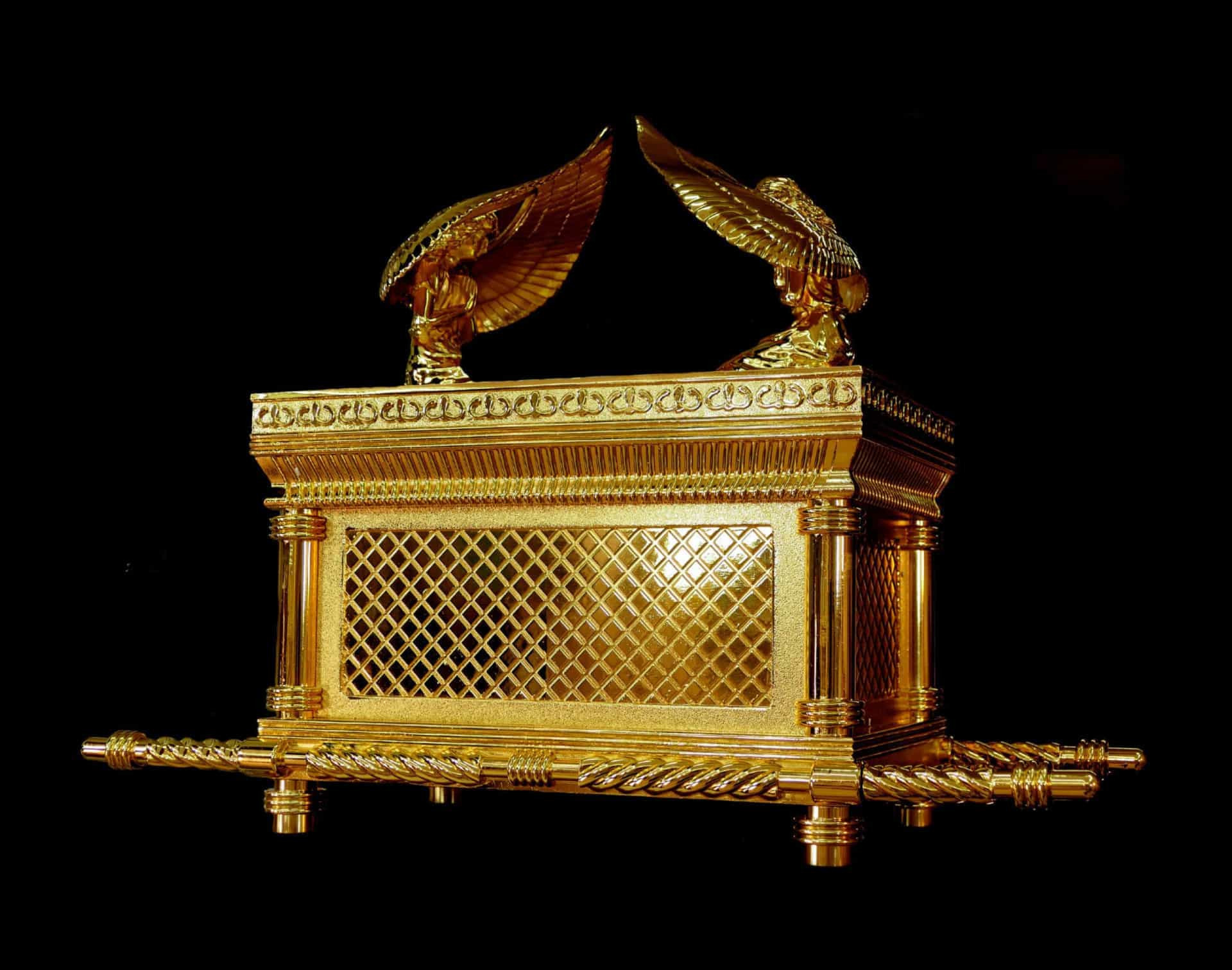
On the trail of the lost Ark of the Covenant
The Ark of the Covenant remains one of history's enduring mysteries. It's certainly one of archaeology 's most perplexing puzzles. Did this gold-plated wooden box said to house the stone tablets on which the Ten Commandments were written ever exist? If so, what happened to it? And where might this legendary artifact be hidden?
Click through the following gallery and learn more about the lost Ark by following this historic timeline.
You may also like: Meet the world's most heinous cannibals
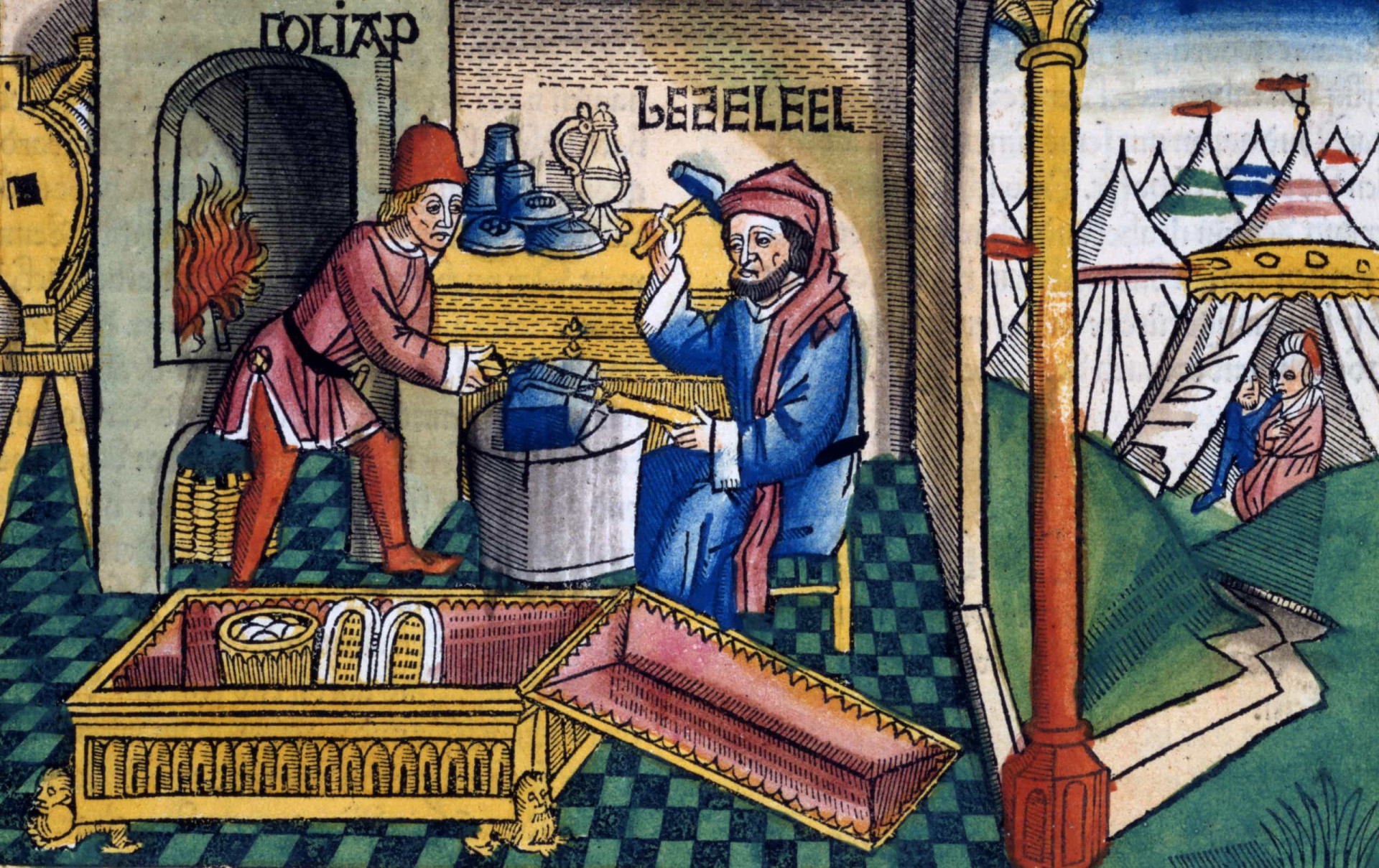
What is the Ark of the Covenant?
The Ark of the Covenant is a gold-covered wooden chest with lid cover. It's described in the Book of Exodus as containing the two stone tablets of the Ten Commandments. It was made by Bezalel, chief artisan of the Tabernacle, assisted by deputy architect Oholiab.
Follow us and access great exclusive content every day

Moses and the Ten Commandments
The Ten Commandments are a set of biblical principles relating to ethics and worship, and fundamental to Judaism and Christianity. Also known as the Tablets of Stone, they were stored in the Ark of the Covenant, which Moses took with him when he ascended biblical Mount Sinai, as written in the Book of Exodus.
You may also like: All the Gold Logie Award winners from the past 30 years
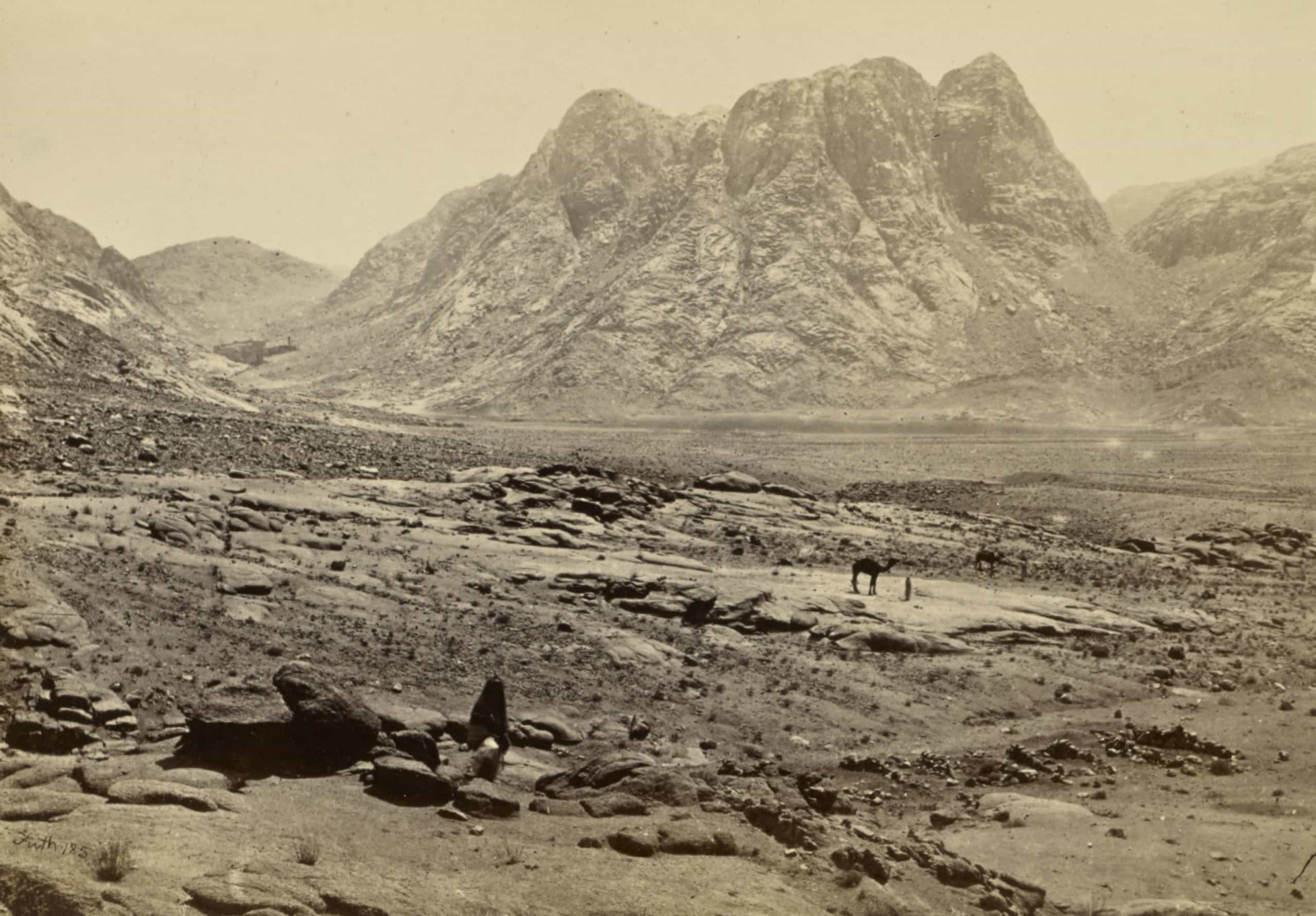
Mount Sinai
In the Bible, Mount Sinai is the mountain at which the Ten Commandments were given to Moses by God. Mount Sinai is one of the most sacred locations in the Jewish, Christian, and Islamic religions.
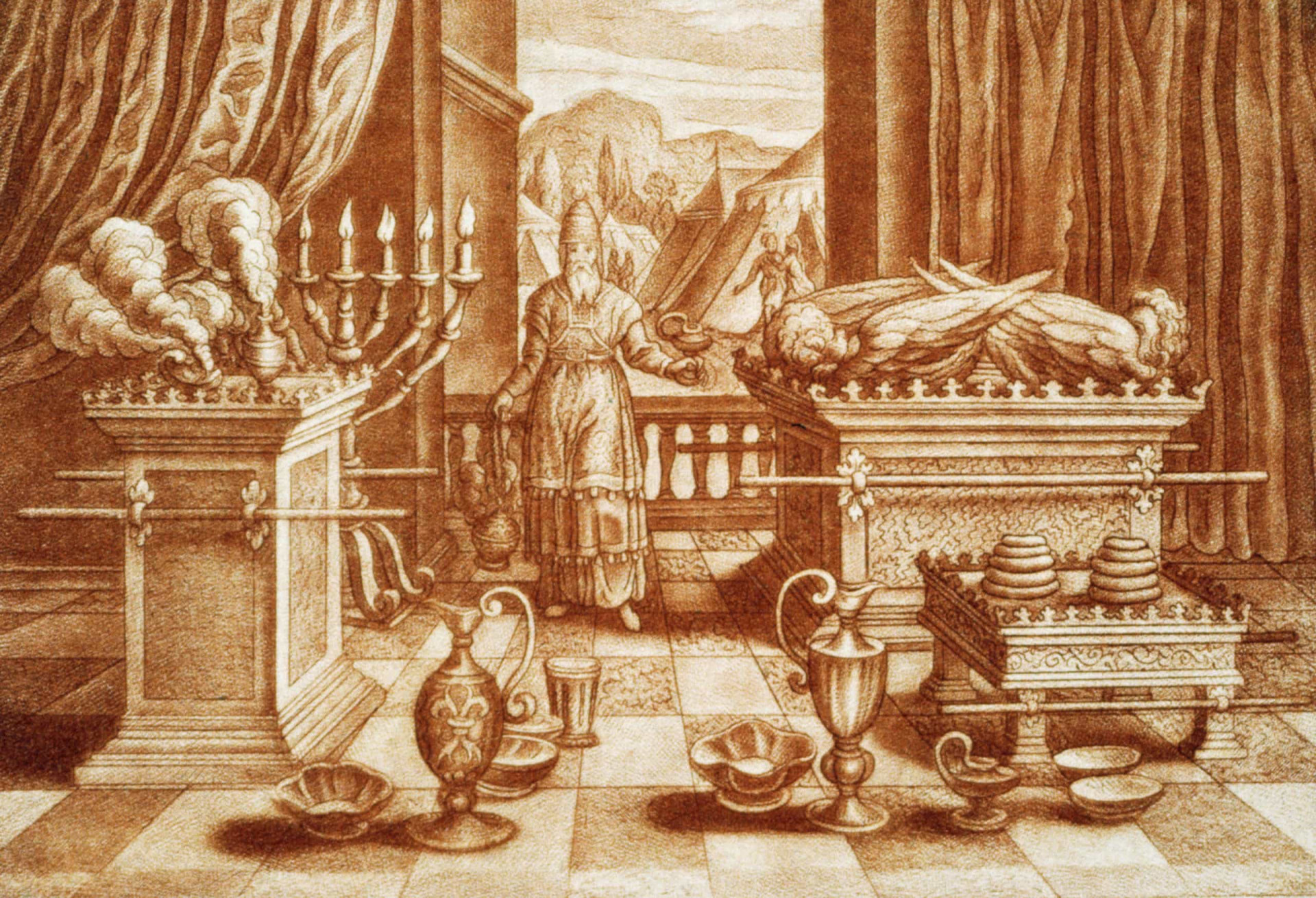
The Tabernacle
What is the aforementioned Tabernacle? When carried, the Ark was always hidden under a large veil made of skins and blue cloth, always carefully concealed, even from the eyes of priests. When at rest, a tabernacle, a kind of tent, was erected and the holy Ark placed under it. The Tabernacle also served as a portable earthly dwelling place used by the Israelites . Pictured is Moses standing over the Ark under the Tabernacle.
You may also like: Are you a Virgo? These celebs share your star sign
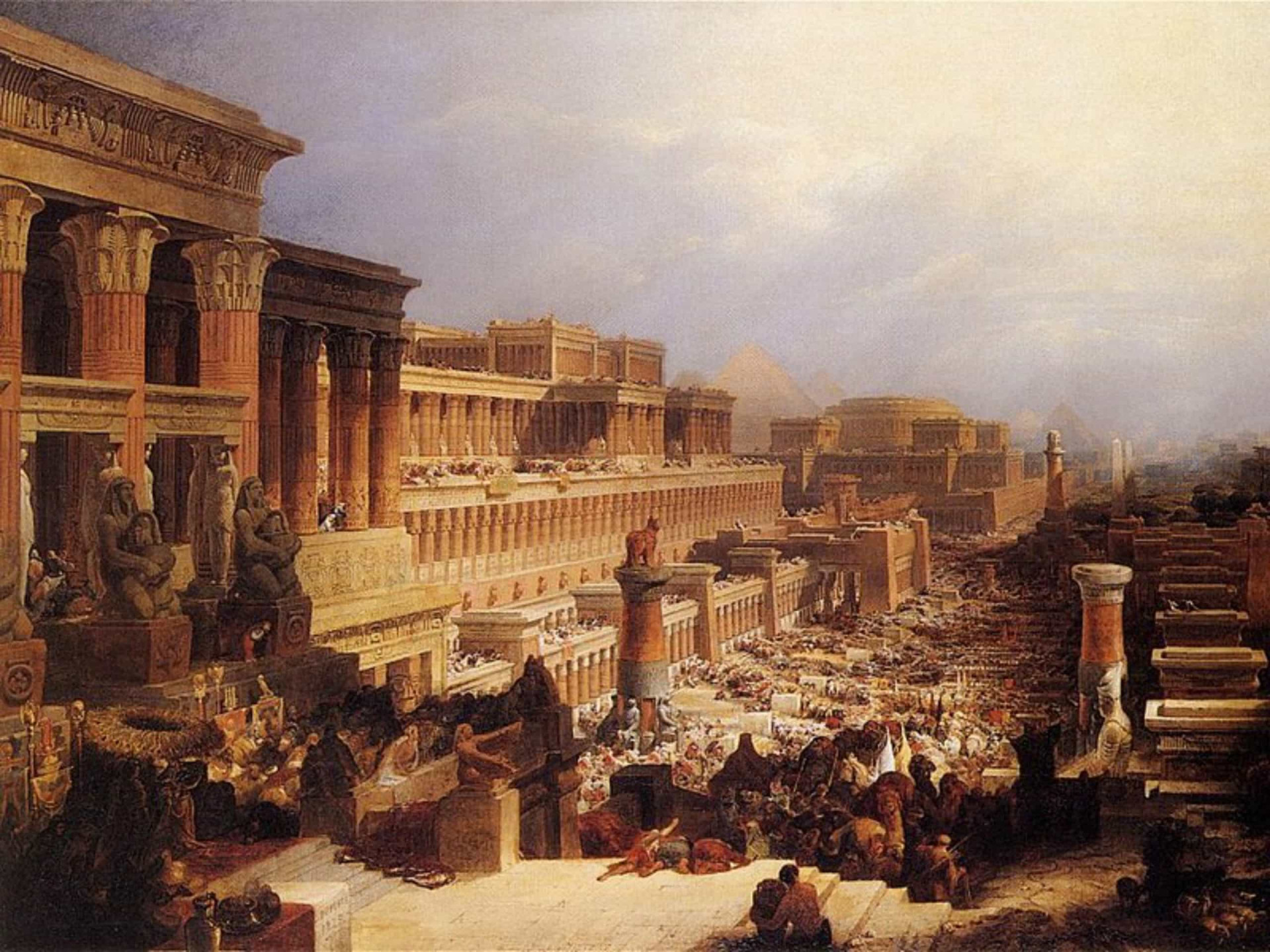
Who were the Israelites?
Any descendant of the Hebrew patriarch Jacob was known as an Israelite. The Israelites were simply members of the 12 tribes of Israel. The Ark was made one year after the Israelites' exodus from Egypt to seek the Promised Land (pictured). From here on in, the Ark is intrinsically related to the biblical Book of Exodus and the biblical Book of Joshua.
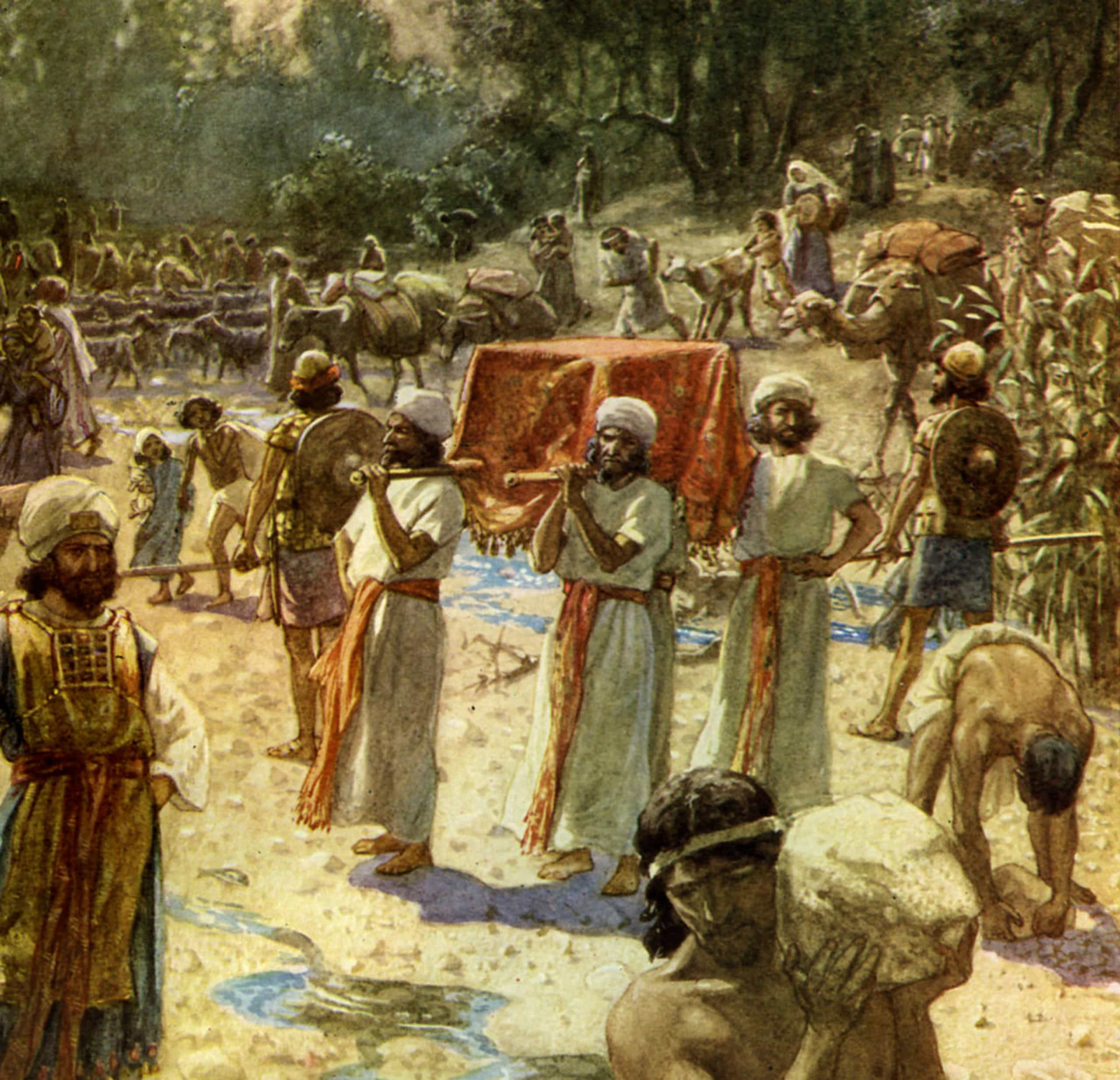
Crossing the Jordan River
Pictured: the Israelites, led by Joshua, crossing the Jordan River into the Promised Land. The Bible says that the river stopped flowing the minute the Ark-Bearers (pictured) set foot in it. In fact, the Ark has been linked to several of the Old Testament's miracles.
You may also like: The most shocking celebrity scandals of our time
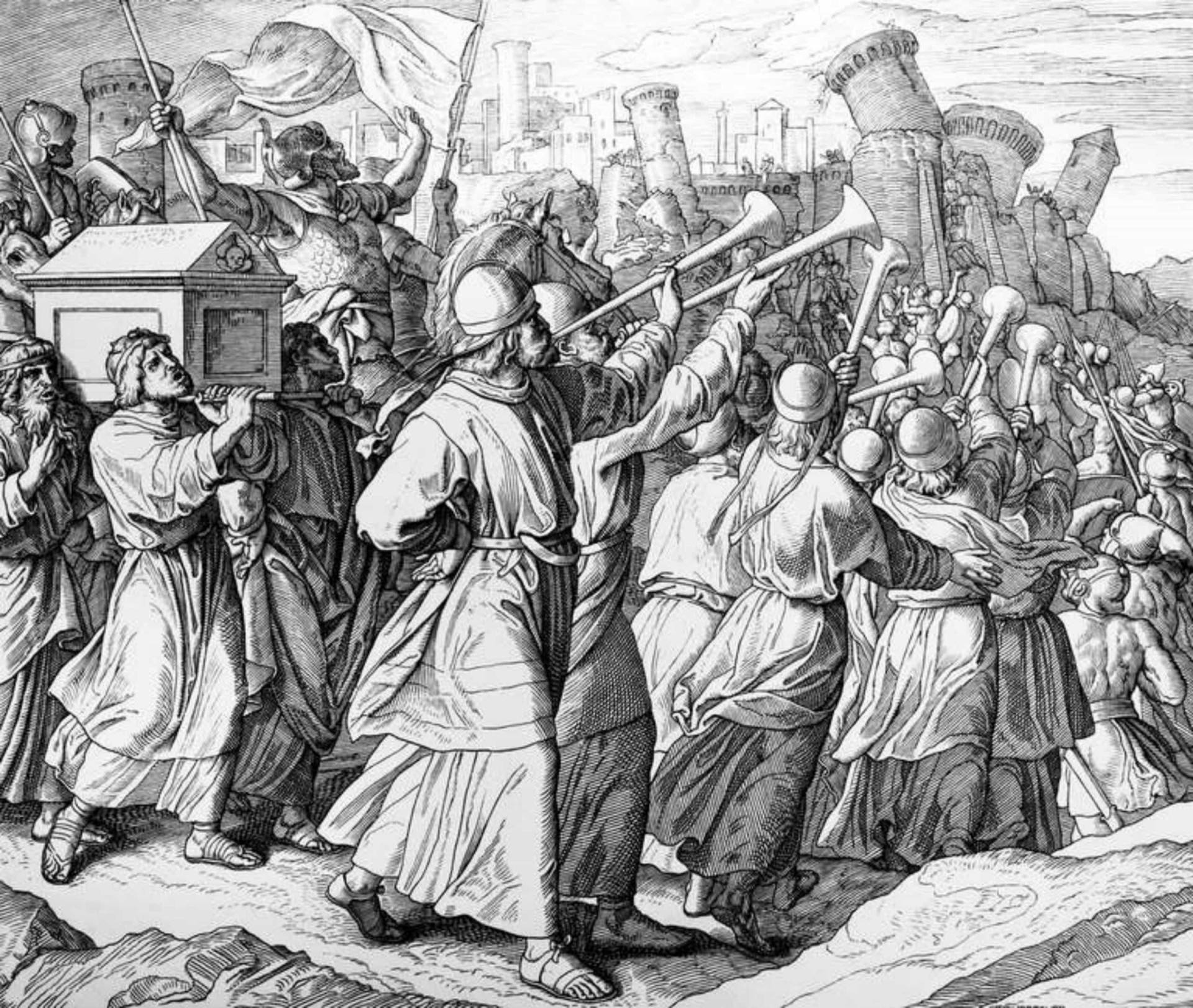
The Battle of Jericho
The Battle of Jericho is an incident from the Book of Joshua where the walls of Jericho fell after the Israelites marched once every day for six days around the city and seven times on the seventh day, then blew their trumpets of rams' horns. Many believe that when the Israelites besieged the ancient town they carried the Ark around the city for a week.
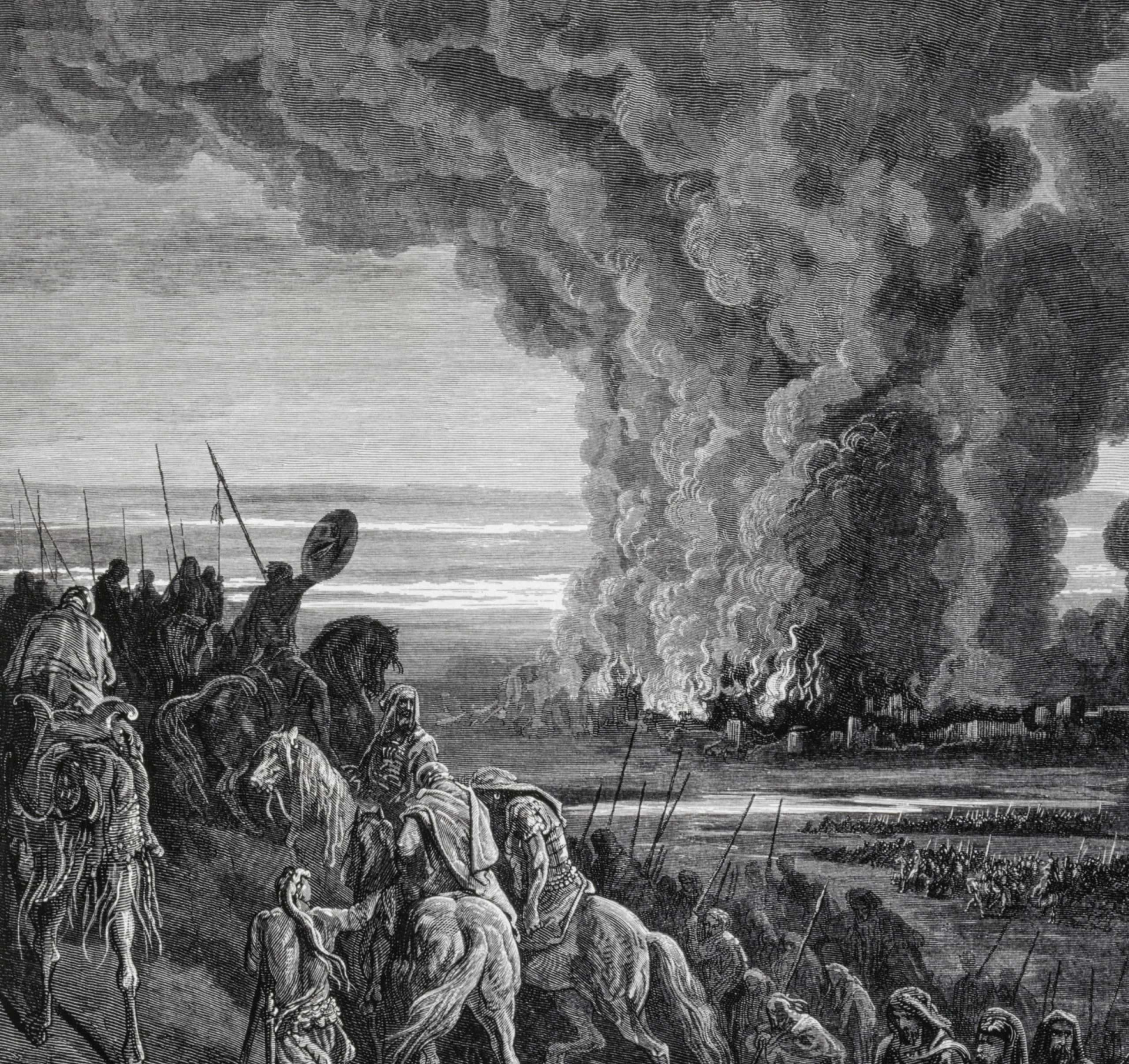
The Ark at Ai
After the Battle of Jericho, the Israelites conquered Ai, a Canaanite city. It's here that the Ark is mentioned again after Joshua laments losing the first battle for Ai–the Israelites only took the city at the second attempt. The ruins of Et-Tell in the West Bank have been identified with the city of Ai.
You may also like: Shameless celebs who love fast food
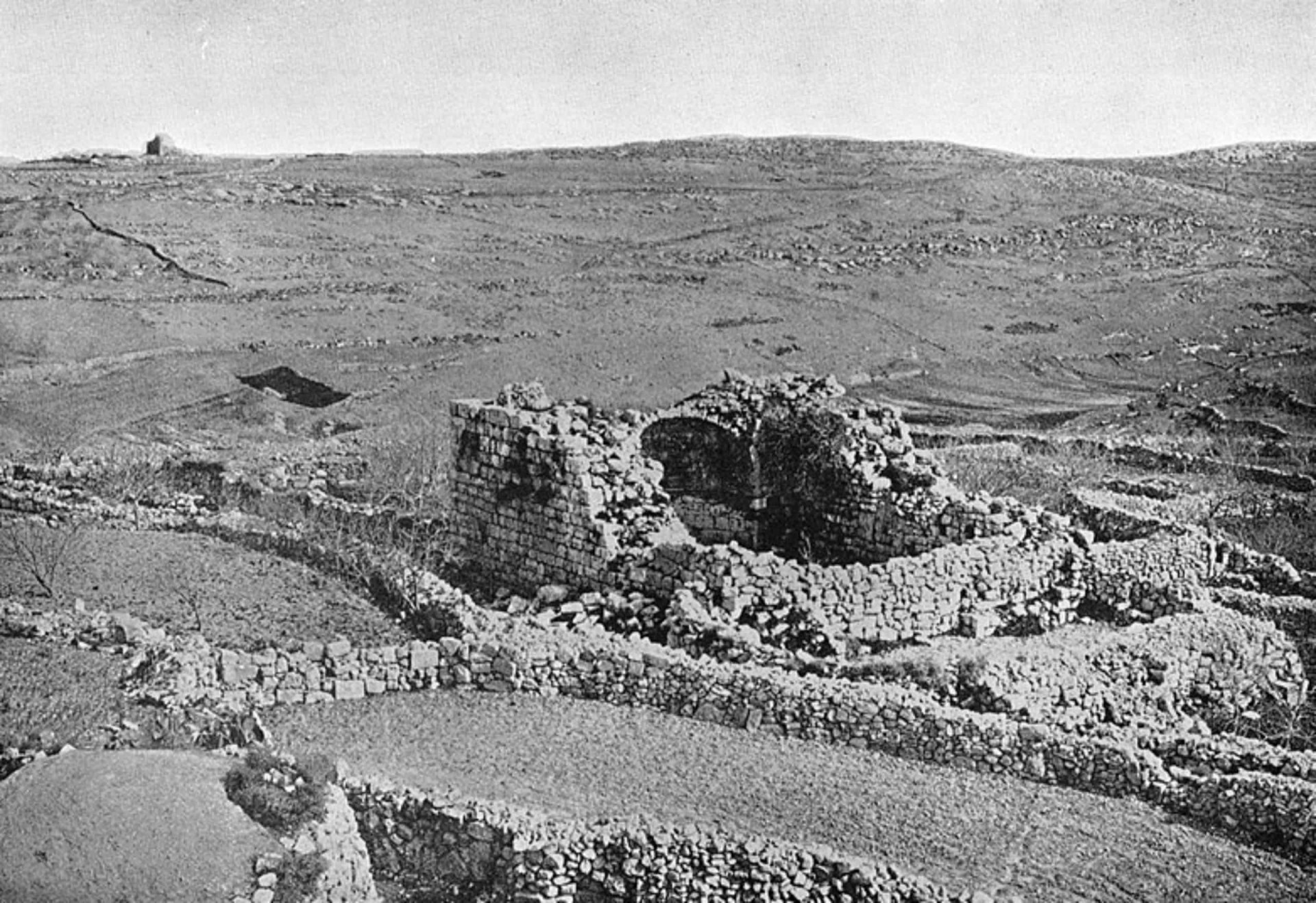
The Ark then turns up in Bethal, the place where Jacob falls asleep and dreams of a ladder stretching between Heaven and Earth and thronged with angels. In Bethal, the Ark is being cared for by the priest Phineas. Pictured are the ruins of Bethal in the 19th century. The Palestinian village of Beitan has been identified as the biblical Bethal.
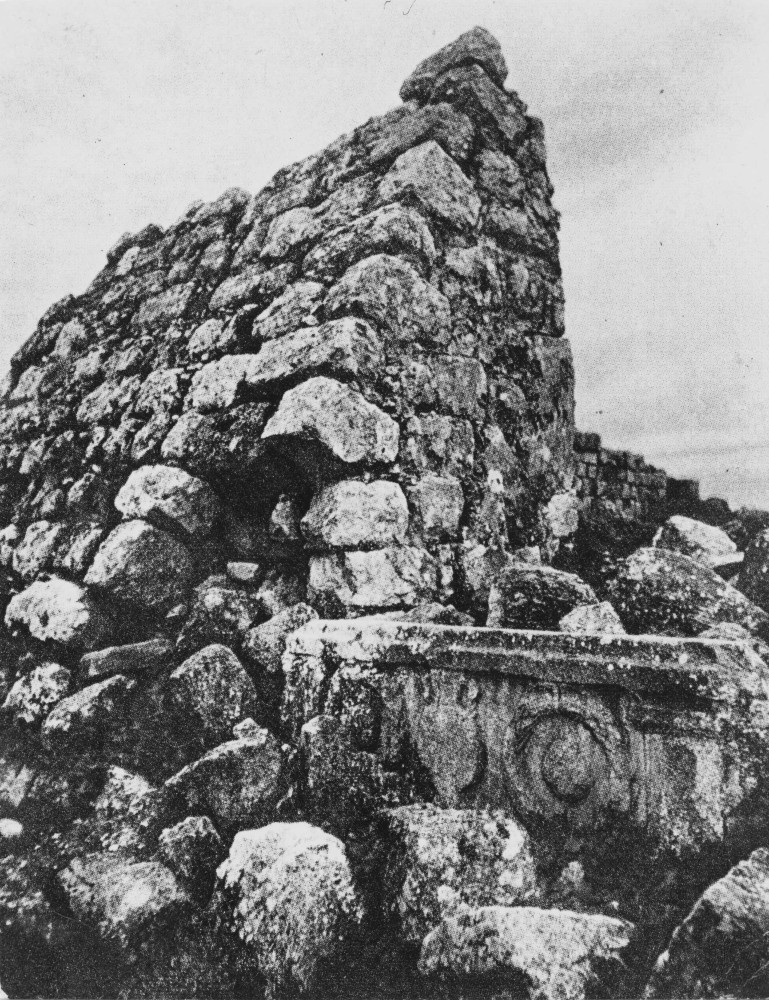
The Ark was later kept at Shiloh, another religious center, this time under the charge of Hophni and Phinehas, two sons of Eli. Pictured are the ruins of biblical Shiloh, circa 1910, located in the West Bank, to the west of the modern Israeli settlement town of Shilo.
You may also like: History's scariest female criminals
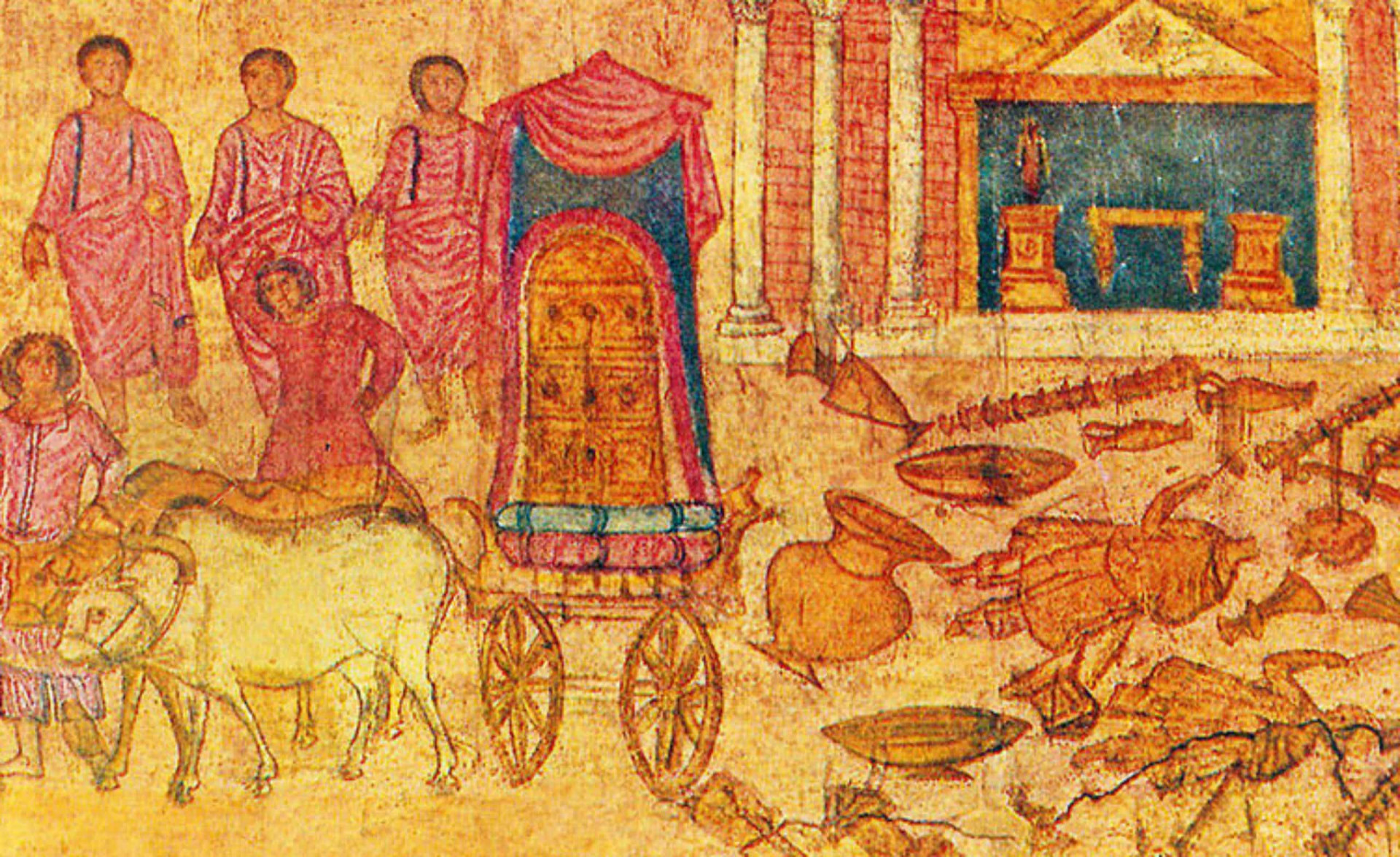
According to the biblical narrative, the Ark was taken onto the battlefield at Eben-Ezer where the Israelites were defeated by the Philistines. The Ark's guardians, Hophni and Phinehas, perished and the precious chest ended up in the possession of the victors. Pictured is a fresco of the Philistine captivity of the Ark, in the Dura-Europos synagogue in Syria. Sadly, the site appears to have been destroyed by Daesh during the present-day Syrian civil war.
![The Ark's terrible power <p>The loss of the Ark is described by the daughter-in-law of Eli as a "glory [that] has departed Israel." The Philistines, meanwhile, parade the Ark throughout their land. But at each place, misfortune visits them. At Ashdod, for example, it was placed in the temple of the deity Dagon. The next day, a statue of Dagon was found toppled and broken (pictured).</p><p>You may also like:<a href="https://www.starsinsider.com/n/382098?utm_source=msn.com&utm_medium=display&utm_campaign=referral_description&utm_content=452739v7en-ph"> Bad blood: Meet Taylor Swift's many enemies</a></p>](https://img-s-msn-com.akamaized.net/tenant/amp/entityid/BB1iE96F.img)
The Ark's terrible power
The loss of the Ark is described by the daughter-in-law of Eli as a "glory [that] has departed Israel." The Philistines, meanwhile, parade the Ark throughout their land. But at each place, misfortune visits them. At Ashdod, for example, it was placed in the temple of the deity Dagon. The next day, a statue of Dagon was found toppled and broken (pictured).
You may also like: Bad blood: Meet Taylor Swift's many enemies
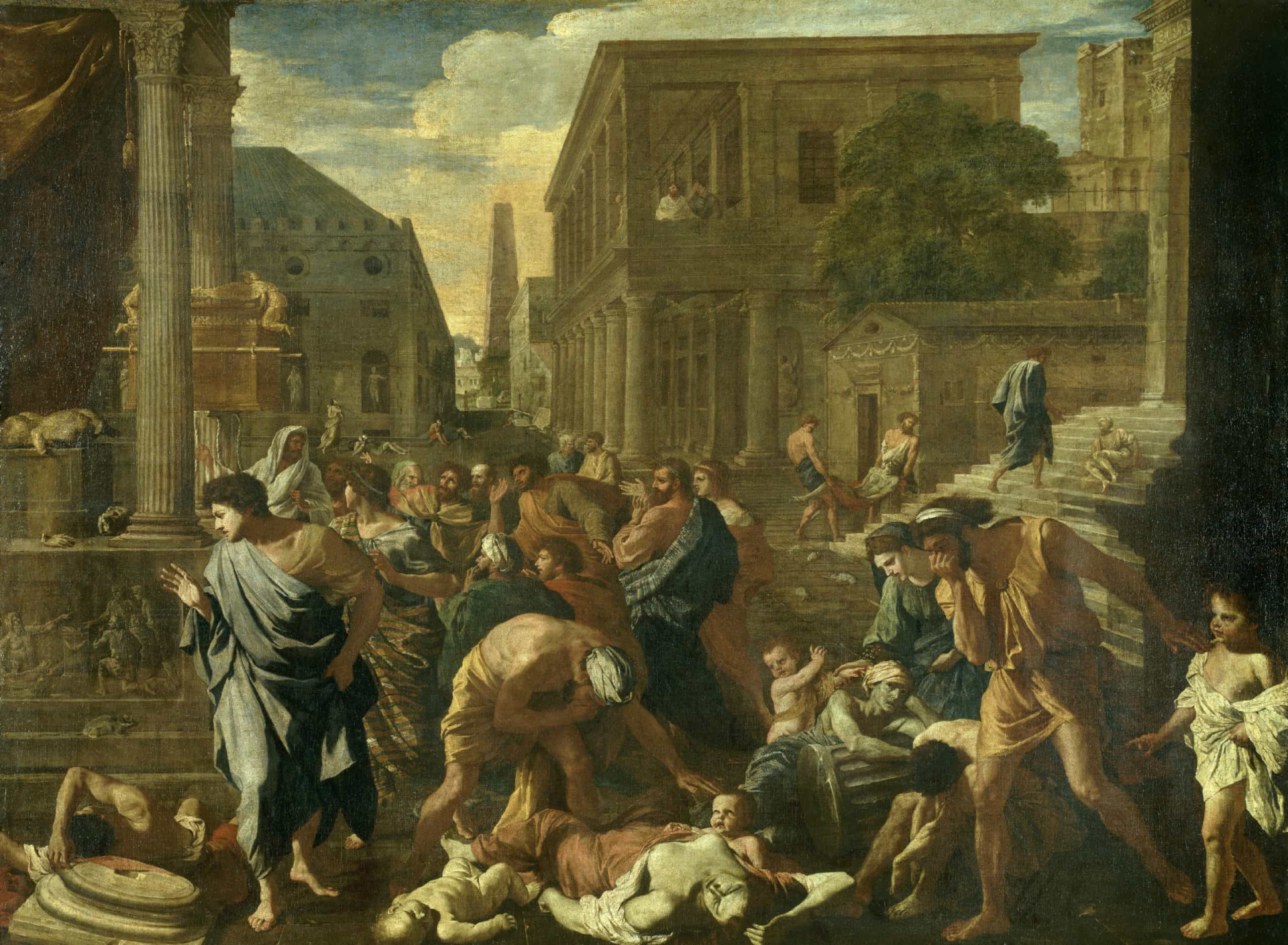
Plague of Ashdod
But the worst was yet to come. The people of Ashdod were struck down by God and afflicted by plague (pictured) for the sacrilege of allowing the Ark to be placed in the temple. Elsewhere, a scourge of boils was visited upon the people of Gath and of Ekron. The Ark is quickly removed from the temple.
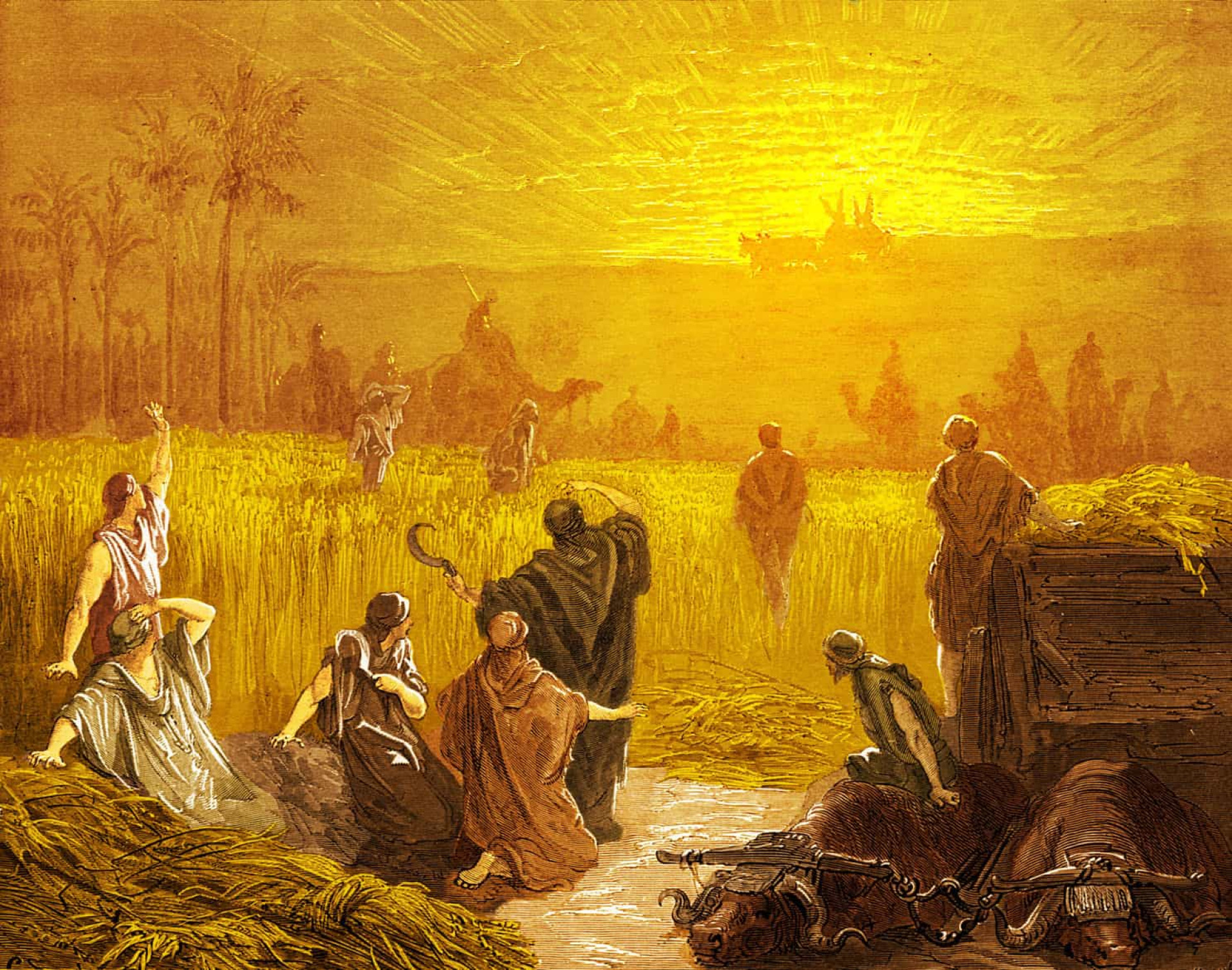
The Ark is returned
Daunted by the prospect of further calamity and ill luck, the Philistines, on advice of their diviners, decide to return the Ark to the Israelites. Pictured is the Ark's arrival at Beth Shemesh.
You may also like: Murder in paradise: Inside Thailand's "death island"
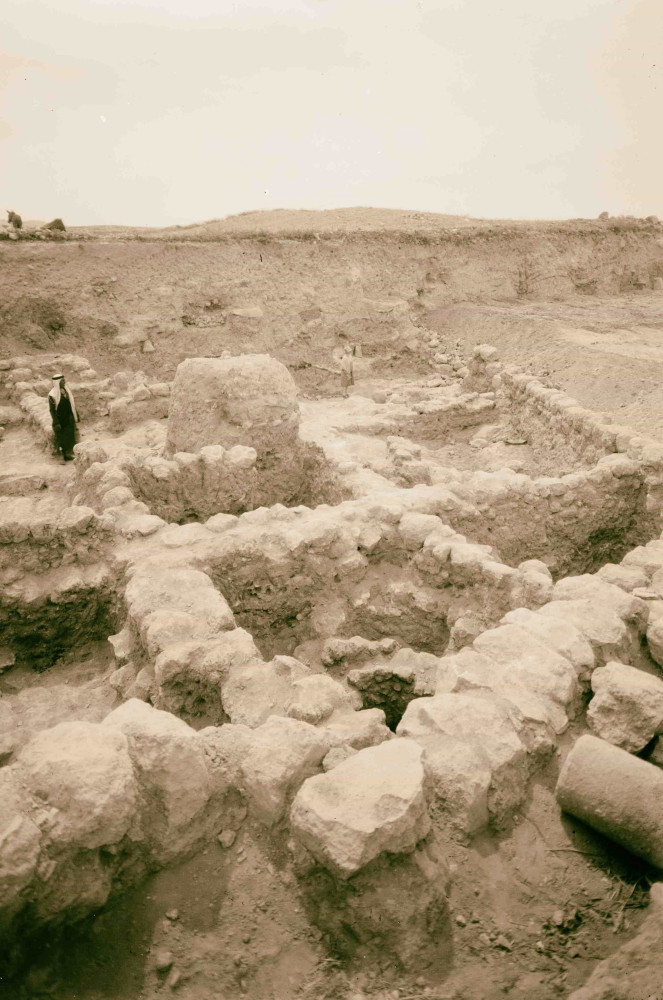
Beth Shemesh
The Ark is set up in one of the fields where, out of curiosity, the town's men open up the golden chest and gaze inside. This unholy act results in God's wrath, with Him punishing most of the hapless onlookers with death. Pictured are the foundations of Beth Shemesh in 1898.
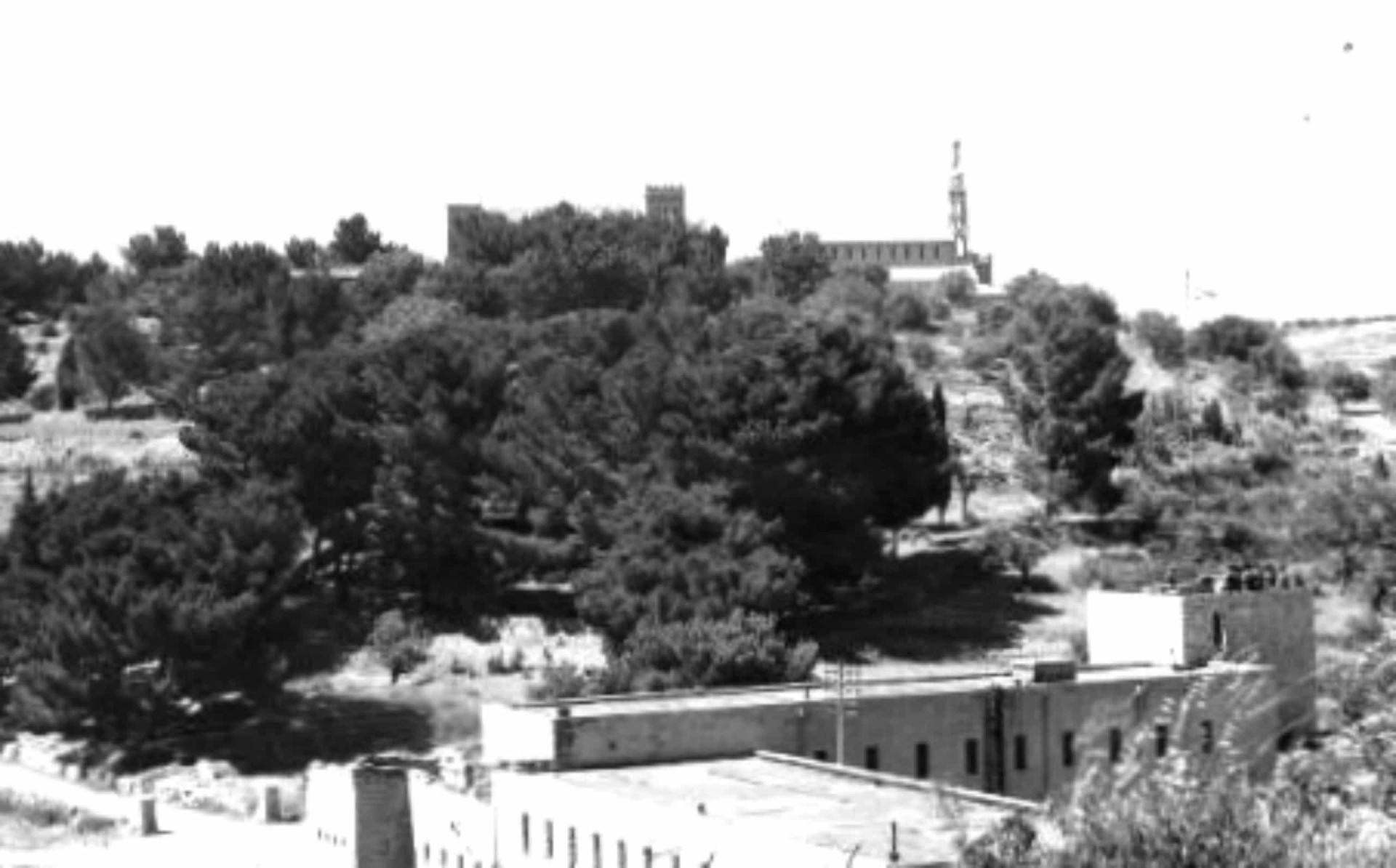
Kiriath-Jearim
The Bethshemites rid themselves of the Ark by dispatching it to Kiriath-Jearim (pictured in 1948), where a man called Abinadab looks after it for the next 20 years.
You may also like: The world's most fascinating fortresses

The coveted chest is eventually taken from Kiriath-Jearim by King David and, amid great rejoicing, the Ark is brought to Jerusalem .
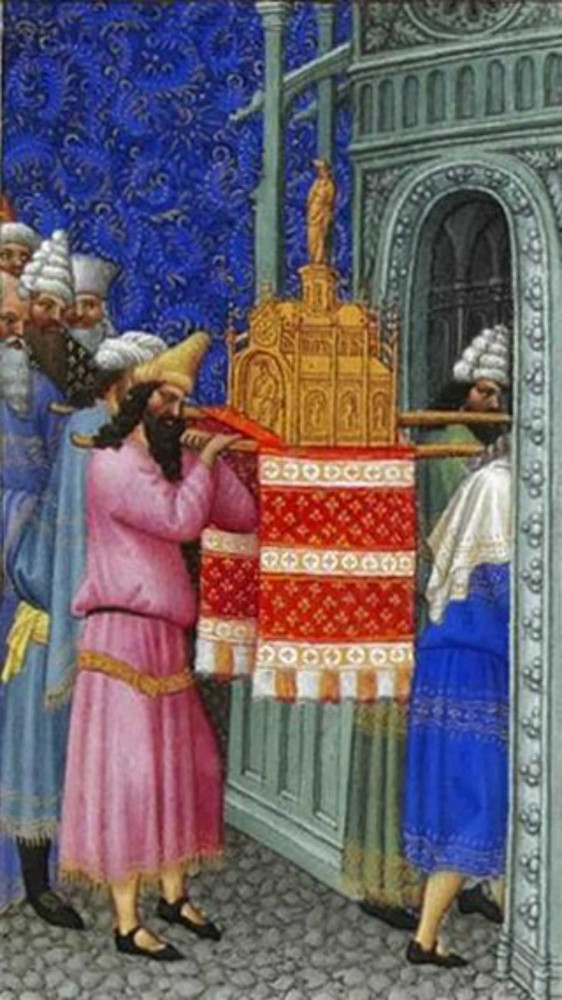
King Solomon
Much later, after David's departure from Jerusalem, King Solomon worshipped before the Ark after his dream in which God promises him wisdom. Thereafter, the king ordered a temple to be built, a building suitable in size and grandeur to accommodate the mysterious and powerful chest. A special inner room, named Kodesh Hakodashim ("Holy of Holies"), was prepared to receive and house the now legendary artifact (pictured).
You may also like: History's most notorious lies, hoaxes, and deceptions
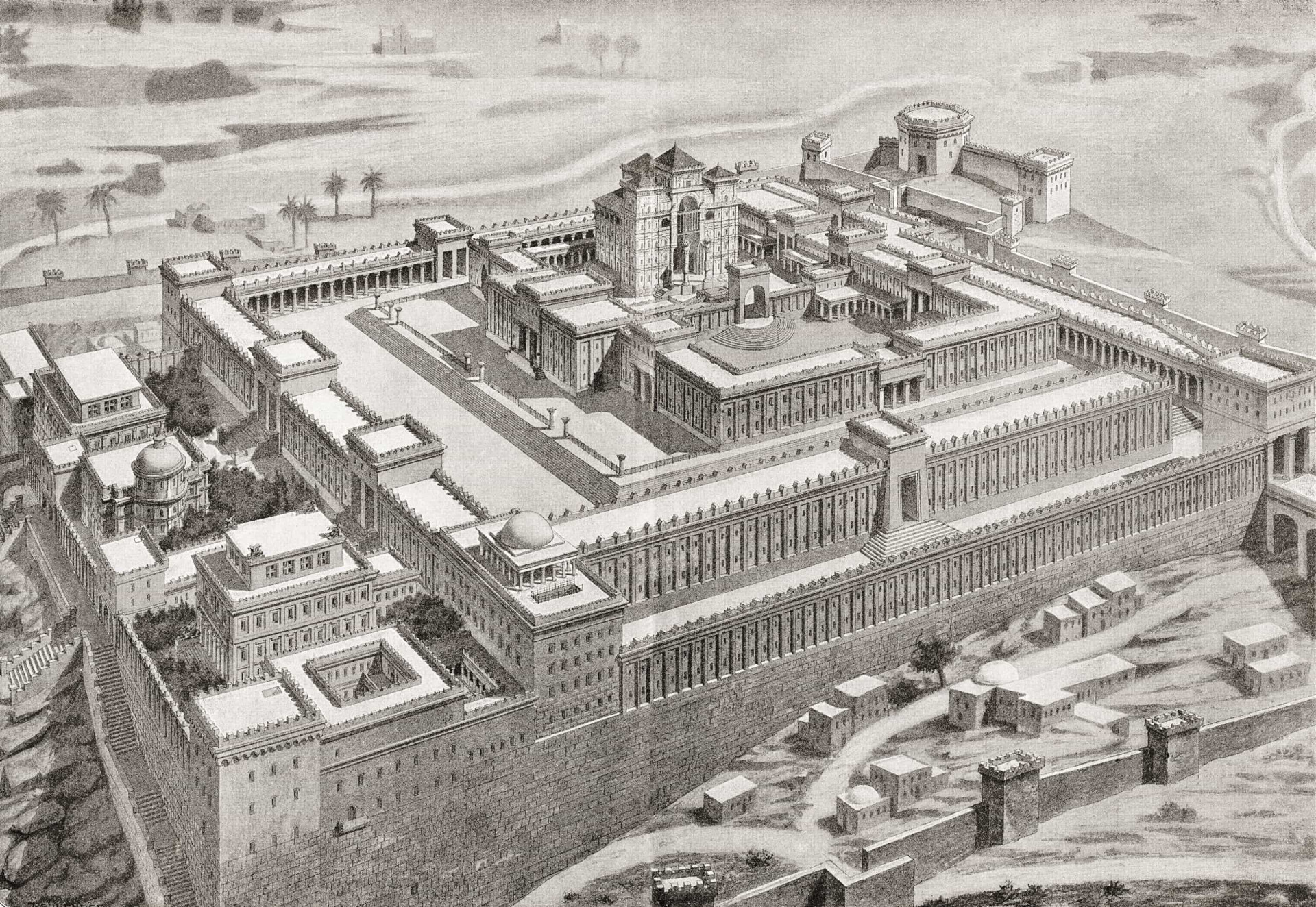
Siege of Jerusalem
In 597 and 587 BCE, the Babylonian Empire conquered the Israelites. Jerusalem was sacked and the Ark, supposedly stored in the temple, vanished. Pictured is an artist's impression of Solomon's Temple before it was destroyed by Nebuchadnezzar II, King of Babylon, after the Siege of Jerusalem of 587 BCE.
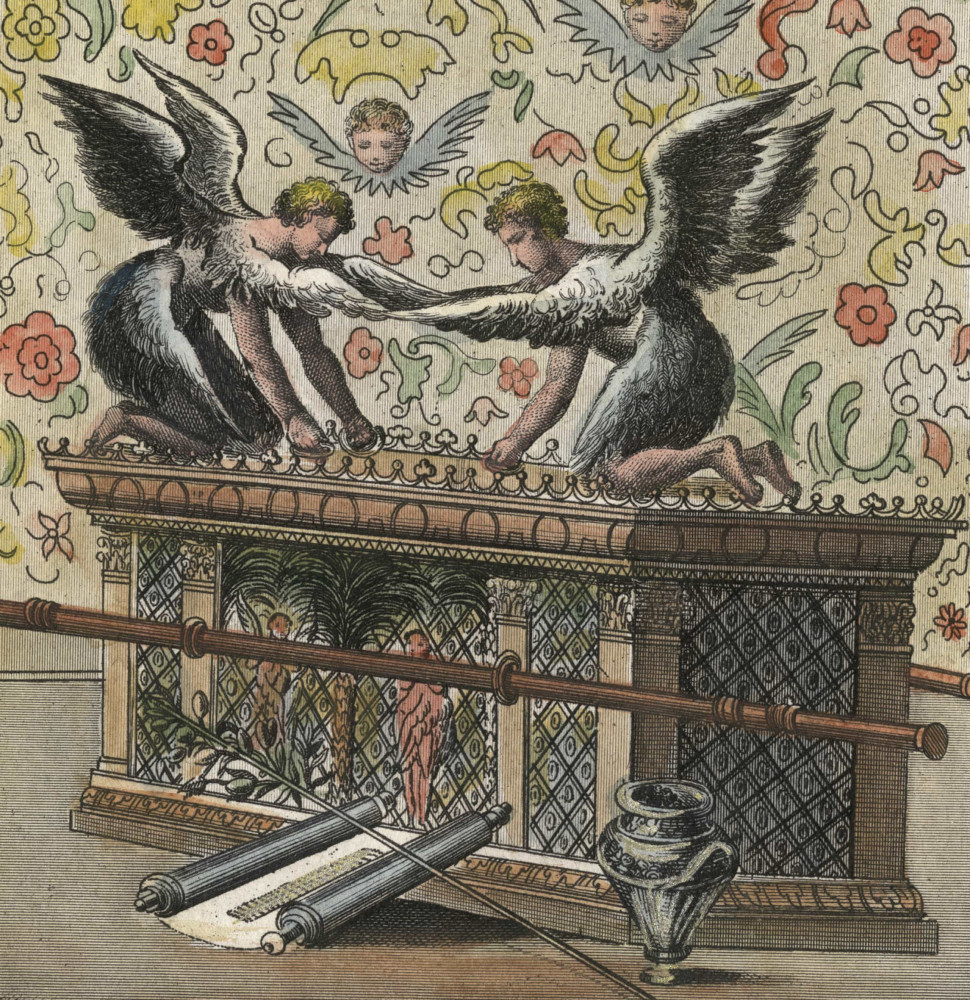
What happened to the Ark?
Was the Ark destroyed, captured, or hidden? Nobody knows. But since that fateful day in Jerusalem in 587 BCE, nothing has been seen of the gold-covered wooden chest. So where could it have ended up?
You may also like: Discovering the enigmatic stories of the English Channel
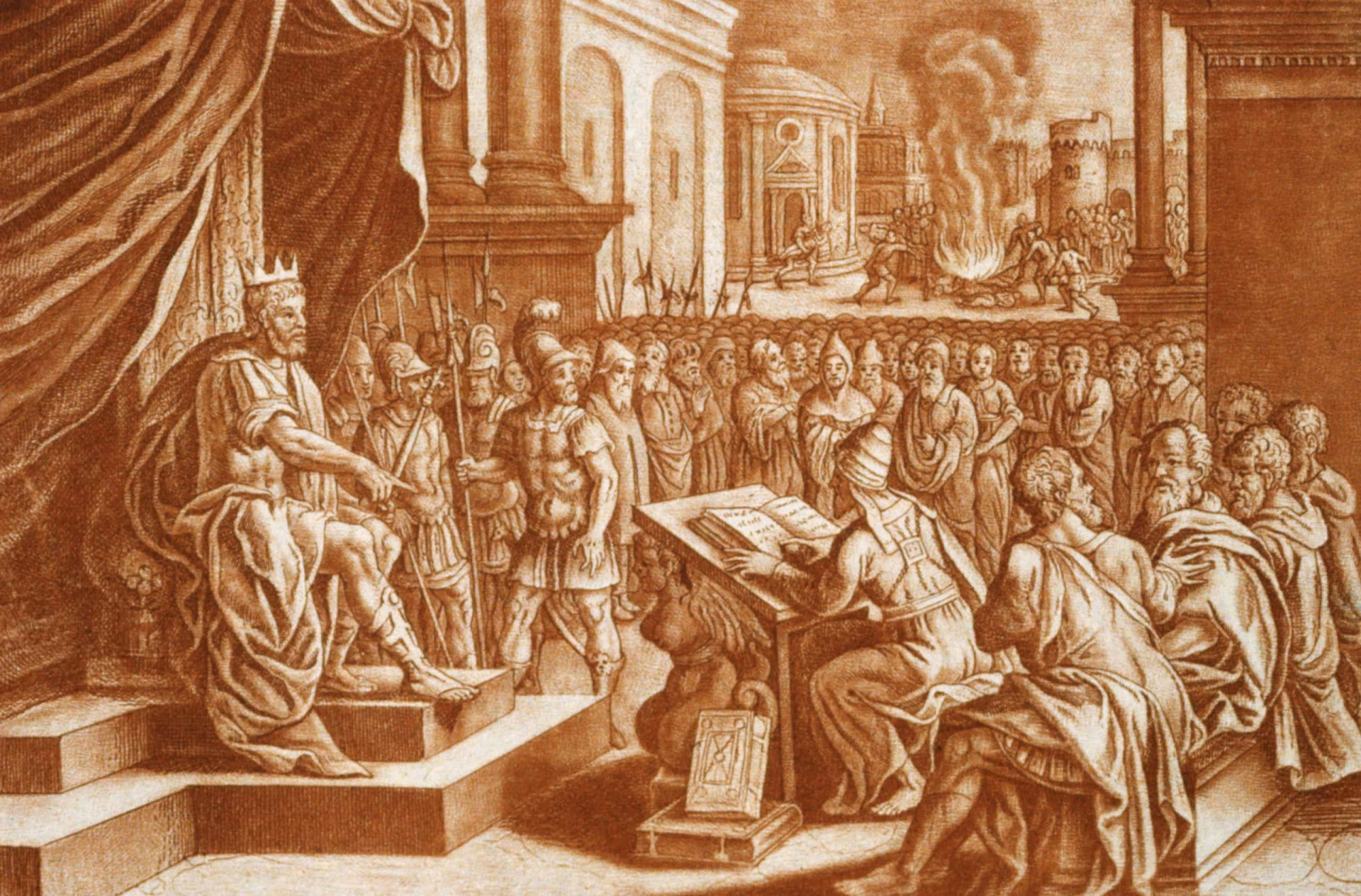
A late 2nd-century rabbinic work known as the Tosefta suggests that Josiah, the king of Judah, stored away the Ark which contained the tablets, a jar of manna (an edible substance that God provided for the Israelites during their travels in the desert), a jar containing holy anointing oil, and Aaron's rod. But this claim has never been substantiated. Pictured is a print depicting Josiah with the elders of Judah and Jerusalem.
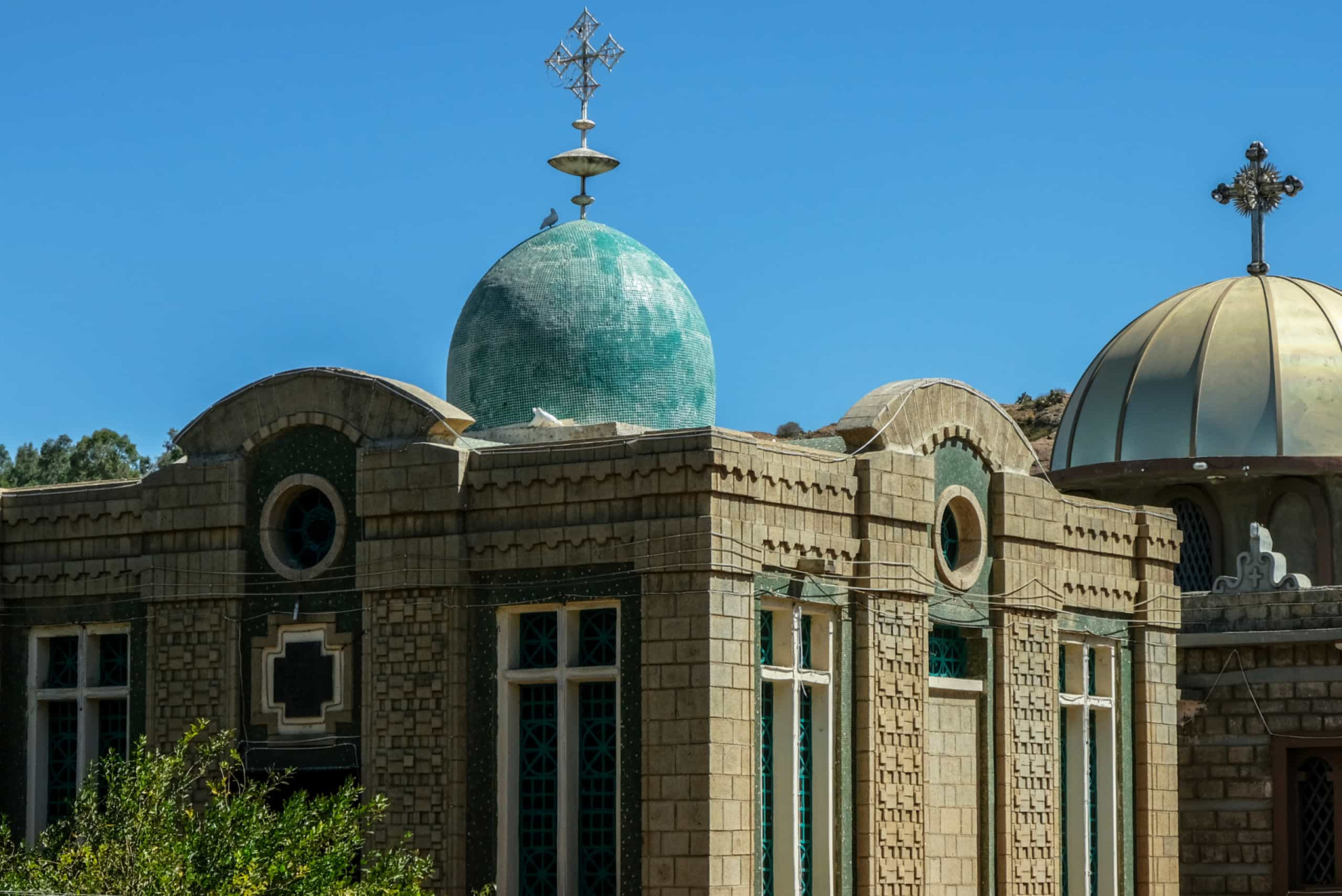
The Chapel of the Tablet
One famous claim suggests that the Ark was removed from Jerusalem and taken to Ethiopia by Menelik I after he visited his father King Solomon. The chest was supposedly placed in the Church of Our Lady Mary of Zion, in the town of Axum. It was later moved to an adjoining chapel (pictured). Only a guardian monk may view the chest, and is confined to the Chapel of the Ark of the Covenant for the rest of his life, praying before it and offering incense. No one else can enter the building, and no one else has seen it. Whether or not the Ark truly resides beneath the chapel, the site still draws thousands of pilgrims each year.
You may also like: Vintage photos of celebs gone fishin'
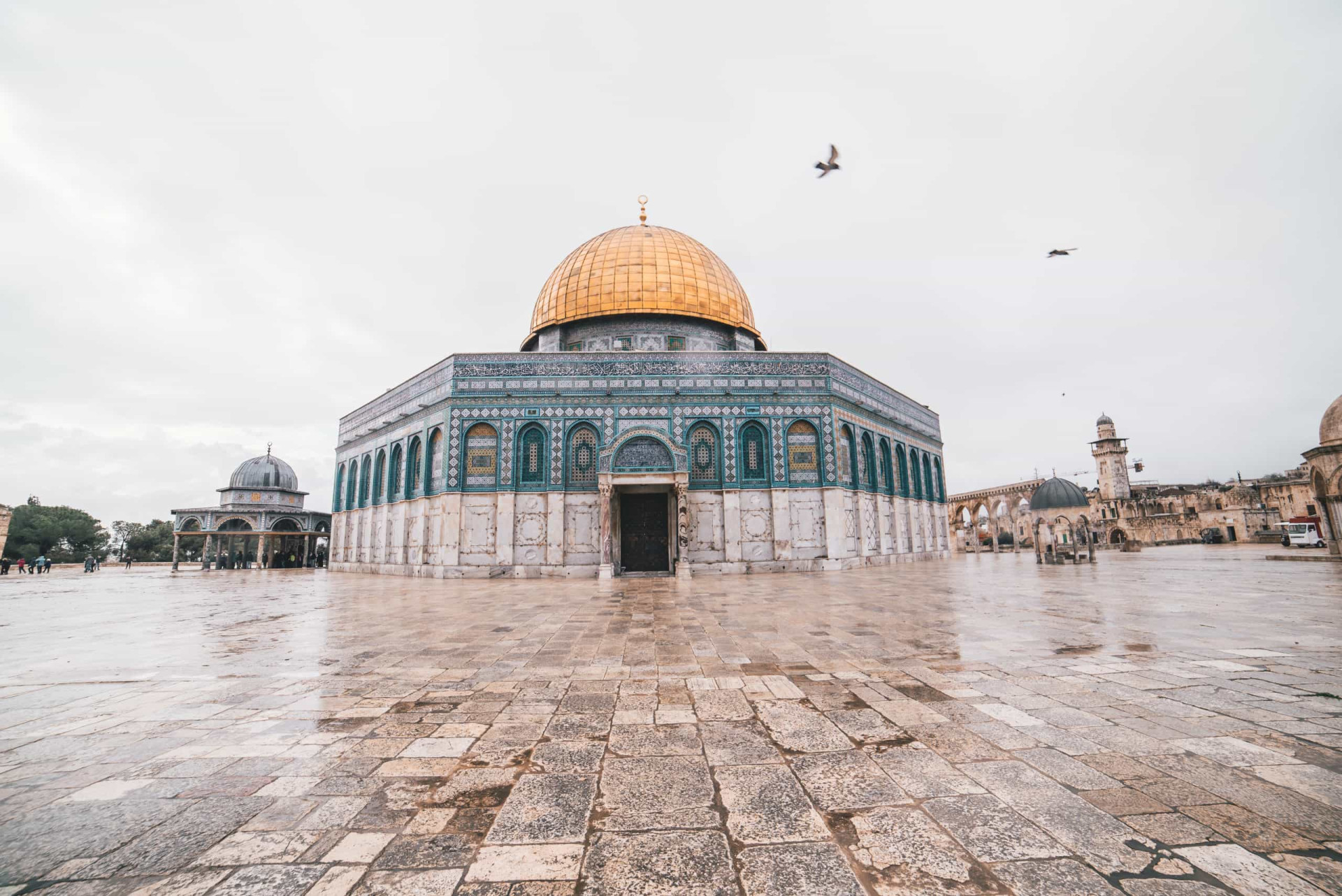
Dome of the Rock
Another theory as to the Ark's whereabouts is that it was hidden below the First Temple in Jerusalem before the Babylonians destroyed it in 587 BCE. But this is a claim that simply can't be substantiated: the site is home to the Dome of the Rock, sacred in Islam. Excavating beneath it is totally out of the question.
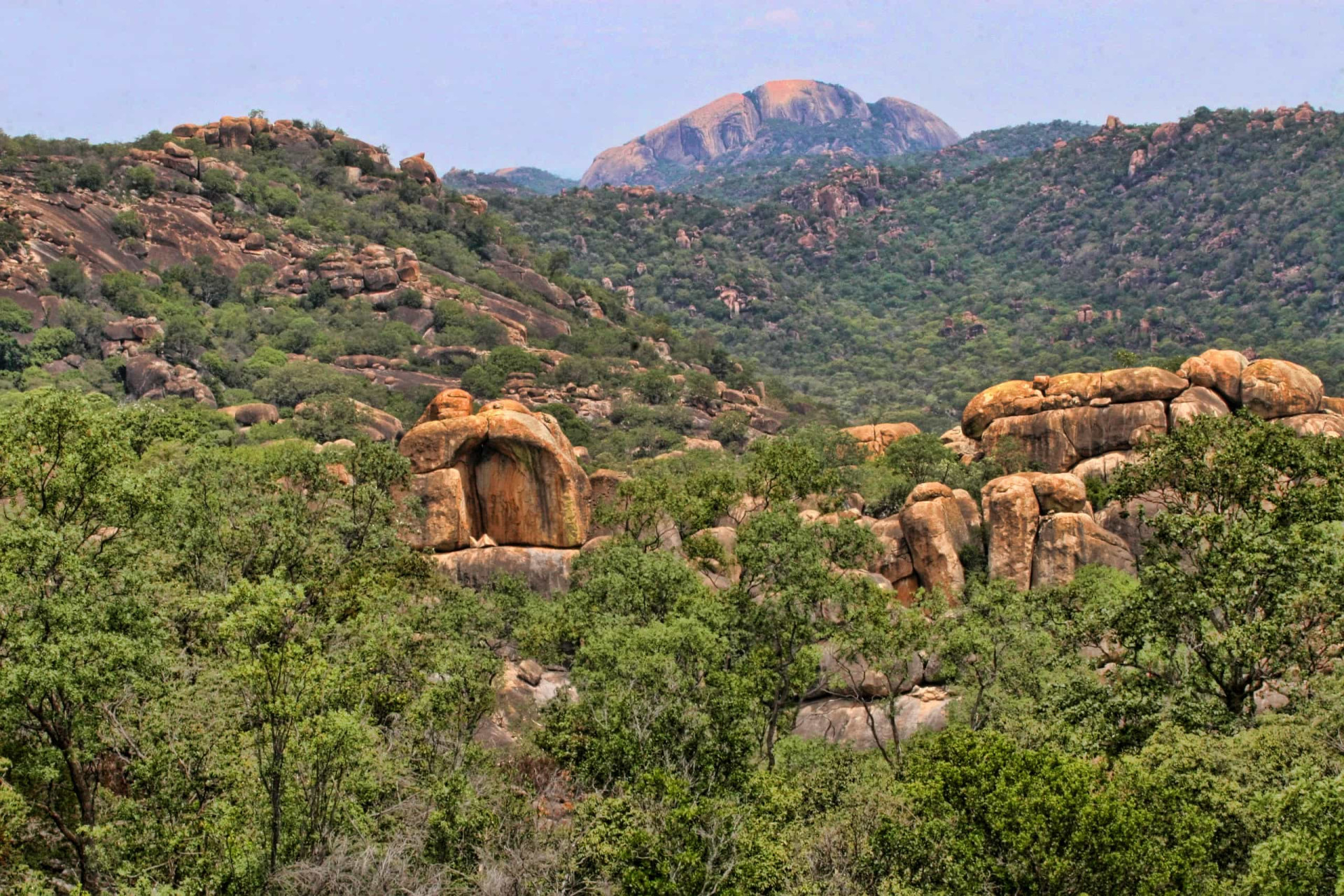
Hidden in a cave?
Elsewhere, the Lemba people, a Bantu ethnic group native to Zimbabwe and South Africa, insist that their ancestors carried the Ark south, calling it the ngoma lungundu or "voice of God," and eventually hiding it in a deep cave in the Dumghe mountains, their spiritual home.
You may also like: Actors who played multiple characters in the same movie
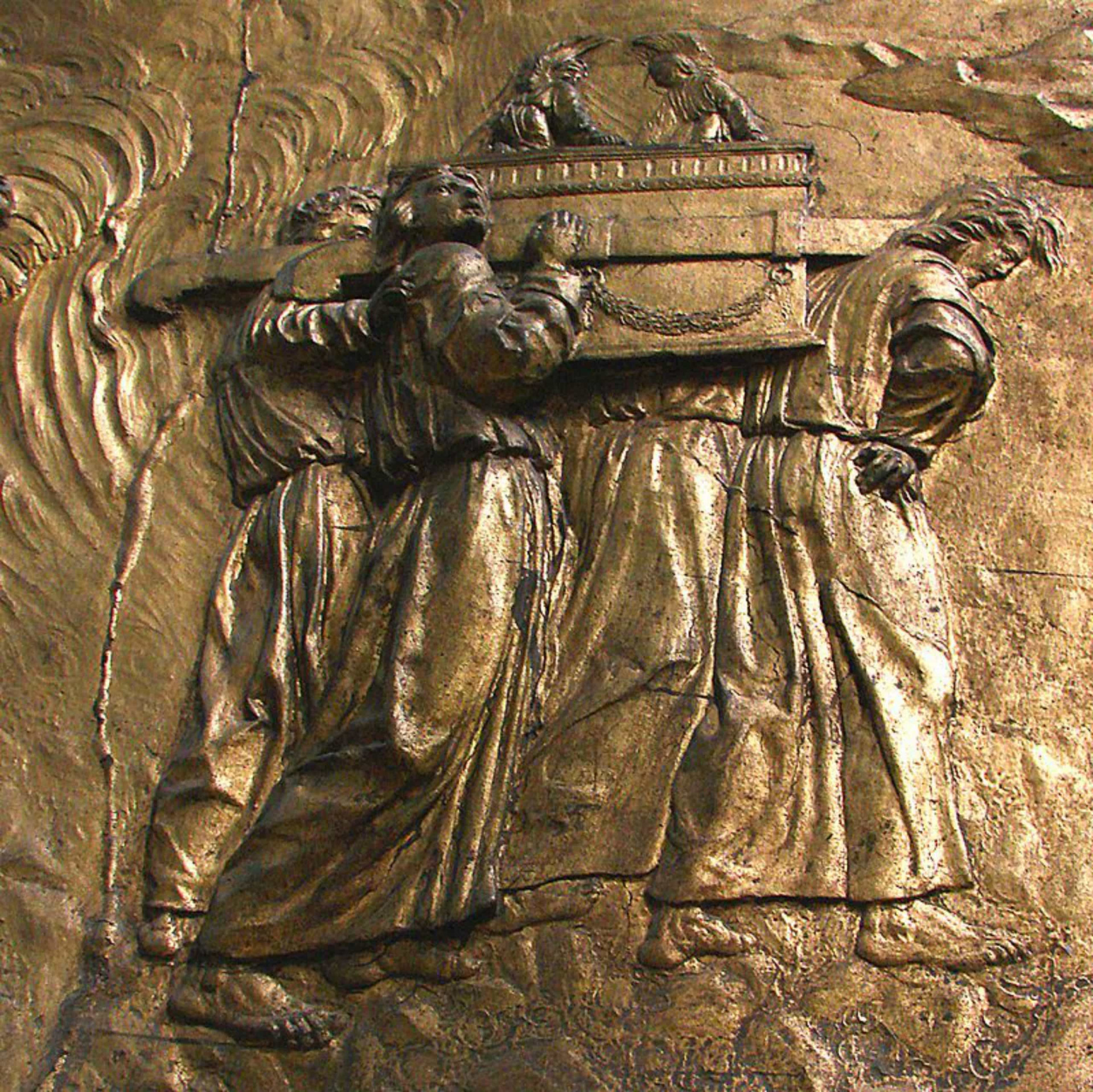
Is the Ark in France?
French journalist Louis Charpentier, author of 'The Mysteries of Chartres Cathedral,' has made an assertion that the Ark was taken to Chartres Cathedral by the Knights Templar. Pictured is a gilded bas-relief of monks carrying the allusive chest at Auch Cathedral in France.
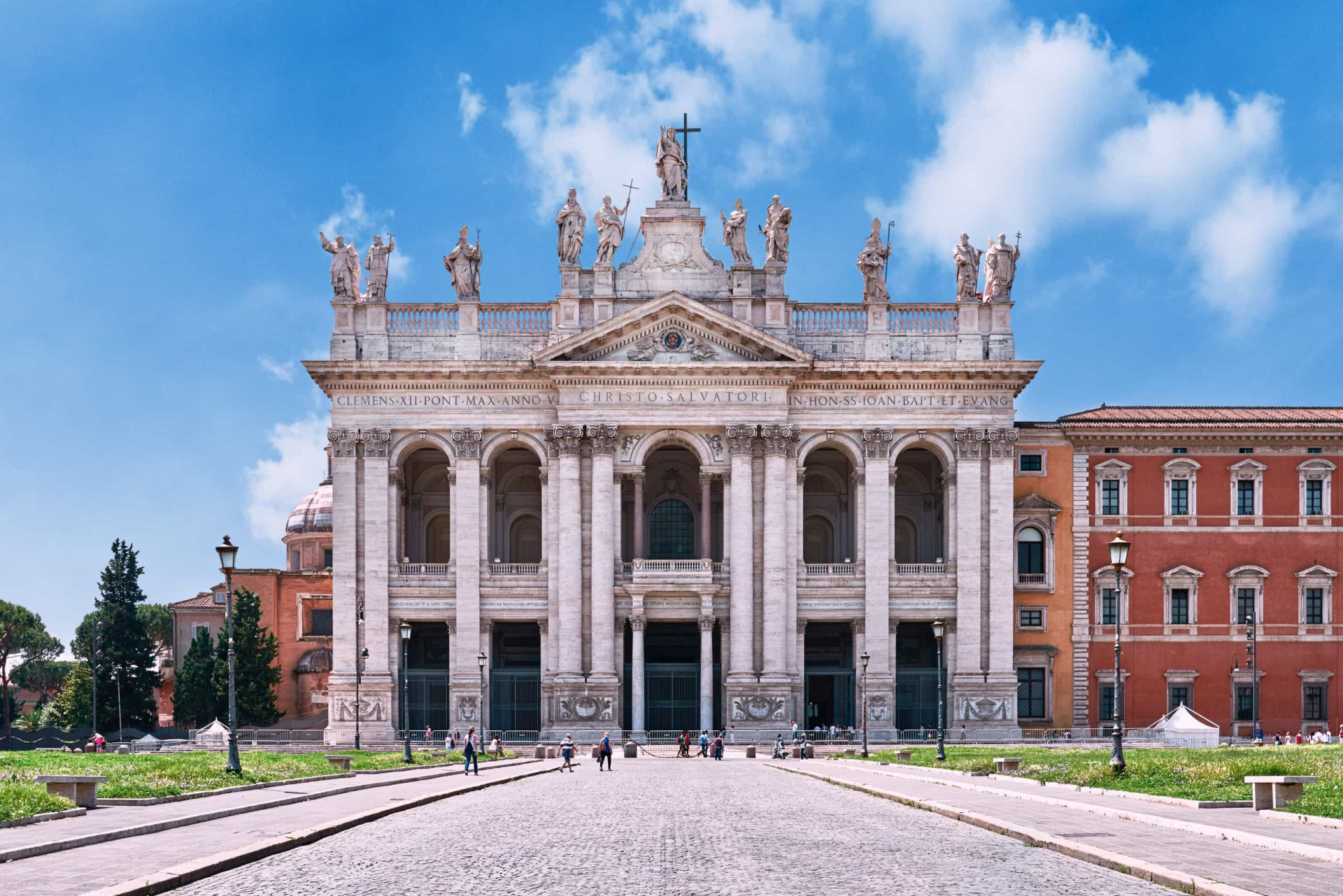
Did the Ark end up in Rome?
Still in Europe, the Ark of the Covenant was said to have been kept in the Basilica of St. John Lateran, surviving the pillages of Rome by the Visigoths and Vandals in the 5th century BCE, but lost forever when the original basilica was ravaged by fire, first in 1307 and again in 1361. Pictured is the building today.
You may also like: Famous individuals who were exhumed from their graves
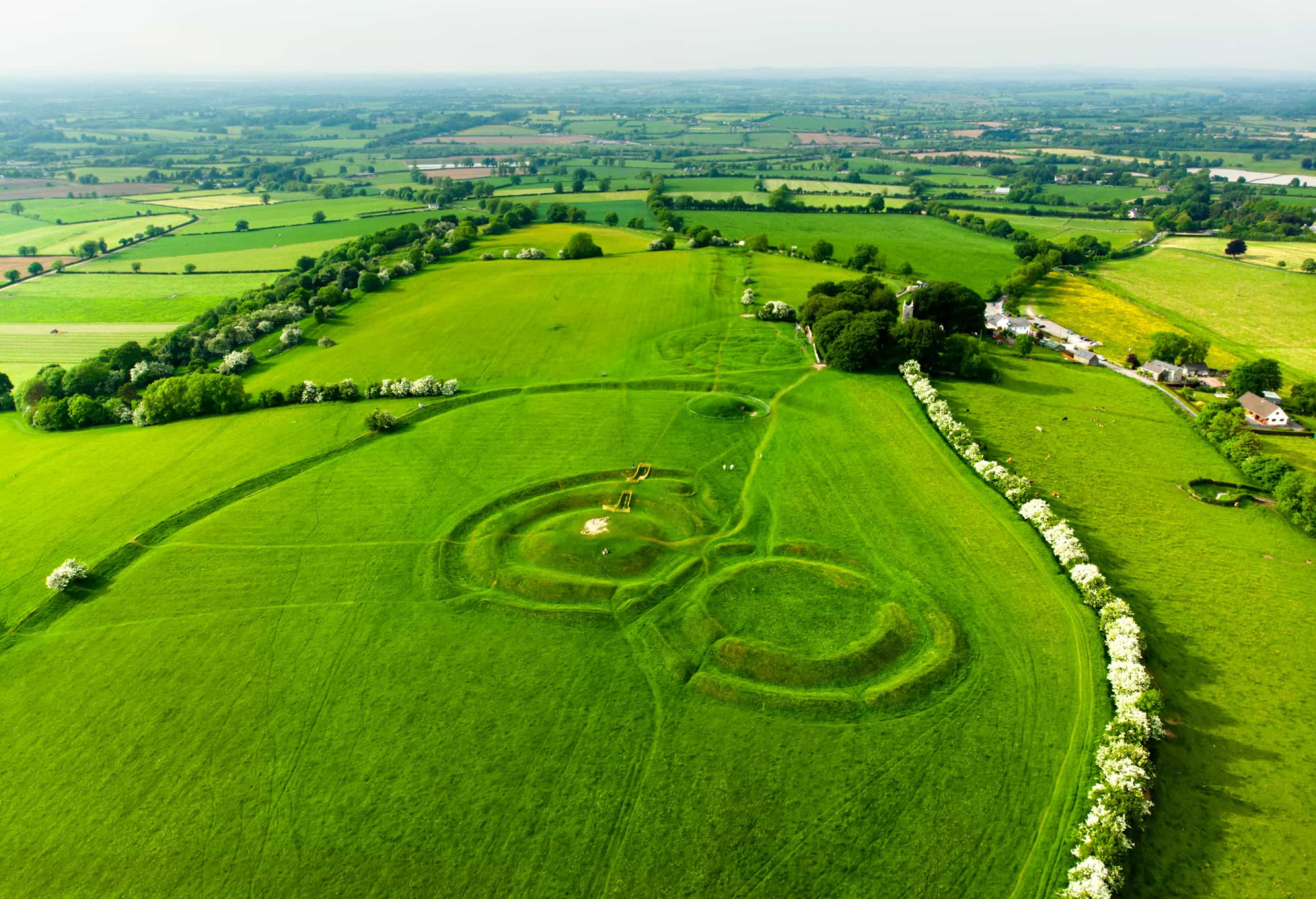
The Irish link
On one occasion, Ireland was considered as the Ark's final destination. The Hill of Tara (pictured), an ancient ceremonial and burial site near Skryne in County Meath, was illegally excavated by British Israelites in the early 20th century in the belief that the hill contained the missing chest.

The Anubis Shrine
Howard Carter's heart must have missed a beat when he entered the Anubis Shrine, part of Tutankhamun's tomb, on November 4, 1922. Already in awe of the treasures he and his team had stumbled upon, there in front of him was something that resembled the Ark of the Covenant. In fact, it was the wood, plaster, lacquer, and gold leaf Anubis Shrine. No matter though. Carter was about to discover an equally momentous archaeological find—Tutankhamun himself!
You may also like: The history of mass extinction events on Earth
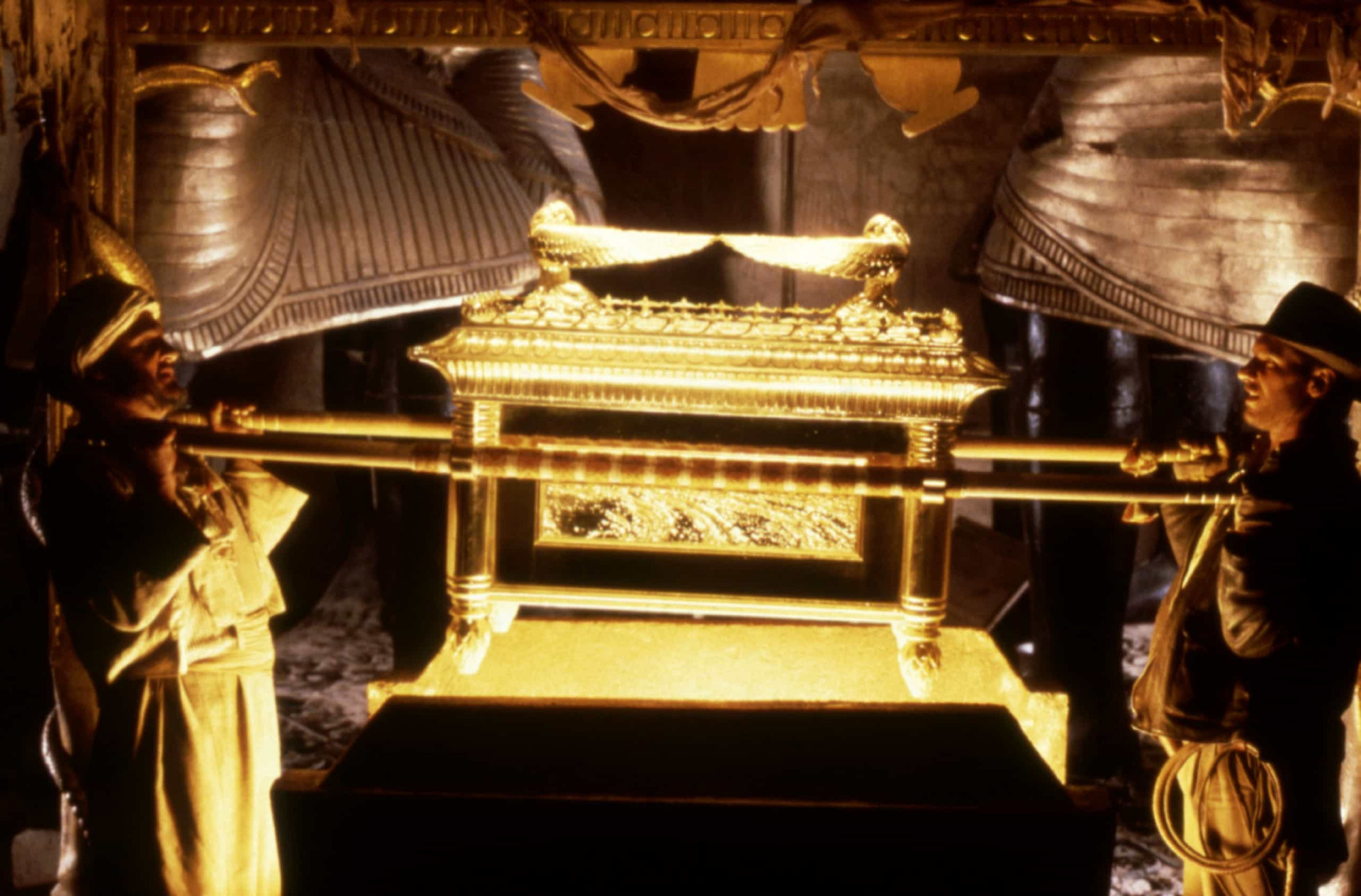
'Raiders of the Lost Ark' (1981)
Arguably the most famous quest for archaeology's most misplaced box was on the big screen. In the 1981 movie 'Raiders of the Lost Ark,' Indiana Jones (Harrison Ford) is hired by the US government to find the Ark of the Covenant before Adolf Hitler's Nazis can obtain its awesome powers.
Sources: ( Book of Exodus ) ( Book of Joshua ) ( National Geographic ) ( Newgrange )
See also: Decoding the symbolism of Freemasonry .
More for You
Stephen King Election Remark Takes Internet By Storm
My Grandma’s 4-Ingredient Brownies Are the Only Thing I’ll Bring to a Potluck
'I was a millionaire before I did Terminator': Arnold Schwarzenegger told Grant Cardone how he made millions before becoming a movie star — and it wasn’t from bodybuilding
12 States Are Banning the Sale of Gas-Powered Cars
Nearly half of master’s degree programs leave students financially worse off—and just one subject results in a starting salary over $100k
Mother who ignored her kids at half-marathon finish line speaks out against critics
Speaker Johnson says the Supreme Court should step in
The Best And Worst Hot Dogs At The Grocery Store, Ranked By Nutritionists
Northern Lights Could Return Tonight in Some US States
A 50-year-old man used an obscure IRS rule to withdraw $20K a year from his retirement savings — without any penalty. Here's how
20 Highest-Paying Jobs in Healthcare
Why Aren't More People Driving Electric Cars? An EV Expert Weighs In
Trump trial ends with ‘prison’ clash: Judge hits lawyer for telling jury about Trump in a cell
Sen. Joe Manchin Leaves Democratic Party
Supreme Court Justice Tells Judge How To Hear New NRA Case
"The First Time I Visited The US I Thought This Was A Restaurant Scam": Non-Americans Are Sharing The Things That Are Totally Common In The US But Bizarre In Other Countries
Our 20 Most Popular Dinner Recipes of All Time
Aerospace startup uses long-forgotten design to crack the code on all-electric long-distance flights — here are the features that make it possible
A millennial couple bought an abandoned cottage for half the price of nearby houses. It's a major fixer-upper, but it's worth it.
Harrison Butker and Rashee Rice among Kansas City Chiefs invited to White House for Super Bowl celebration
The Journeys Of The Ark Of The Covenant Sample
A Song of Ascents. Lord, remember David And all his afflictions; How he swore to the Lord, And vowed to the Mighty One of Jacob: “Surely I will not go into the chamber of my house, Or go up to the comfort of my bed; I will not give sleep to my eyes Or slumber to my eyelids, Until I find a place for the Lord, A dwelling place for the Mighty One of Jacob.” Behold, we heard of it in Ephrathah; We found it in the fields of the woods. Let us go into His tabernacle; Let us worship at His footstool. Arise, O Lord, to Your resting place, You and the ark of Your strength. Let Your priests be clothed with righteousness, And let Your saints shout for joy. For Your servant David’s sake, Do not turn away the face of Your Anointed. The Lord has sworn in truth to David; He will not turn from it: “I will set upon your throne the fruit of your body. If your sons will keep My covenant And My testimony which I shall teach them, Their sons also shall sit upon your throne forevermore.” For the Lord has chosen Zion; He has desired it for His dwelling place: “This is My resting place forever; Here I will dwell, for I have desired it. I will abundantly bless her provision; I will satisfy her poor with bread. I will also clothe her priests with salvation, And her saints shall shout aloud for joy. There I will make the horn of David grow; I will prepare a lamp for My Anointed. His enemies I will clothe with shame, But upon Himself His crown shall flourish.” (Ps. 132)
2 Samuel 6:12-17. After hearing that the Lord had blessed the house of Obed-Edom, King David brought the Ark of the Covenant to Jerusalem. This time the the Ark was transported correctly, on the shoulders of the Levite priests. David placed the Ark inside the tent which he had pitched for it in the city of David.
2 Samuel 7:1-29. David desired to build a house for the Ark of the Lord, but God would not let David build a temple for Him. God promised David that from his descendants, one of his sons would build a house (temple) for the Lord’s Name.
2 Samuel 15:25, 29. David fled from Jerusalem from his son Absalom; Zadok the priest followed David with the Ark of the Lord. David ordered Zadok to return the Ark of the Lord back into the city; Zadok and Abiathar carried the Ark of the Lord back to Jerusalem again, and there it stayed.
1 Kings 8. King Solomon built the temple of the Lord and had the Ark of the Covenant brought from the city of David to the innermost room in the temple, the Holy of Holies. There the Ark of the Lord found its resting place.
2 Chronicles 34:14-35:3. Josiah, king of Judah, heard that the law book of the Lord was found and He had the holy Ark placed back in Solomon’s temple.
2 Samuel 6:12-17
2 Samuel 7:1-29
2 Samuel 15:25-29
2 Chronicles 34:14
About this Plan

The Ark of the Covenant of the Lord was built at the foot of Mount Sinai. After the Ark and the Holy of Holies were made, the journeys of the Ark of the Covenant began, described in two ways: from Mount Sinai to the land ...
We would like to thank Raymond Lombard Ministries for providing this plan. For more information, please visit: https://www.raymondlombard.com/
Related Plans

The Essential 100® Bible Challenge–7–The Rise Of Israel
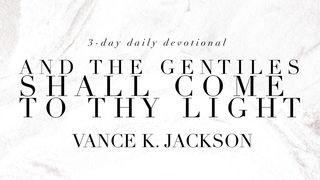
And The Gentiles Shall Come To Thy Light

Generous Evangelism
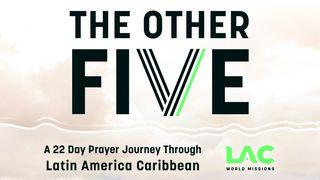
The Other Five Prayer Journey
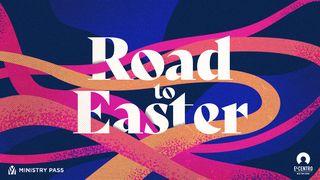
Road to Easter

The Essential 100® Bible Challenge–18–Paul To The Leaders
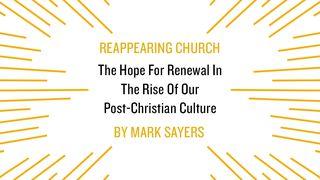
Reappearing Church - A 3 Day Plan

Great You Are Devotional by Jordan Smith

The Power of a United Family Identity
YouVersion uses cookies to personalize your experience. By using our website, you accept our use of cookies as described in our Privacy Policy
105 episodes
Men of Conviction is a podcast designed for men that want to step into the best version of themselves. Society wants you complacent and distracted. But you know that you are meant for more. You are meant to have great relationships, pursue passions, and be the best husband, father, and man that you can be.
Men of Conviction Men of Conviction
The ultimate test of faith.
🎙️ Men of Conviction Podcast: Genesis 22 - The Sacrifice of Isaac and the Ultimate Test of Faith 🎧 Join us in this profound and moving episode of Men of Conviction as we delve deep into the sacred text of Genesis 22 from the Bible. In this episode, we explore the heart-wrenching story of Abraham's willingness to sacrifice his son, Isaac, as an ultimate test of faith. 🔥 Embark on a spiritual journey, a reflection on unwavering faith, obedience, and the profound lessons within this remarkable narrative. 💡 Key Topics Discussed: - The divine command: We unravel the moment when God tested Abraham's faith by commanding him to offer his beloved son, Isaac, as a sacrifice. - Abraham's unwavering faith: Delve into the depth of Abraham's faith and obedience as he set out on the journey to Mount Moriah, trusting in God's ultimate plan. - The providential ram: Explore the miraculous intervention on Mount Moriah, where God provided a ram as a substitute sacrifice, sparing Isaac's life. - Lessons for today: Engage in a discussion on the enduring lessons found in Genesis 22, from the profound trust and obedience displayed by Abraham to the ultimate providence of God in times of testing. 🌟 Join our community of Men of Conviction as we navigate the powerful and moving story of Genesis 22, reflecting on unwavering faith and obedience in the face of unimaginable trials. Tune in to this enlightening episode that invites meaningful reflection and a deeper understanding of the profound lessons within this biblical narrative. 🎧 Subscribe on YouTube: https://www.youtube.com/@menofconvictionpodcast Listen on your favorite podcast platform: https://podcasts.apple.com/us/podcast/men-of-conviction/id1647597573 Be sure to subscribe to our podcast for weekly episodes dedicated to empowering men to live purposefully and with conviction. 📣 Let's engage in respectful conversation! Share your thoughts, experiences, and insights on the story of Abraham and Isaac in Genesis 22, the tests of faith in your own life, and the enduring message of trust in God's providence in the comments section below. Together, let's find inspiration and strength in this timeless tale. #MenOfConviction #Genesis22 #UltimateTestOfFaith #DivineProvidence #PodcastEpisode
Lessons from Abraham and Sarah's Journey of Faith
🎙️ Men of Conviction Podcast: Genesis 20-21 - Lessons from Abraham and Sarah's Journey of Faith 🎧 Join us in this enlightening episode of Men of Conviction as we journey through the pages of Genesis 20-21 from the Bible. We dive into the remarkable story of Abraham and Sarah, exploring their journey of faith, trust in God, and the profound lessons embedded in their experiences. 🔥 Embark on a spiritual odyssey, a reflection on faith, trust, and the fulfillment of God's promises. 💡 Key Topics Discussed: - Abraham and Sarah's journey: We unravel the narrative of Abraham and Sarah, their sojourn in Gerar, and the challenges they faced as they continued to trust in God's promises. - The test of faith: Delve into the tests of faith that Abraham and Sarah encountered on their journey, including Abraham's decision to present Sarah as his sister, and the subsequent divine intervention. - The birth of Isaac: Explore the miracle of the birth of Isaac, the fulfillment of God's promise, and the joy it brought to Abraham and Sarah in their old age. - Lessons for today: Engage in a discussion on the timeless lessons found in Genesis 20-21, from the importance of unwavering faith and trust in God to the fulfillment of promises in unexpected ways. 🌟 Join our community of Men of Conviction as we navigate the story of Abraham and Sarah, drawing inspiration from their journey of faith. Tune in to this enlightening episode that invites meaningful reflection and a deeper understanding of the enduring power of faith and trust in God. 🎧 Subscribe on YouTube: https://www.youtube.com/@menofconvictionpodcast Listen on your favorite podcast platform: https://podcasts.apple.com/us/podcast/men-of-conviction/id1647597573 Be sure to subscribe to our podcast for weekly episodes dedicated to empowering men to live purposefully and with conviction. 📣 Let's engage in respectful conversation! Share your thoughts, experiences, and insights on the story of Abraham and Sarah, their journey of faith, and the lessons we can glean from their experiences in the comments section below. Together, let's find inspiration and strength in this timeless tale. #MenOfConviction #AbrahamAndSarah #JourneyOfFaith #DivinePromises #PodcastEpisode
- 28 SEPT 2023
Exploring Lessons in Righteousness and Divine Judgment
🎙️ Men of Conviction Podcast: The Story of Sodom and Gomorrah - Exploring Lessons in Righteousness and Divine Judgment 🎧 Join us in this thought-provoking episode of Men of Conviction as we delve into the powerful and cautionary tale of Sodom and Gomorrah from the Bible. In this episode, we explore the story's themes of righteousness, divine judgment, and the enduring lessons it offers. 🔥 Embark on a journey of moral reflection, divine justice, and the timeless relevance of this biblical narrative. 💡 Key Topics Discussed: - The city of Sodom and Gomorrah: We set the stage by examining the historical context and the prevailing moral climate of these ancient cities. - The visitation of angels: Discover the pivotal moment when divine messengers visited Lot and the moral contrast they encountered in Sodom. - Divine judgment: Delve into the consequences of the cities' wickedness, the rescue of Lot's family, and the destruction that followed as an act of divine judgment. - Lessons for today: Engage in a discussion on the enduring lessons from the story of Sodom and Gomorrah, exploring themes of righteousness, hospitality, and the consequences of moral decay in society. 🌟 Join our community of Men of Conviction as we navigate the story of Sodom and Gomorrah, exploring its profound moral and spiritual implications. Tune in to this enlightening episode that invites meaningful reflection and a deeper understanding of the consequences of our choices. 🎧 Subscribe on YouTube: https://www.youtube.com/@menofconvictionpodcast Listen on your favorite podcast platform: https://podcasts.apple.com/us/podcast/men-of-conviction/id1647597573 Be sure to subscribe to our podcast for weekly episodes dedicated to empowering men to live purposefully and with conviction. 📣 Let's engage in respectful conversation! Share your thoughts, experiences, and insights on the story of Sodom and Gomorrah, its relevance in today's world, and the importance of righteousness and moral integrity in the comments section below. Together, let's uncover the timeless wisdom embedded in this cautionary tale. #MenOfConviction #SodomAndGomorrah #Righteousness #DivineJustice #PodcastEpisode
- 26 SEPT 2023
From the Tower of Babel to the Journey of Abram
🎙️ Men of Conviction Podcast: From the Tower of Babel to the Journey of Abram - A Tale of Humanity's Quest for Purpose and Faith 🎧 Join us in this captivating episode of Men of Conviction as we embark on a journey through two profound narratives from the Bible: the story of the Tower of Babel and the remarkable journey of Abram (later known as Abraham). We delve into these timeless stories that reflect humanity's quest for purpose, faith, and divine guidance. 🔥 Embark on a spiritual odyssey, an exploration of human ambition and the transformative power of faith. 💡 Key Topics Discussed: - The Tower of Babel: We unravel the story of the Tower of Babel, where humanity sought to build a tower that reached the heavens. Explore the themes of ambition, unity, and the consequences of misplaced priorities. - The Journey of Abram: Delve into the extraordinary journey of Abram, who heeds the call of God to leave his homeland and embark on a faith-filled journey to an unknown land. Reflect on the themes of faith, obedience, and the covenant between God and Abram. - Lessons for today: Engage in a discussion on the enduring lessons found in these narratives, from the importance of humility and alignment with divine purpose to the transformative power of faith in life's journeys. 🌟 Join our community of Men of Conviction as we navigate the stories of the Tower of Babel and Abram, exploring the human quest for purpose and the transformative journey of faith. Tune in to this enlightening episode that invites meaningful reflection and a deeper understanding of our own spiritual odysseys. 🎧 Subscribe on YouTube: https://www.youtube.com/@menofconvictionpodcast Listen on your favorite podcast platform: https://podcasts.apple.com/us/podcast/men-of-conviction/id1647597573 Be sure to subscribe to our podcast for weekly episodes dedicated to empowering men to live purposefully and with conviction. 📣 Let's engage in respectful conversation! Share your thoughts, experiences, and insights on these two biblical narratives, their relevance in today's world, and your own spiritual quests in the comments section below. Together, let's uncover the wisdom and inspiration found in these timeless tales. #MenOfConviction #TowerOfBabel #AbramJourney #FaithAndPurpose #PodcastEpisode
- 19 SEPT 2023
The Story of Noah and the Ark - A Journey of Faith and Covenant
🎙️ Men of Conviction Podcast: The Story of Noah and the Ark - A Journey of Faith and Covenant 🎧 Join us in this inspiring episode of Men of Conviction as we delve into the timeless story of Noah and the ark from the Bible. We present heartfelt readings of the biblical passages and engage in a thought-provoking discussion on Noah's divine direction to build the ark, the challenging time spent on the ark, and the covenant of faith made between God and Noah. 🔥 Embark on a spiritual journey, a celebration of faith, resilience, and the enduring promise of God's covenant. 💡 Key Topics Discussed: - Divine direction to build the ark: We explore the remarkable account of God's instruction to Noah to build the ark, a vessel of salvation amidst a world engulfed by a flood. Reflect on Noah's unwavering faith and obedience. - Time spent on the ark: Delve into the challenges and trials faced by Noah, his family, and the animals during their time on the ark. Discover the resilience and trust in God that sustained them through the floodwaters. - The covenant of faith: Engage in a discussion on the profound covenant made between God and Noah after the waters receded, symbolized by the rainbow. Reflect on the enduring promise of God's faithfulness and the restoration of creation. - Lessons for today: Explore the timeless lessons found in the story of Noah and the ark, from the importance of unwavering faith and obedience to the enduring nature of God's covenants with His people. 🌟 Join our community of Men of Conviction as we celebrate the faith, resilience, and enduring promise showcased in the story of Noah and the ark. Tune in to this enlightening episode that invites meaningful reflection and a deeper understanding of God's faithfulness in times of trial. 🎧 Subscribe on YouTube: https://www.youtube.com/@menofconvictionpodcast Listen on your favorite podcast platform: https://podcasts.apple.com/us/podcast/men-of-conviction/id1647597573 Be sure to subscribe to our podcast for weekly episodes dedicated to empowering men to live purposefully and with conviction. 📣 Let's engage in respectful conversation! Share your thoughts, experiences, and insights on the story of Noah and the ark, faith in challenging times, and the enduring promises of God in the comments section below. Together, let's find inspiration and strength in this timeless narrative. #MenOfConviction #NoahAndTheArk #FaithAndCovenant #BiblicalStory #PodcastEpisode
- 14 SEPT 2023
Exploring Cain and Abel, Divine Consequences, and the Lineage of Faith
🎙️ Men of Conviction Podcast: Genesis 4-5 - Exploring Cain and Abel, Divine Consequences, and the Lineage of Faith 🎧 Join us in this profound episode of Men of Conviction as we delve into the sacred texts of Genesis 4 and 5 from the Bible. We present heartfelt readings of these chapters and engage in a thought-provoking discussion on the birth of Cain and Abel, the jealousy that arose between them, the divine consequences that followed, and the remarkable lineage detailed in chapter 5. 🔥 Embark on a spiritual journey, a reflection on the complexities of human relationships, divine justice, and the enduring legacy of faith. 💡 Key Topics Discussed: - The birth of Cain and Abel: We explore the biblical account of the birth of Cain and Abel, highlighting the differing offerings they presented to God and the jealousy that ensued. - Jealousy and consequences: Delve into the consequences of Cain's jealousy, including God's admonition and the curse placed upon him. Reflect on the themes of accountability and divine justice. - The lineage of faith: Engage in a discussion on the remarkable lineage detailed in Genesis 5, tracing the descendants of Adam and Seth and emphasizing the legacy of faith passed down through the generations. - Lessons for today: Reflect on the timeless lessons found in these biblical passages, from the complexities of sibling relationships to the consequences of our actions and the importance of faith in shaping our legacy. 🌟 Join our community of Men of Conviction as we unravel the profound stories of Genesis 4 and 5, reflecting on the intricacies of human relationships, divine justice, and the enduring power of faith. Tune in to this enlightening episode that invites meaningful contemplation and a deeper understanding of the complexities of the human experience. 🎧 Subscribe on YouTube: https://www.youtube.com/@menofconvictionpodcast Listen on your favorite podcast platform: https://podcasts.apple.com/us/podcast/men-of-conviction/id1647597573 Be sure to subscribe to our podcast for weekly episodes dedicated to empowering men to live purposefully and with conviction. 📣 Let's engage in respectful conversation! Share your thoughts, experiences, and insights on the stories of Cain and Abel, divine consequences, and the lineage of faith in the comments section below. Together, let's seek wisdom and inspiration in these foundational biblical narratives. #MenOfConviction #Genesis4And5 #SiblingRivalry #DivineJustice #LegacyOfFaith #PodcastEpisode
- © Men of Conviction
Top Podcasts In Education
- Skip to main content

EXTRA! Ideas for Adults – Promises We Can Count On – Session 2
May 27, 2024 By Lynn Pryor Leave a Comment

Date: June 9, 2024

God’s Promise of Preservation
The point: god promised to preserve his creation., get into the study.
Begin the study by discussing Question #1, then share the following information.
Spring weather has been hard on several areas of the United States. In early May, torrential rains inundated Southeast Texas, producing flooding that rivaled Hurricane Harvey, and required hundreds to be rescued from their homes. Then, later in the month of May, a band of tornados swept across the Midwest and South, with nine tornados confirmed in Middle Tennessee alone. Finally, Omaha, Nebraska experienced four to eight inches of rain in a forty-eight-hour period that produced significant flooding in the Omaha area. With weather like that, it would not be surprising to find some folks looking for Noah and the Ark.
Call attention to The Point: “ God promised to preserve His creation ” and say, “Thankfully, as we study today’s passage, we will see that God has given us a promise to preserve His creation. While there might be natural disasters that affect our world, God is still in charge and God’s promises are true.
Continue with the introductory discussion by summarizing the information found in The Bible Meets Life.
- https://weather.com/news/weather/news/2024-05-02-houston-flash-flooding-texas
- https://www.newschannel5.com/news/may-8th-tornado-damage
- Omaha area rain totals: Severe storms drop torrential rainfall, lead to flooding Tuesday morning (wowt.com)
Get Into the Study [Option from the Adult Leader Guide]
In advance, play a video clip of a scene from a natural disaster. Then ask Question #1.
Study the Bible [Option from the Daily Discipleship Guide Leader Guide]
As part of your discussion around Genesis 9:4-7 and how God affirms the value of human life, take time to examine information on what things cost in years past versus what they cost now. Use this link to talk about how the value of things has changed over the years but the value of human life never changes.
Live It Out

As you discuss the “Live It Out” section, share the following information.
God has promised to preserve His creation. That is a promise, but have you considered what your responsibility might be in that preservation? Many Southern Baptist have chosen to live out that responsibility through Disaster Relief ministries. Almost every state convention has an organization that responds when natural disasters occur. In the past, Baptist Disaster Relief (DR for short) responded to Hurricanes Katrina, Sandy, Harvey, and other storms. DR was also visible at the Twin Towers after 9/11, offering aid and support. On a regular basis, volunteers respond to meet needs, comfort, and share the Gospel with hurting people. In addition to chainsaws, food preparation and construction, DR chaplains accompany each team.
For example, in the past three months, the Arkansas Baptist State Convention DR has responded by donating and transporting hay to farmers and ranchers in the fire-stricken areas in the West. They deployed to Oklahoma when twenty-seven tornados swept through the state, and to Houston, Texas to assist with flood relief. This is an example of just one state convention’s efforts. Other states are just as involved and ready to serve.
Say: While you may not be interested in or able to be a part of this kind of ministry, all believers are called to live out their faith by serving others. God’s covenant with Noah is also His covenant with us.
- https://www.sendrelief.org/focus-areas/respond-to-crisis/
- https://arkansasbaptist.org/post/sbtc-disaster-relief-gives-a-huge-thank-you-to-arkansas-baptists-for-hay-donations/
- https://arkansasbaptist.org/post/abdr-teams-deploy-to-oklahoma/
- https://arkansasbaptist.org/post/abdr-deploys-to-texas/
Lynn Riley is retired from the Arkansas Baptist State Convention, where he served as a team member in the areas of evangelism and church health. He and his wife Cheryl live in Smyrna, Tennessee and are active members of Rolling Hills Community Church in Nolensville, Tennessee. They are spending their retirement years serving their church and spoiling grandkids.
Additional Questions
- When are new beginnings positive and when are they negative?
- What’s the closest you’ve ever come to living through a natural disaster and how did you respond?
- Which type of natural disaster would you be the most fearful to experience and why?
- When have you witnessed a natural disaster?
- What’s the closest you’ve come to a natural disaster? How has that moment impacted you?
- What’s a new journey you’re especially glad you got to start? (BG)
Genesis 9:1-3
- How do God’s words to Noah remind you of His covenant with Adam?
- What does it mean to be “fruitful and multiply” and what does that look like in application for your life?
- How does God’s interaction with Noah give you hope?
- What responsibilities come alongside the authority God gives to Noah’s family?
- When has God reaffirmed a promise in your life?
Genesis 9:4-7
- What can we do as Christians to ensure dignity for all human beings?
- In what ways do God’s promise and God’s warning demonstrate His attitude toward human life?
- What opportunities do you have, in your everyday circumstances, to be a protector and preserver of life?
- What does this passage reveal about what God values?
- What responsibilities do we have for preserving the lives of others?
- What are some ways our actions can fail to value human life?
- Where do you see the value of human life being threatened today?
Genesis 9:8-13
- What does God reveal about Himself with this covenant? How should that influence how we relate to Him?
- How does it make you feel to know that God keeps his covenant with you?
- How does God’s covenant with creation influence how we should relate to creation?
- How can this promise impact the way you pray for others?
- Where do you see God’s grace and mercy in these promises?
- How would you summarize the provisions of the covenant described in these verses?
For Those in Your Group
Send the following link to your group members as either a teaser before the group meets or as a follow-up thought:
The Beauty of God’s Faithfulness

Magazine Article
This article complements the study. Share this link with your group members.
HomeLife – So Far Beyond Us
Click here for a 20-minute podcast for both the group member and the leader.
Podcast (adultsleadertraining): Play in new window | Download
Subscribe: Spotify | TuneIn | RSS
Reader Interactions
Leave a reply cancel reply.
Your email address will not be published. Required fields are marked *
Indiana Jones Movies in Order Chronologically and by Release Date
Indiana Jones and the Dial of Destiny marked the final film in the iconic series, so here's how to watch the films in chronological and release order.
The Indiana Jones film series has made a big impact on popular culture. Almost everyone has heard of the archeologist and his dangerous adventures, even if they haven’t actually seen the movies. As well as being paid homage to and parodied a number of times in various forms of media, the series has also inspired other similar fictional treasure-hunting-themed franchises, such as Laura Croft, The Mummy , and, more recently, Uncharted.
Over 42 years, five Indiana Jones films have been released, with the latest being 2023's Indiana Jones and the Dial of Destiny. Within the fictional world, however, the story takes place over a 34-year period, with the in-universe chronology and release dates not quite matching one-to-one. While on the surface, it would seem the Indiana Jones movies are a bit easy to follow, unlike Star Wars , they have no numerical numbering to give them an immediate recognizable placement in a timeline other than when you start the movie, and it shows the date.
Indiana Jones and the Dial of Destiny marked the final film in the franchise, as Harrison Ford has retired from the part. All the titles are available on Disney+, so anyone looking for a binge-worthy weekend can lay back and watch the epic five-film saga. Here's a look at the Indiana Jones films in both chronological order and by release date.
Update January 5, 2024: This article has been updated following the release of Indiana Jones and the Dial of Destiny , and the entire series is now available to stream on Disney+.
The Indiana Jones Movies in Chronological Order
- Indiana Jones and the Temple of Doom
- Raiders of the Lost Ark
- Indiana Jones and the Last Crusade
Indiana Jones and the Kingdom of the Crystal Skull
Indiana jones and the dial of destiny, indiana jones and the temple of doom (1984), indiana jones & the temple of doom.
Indiana Jones and the Temple of Doom may have been the second film to be released, but it technically takes place in 1935, before the events of Raiders of the Lost Ark . Indiana Jones survives an assassination attempt and flees Shanghai with a young orphan named Short (Ke Huy Quan), along with a nightclub singer named Willie (Kate Capshaw). When they find themselves aboard a plane piloted by the bad guy's henchmen, a plane that is crashing towards the ground, Indy and his companions barely manage to make it out alive. Eventually, they wind up in the village of Mayapore in northern India.
However, it's not long before the trio runs into more problems. A sacred stone belonging to the people of the village was stolen, along with their children, and they implored Indy to help them. He agrees and travels to the palace they believe the stolen children are beng housed in, only to be welcomed with open arms. That is, until another assassin tries to kill Indy in his sleep. Managing to survive the night, Indy discovers that there are hidden tunnels under the palace, and begins to explore them. There he discovers a hellish place filled with cultists conducting a human sacrifice. Indy must save himself, his companions, and the children before a trance-like state forces him to offer himself for sacrifice.
Related: Best (And Worst) Indiana Jones Moments, Ranked
Often considered inferior to its predecessor, The Temple of Doom is darker and grimier than the rest of the films in the series and could easily be mistaken for a horror film . Nevertheless, the set pieces and production design are nothing short of spectacular, and Ford is in as fine a form as ever. The movie was so dark it, along with the Gremlins which was released the same year, that the MPAA created the PG-13 rating. This would be the final PG-rated Indiana Jones adventure, as all the following ones would be PG-13. Stream on Disney+ and Paramount+.
Raiders of the Lost Ark (1981)
Raiders of the lost ark.
Raiders of the Lost Ark starts with Indiana Jones retrieving a gold idol from a trapped temple in 1936, which comprises one of the best action sequences of all time . He runs right from one life-threatening situation into another, as a rival archaeologist, Belloq (Paul Freeman), is waiting for him and steals the idol. Upon his return to the US, two army intelligence agents confront Indy, and in a debrief, he discovers that the Nazis are searching for the Ark of the Covenant. The agents recruit him to find the Ark before the Nazis do.
The first stop on his journey leads him to Nepal, where he meets an old flame, Marion (Karen Allen). She has a medallion that, once translated, will detail how to find the ark. Unsurprisingly, it doesn't take long for the Nazis to show up and attempt to steal it from her. As she flees with Indy, the Nazis continue to chase them. Upon learning from his friend, Sallah (John Rhys-Davies), that Belloq is assisting the Nazis with a dig in Cairo, Indy realizes that his enemies have been digging in the wrong place. With Sallah's assistance, Indy recovers the Ark, but Belloq quickly seizes it. However, when Belloq and the Nazis open the Ark, they soon discover its true deadly power.
The only film in the series not to start with "Indiana Jones and the...", Raiders of the Lost Ark , is considered by many to be one of the greatest movies of all time. Not only did it solidify Harrison Ford as a movie star and more than just Han Solo, it made George Lucas and Steven Spielberg even bigger power players in the industry than ever before. The movie set the template not just for the franchise but also for various other action movies. Stream on Disney+ and Paramount+.
Indiana Jones and the Last Crusade (1989)
Indiana jones & the last crusade.
The opening scenes of Indiana Jones and the Last Crusade , take place in 1912 (before the film continues into 1938 for the rest), when an old foe is given a backstory. A young Indiana Jones initially tries to recover a golden cross being stolen by a couple of grave robbers. He eventually catches up to them and manages to successfully put the cross in a museum. Upon returning home, Indy discovers that his dad, Henry Jones Sr. (played by the legendary Sean Connery) has disappeared while searching for the Holy Grail.
With his dad’s grail diary in hand and the assistance of Jones Sr.'s former colleague, Elsa (Alison Doody), Indy sets out on the journey to rescue his father. Together, Indy and Elsa, begin to piece the puzzle of Henry's whereabouts. However, they eventually come across two problems. The first is a secret society known as the Brotherhood of the Cruciform Sword, who are tasked with keeping the grail safe. The second is the Nazis, who are also desperate to get their hands on the prized artifact, meaning there are now two enemies for Indy to contend with.
Related: Every Indiana Jones Movie, Ranked
Indiana Jones and the Last Crusade marked a return to the lighthearted tone of the first film, with the chemistry between Ford and Connery (who was only 12 years older than Ford) providing some excellent comedy. Connery's casting is a meta casting joke, as Indiana Jones was inspired by Spielberg always wanting to make a James Bond movie but being rejected and Lucas famously saying he had something better, Indiana Jones (well, Indiana Smith at the time, but the name thankfully was changed). In Spielberg's mind, it only made sense to cast James Bond as the father of Indiana Jones.
Audiences responded better to the movie than Temple of Doom , and the third film in the series is largely considered one of the best. It would also be the last film in the franchise for 19 years. Fans kept asking Spielberg about making a fourth film, and despite his intending Last Crusade to be the final film, he could not resist and returned for another adventure. Stream on Disney+ and Paramount+.
Indiana Jones and the Kingdom of the Crystal Skull (2008)
Released nearly two decades after the last Indiana Jones movie, Indiana Jones and the Kingdom of the Crystal Skull fittingly takes place in 1957, almost 20 years from when The Last Crusade is set. Of course, instead of being another World War 2-era movie where Nazis are the enemies, this time, it is the KGB who are causing Indy all kinds of problems and dropping the famous hero in the middle of the Cold War. After being kidnapped by Soviet agents and taken to a secret bunker in Nevada, Indy is forced to help them find a mummified alien. His attempts to stop them are unsuccessful, though, and he barely manage to make it out alive. Later, he is approached by a man named Mutt Williams (Shia LeBeouf), who claims the KGB has kidnapped more people in search of the crystal skulls.
Indy and Mutt team up and travel to Peru, narrowly dodging KGB agents along the way. They discover that the KGB want to find more crystal skulls, believing that the skull belongs to an alien life form that will grant them psychic powers if they collect enough. With powers like that, the Soviets could telepathically control the world. Indy must stop the KGB with the help of both old and new colleagues alike.
While it is widely considered the weakest film in the franchise, at the time, audiences and critics responded positively to the film as it grossed nearly $800 million at the box office and, in doing so, became the second highest-grossing release of the year worldwide behind only The Dark Knight . The movie was highly anticipated at the time of its release, as it was the return of the great action hero that fans had been waiting years to see again. The plot was incredibly secretive, and while the reaction to the film has soured as the years went on, there is still a lot to like in this film. Even if it is the weakest, it goes to show that the weakest Indiana Jones film is still better than a lot of other franchises. Stream on Disney+ and Paramount+
Indiana Jones and the Dial of Destiny (2023)
The latest installment in the series, Indiana Jones and the Dial of Destiny , sees the action taking place in 1969, and revolves around an elderly Indy embarking on one last adventure to retrieve a powerful artifact before it falls into the wrong hands. A flashback to 1944 at the start of the film depicts Indy rescuing his friend and colleague Basil Shaw (Toby Jones) from his capture at the hands of the Nazis, and shows him learning of Archimedes' Dial, an ancient Syracusan mechanism supposedly capable of time travel. That means the opening sequence takes place between the events of The Last Crusade and The Kingdom of the Crystal Skull.
Twenty-five years later, Basil's daughter Helena (Phoebe Waller-Bridge) pays Indy a visit, wishing to learn more about the Dial, which her now-deceased father dedicated his life to studying. Indy warns Helena against this, but reluctantly helps her to retrieve one half of the Dial from the college archives. In the process, they are attacked by Nazi astrophysicist Jürgen Voller (Mads Mikkelsen), who now works for NASA and is desperate to get his hands on both halves of the Dial. Helena, who had been lying about her intentions, steals the Dial to sell on the black market. With the help of Sallah, Indy tracks down Helena to Tangier, and the pair decide to team up in order to stop Voller, whose plan, it is revealed, is to travel back in time to kill Hitler and take the position as the leader of the Nazis.
Related: Why Indiana Jones and the Dial of Destiny Deserves Better Than Its Rotten Tomatoes Score
Despite being the first film in the series not to be helmed by Spielberg, there were high hopes for The Dial of Destiny , which was directed by James Mangold. It is fascinating that the time gap between Kingdom of the Crystal Skull and Dial of Destiny was 15 years, just four years shy of the 19-year gap between Last Crusade and Kingdom of the Crystal Skull . Unfortunately, like its immediate predecessor, the film garnered a mixed response from both critics and fans. Unlike Kingdom of the Crystal Skull , however , the fifth entry in the franchise was not a financial success, only managing to make a disappointing $385 million on a $300 million budget and becoming the series' first box office bomb .
It could not exactly cash in on the "Indy is back" hype because Kingdom of the Crystal Skull had used that already. The other part was that the time gap between the release of Raiders of the Lost Ark and The Dial of Destiny is so great that a good portion of the fanbase that started with the original film might sadly no longer be with us. For comparison, the time between Raiders of the Lost Ark and Dial of Destiny is the same as between The Wizard of Oz and Raiders of the Lost Ark . Time is a funny thing, so it is appropriate the final Indiana Jones film is a thoughtful meditation on time as a concept. The series ends not with a big action scene or riding off into the sunset but instead with a hat hanging on a close line and a hand taking it, the idea being there will always be an adventure out there. Stream on Disney+
The Indiana Jones Movies by Release Date
Indiana Jones was always a summer franchise. Both the first and the final film in the series opened in June, a nice bookend for the franchise. Indiana Jones and the Temple of Doom , The Last Crusade , and Kingdom of the Crystal Skull all opened on Memorial Day weekend. While the movies are the perfect summer viewing, they can really be enjoyed anytime of the year.

IMAGES
VIDEO
COMMENTS
The Journey of the Ark of the Covenant. in 1-2 Samuel. 1 Sam. 3:3. The Lord calls to Samuel who is sleeping in the tent of meeting, "where the ark of God was". 1 Samuel 4. Philistines capture the ark (for seven months: 1 Sam. 6:1) 1 Sam. 5:1-7. Philistines bring the ark to Ashdod, setting it up next to the idol Dagon. 1 Sam. 5:8-9.
This map traces the journey of the Ark of the Covenant from the Tabernacle in Shiloh to the City of David in Jerusalem, as described in I Samuel 4:1-7:2 and II Samuel 6:2-17. Shiloh was the home of the Mishkan (Tabernacle) for 369 years. After losing a battle to the Philistines, ...
The journey of the Ark of the Covenant among the Israelites and Philistines is clearly laid out in Scripture, while its disappearance is more ambiguous. We can see this artifact played an important role in biblical history, representing God's presence and helping the Israelites overcome trials. While there's a large gap in Scripture when ...
The Ark's Design was Revealed to Moses on Mount Sinai. The Ark of the Covenant (Heb. Ahrohn HaBreet) was a small wooden box or chest (approx. 3.9 feet by 2.3 feet) that contained the covenant made by the LORD to the people of Israel. God revealed to Moses on Mount Sinai the exact specifications for constructing the Ark.
The Journey of the Ark of the Covenant in 1-2 Samuel. 1 Sam. 3:3. The Lord calls to Samuel who is sleeping in the tent of meeting, "where the ark of God was". 1 Samuel 4. Philistines capture the ark (for seven months: 1 Sam. 6:1 ) 1 Sam. 5:1-7. Philistines bring the ark to Ashdod, setting it up next to the idol Dagon. 1 Sam. 5:8-9.
The Ark of the Covenant. The Ark of the Covenant was constructed in c.1446 BC to hold the two tablets of stone inscribed with the Ten Commandments that were given to Moses by God on Mt Sinai. The guidelines inscribed on the two stone tablets formed part of the solemn covenant agreement (or 'testament') undertaken between the Israelites and God.
One man-made object was considered intrinsically holy - the Ark of the Covenant. Constructed during the Israelites' wanderings in the desert and used until the destruction of the First Temple, the Ark was the most important symbol of the Jewish faith, and served as the only physical manifestation of God on earth.
Ark of the Covenant in the Anikova dish, c. 800. The Ark of the Covenant, [a] also known as the Ark of the Testimony [b] or the Ark of God, [c] [1] [2] is believed to have been the most sacred religious relic of the Israelites. It is described as a wooden chest coated in pure gold and topped off by an elaborate golden lid known as the mercy seat.
The stations of the ark: (a) From Sinai to Shiloh. The Ark of Covenant is a gold-covered wooden chest with lid cover. It housed the two stone tablets of the Ten Commandments that Moses received from God on Mount Sinai (Exodus 24:18): "And Moses went into the midst of the cloud, and gat him up into the mount: and Moses was in the mount forty days and forty nights".
The Ark of the Covenant refers to the box-like container that held the tablets of the Law received by Moses on Mount Sinai. Tradition claimed that it contained two stone tablets, carved by God, listing the first ten commandments given to Israel. The receipt of the tablets and the details of the construction of the Ark appear in the book of Exodus.
According to church leaders, the Ark of the Covenant has for centuries been closely guarded in Aksum at the Church of St. Mary of Zion. Not even the high priest of Aksum can enter its resting chamber. Its sole custodian is a virgin monk who cannot leave the sacred grounds until his death. The Ark's influence, though, is felt throughout the ...
Ark of the Covenant. ARK OF THE COVENANT ( אֲרֹ֣ון הַבְּרִ֔ית, ἡ κιβωτὸ̀ς τῆς διαθήκης; the chest of the testament ). A wooden container, the central object in Israel's preexilic sanctuary. I. Name. The Heb. noun אֲרﯴן, H778, is used 195 times in the OT for the Ark of the covenant. A. Chest.
2 Samuel 6 is a powerful chapter of the Bible that brings to light the glory and holiness of God, and the significance of complete obedience to His laws. The chapter begins with King David's joyous effort to bring the Ark of the Covenant to Jerusalem and ends with a sobering lesson on the consequences of disrespecting God's holiness. Themes. 1.
When the tabernacle was completed, the Ark was eventually placed in the Most Holy Place or the Holy of Holies. Exodus 40:1-3 tells us "Then the Lord said to Moses, 'Set up the Tabernacle on the first day of the new year. Place the Ark of the Covenant inside, and install the inner curtain to enclose the Ark within the Most Holy Place.'". One of the things about the Ark of the Covenant ...
For centuries, people have tried in vain to locate and recover the Bible's most sacred objects. Among the most sought-after of these religious antiquities is the famed Ark of the Covenant.
The Ark did not become a Holy Place until it was placed in the Holy of Holies and the glory of the Lord came to rest upon it (verse 34, 35). Numbers 3:30, 31; 4:2-18. The Ark of the Covenant would be carried exclusively through all its journeys by the Kohathites. In Numbers 10:33 we read of the first journey of the Ark.
6 Days. Sample Day1. The Ark of the Covenant of the Lord was built at the foot of Mount Sinai. After the Ark and the Holy of Holies were made, the journeys of the Ark of the Covenant began, described in two ways: from Mount Sinai to the land of Canaan; and from its arrival in the land of Canaan, until its resting place in the temple in Jerusalem.
The Ark of the Covenant. Exodus 25:10-16; Numbers 4:4-6. The ark was a container, or chest, that was made to the exact specifications given to Moses by the Lord, and was primarily a storage place for the testimony, or Ten Commandments. It was 45 inches long, 27 inches wide, and 27 inches high. It was made of acacia wood, covered with gold ...
Answer. What happened to the Ark of the Covenant is a question that has fascinated theologians, Bible students, and archeologists for centuries. In the eighteenth year of his reign, King Josiah of Judah ordered the caretakers of the Ark of the Covenant to return it to the temple in Jerusalem ( 2 Chronicles 35:1-6; cf. 2 Kings 23:21-23 ).
2 Samuel 6:1-9. David decided to bring the Ark of God to Jerusalem. Uzzah was punished with death because he touched the Ark. David, out of fear of the Lord, let the Ark turn aside into the house of Obed-Edom. The Ark remained in his house for three months (2 Sam. 6:10, 11).
Map 53 The Ark of the Covenant is captured. Aphek. Aphek was an ancient city located on the edge of the Mediterranean coastal plain and the Shephelah - the foothills of the Judaean hills. It was a key staging post on the coastal trading route (the Via Maris) between the ancient civilisations of Egypt and Mesopotamia (see 1 on Map 53).
The Ark of the Covenant in Its Egyptian Context: An Illustrated Journey is the first book to explore the complex history of sacred ritual furniture in Egypt that predated the ark by hundreds of years. Within Egyptian culture, over four hundred examples of ritual furniture exist that shed light on the design and appearance of the ark. ...
The journey Mary took from Nazareth to Judah, where Elizabeth lived, would have been arduous, Father Van Sloun said, stretching over 85 miles of hilly terrain. ... "The Ark of the Covenant kept the most precious and holiest things for the people of Israel, and when they had it in procession, David, as a young man, went in front of it, and he ...
The Ark of the Covenant is a gold-covered wooden chest with lid cover. It's described in the Book of Exodus as containing the two stone tablets of the Ten Commandments. It was made by Bezalel ...
1 Kings 8. King Solomon built the temple of the Lord and had the Ark of the Covenant brought from the city of David to the innermost room in the temple, the Holy of Holies. There the Ark of the Lord found its resting place. 2 Chronicles 34:14-35:3. Josiah, king of Judah, heard that the law book of the Lord was found and He had the holy Ark ...
🔥 Embark on a spiritual journey, a celebration of faith, resilience, and the enduring promise of God's covenant. 💡 Key Topics Discussed: - Divine direction to build the ark: We explore the remarkable account of God's instruction to Noah to build the ark, a vessel of salvation amidst a world engulfed by a flood.
Begin the study by discussing Question #1, then share the following information. Spring weather has been hard on several areas of the United States. In early May, torrential rains inundated Southeast Texas, producing flooding that rivaled Hurricane Harvey, and required hundreds to be rescued from their homes. Then, later in the month of May, a ...
Raiders of the Lost Ark starts with Indiana Jones retrieving a gold idol from a trapped temple in 1936, which comprises one of the best action sequences of all time.He runs right from one life ...